
Well, here it is,finally. The culmination of the Dark Earth Chronicles Series. This article is made up of information that’s been hanging around for a long time, years in some cases, in combination with new information. It all decided to have a party in my head in order to get better acquainted. After the hangover had subsided, what remained is what you are about to read …I hope. When we began this project, neither Felix nor I, imagined that it would still be going three years later, or that it would be the beginning of an even more challenging quest.
Some of the information that will be presented below may seem quite tedious in its detail, but I would ask your indulgence, as ‘the devil is in the detail’, or so they say. If you get too bored then please skip ahead rather than abandoning ship.
If you haven’t read the intermediate Dark Earth Chronicle articles, only the main ones, it shouldn’t be too much of a handicap as, if nothing else, I’m quite good at repeating myself. Anything super-relevant will be given a link to it’s appearance in the previous article anyway.
OK, hold on to your hats, fasten your safety belts and please keep your hands inside the car…
● THE LOST BOOK OF THE GRAIL
○ Sacred Wells and Water Nymphs ○ The Quest Question ○ Quest‑ioning The Grail ○ The Grail Redefined
● THE CATACLYSM ‑ THE BREAKING OF THE GEAS
○ Arthur, Guardian of the North ○ Guinevere ‑ Ælfgifu
● THE CULT OF CHIVALRY AND THE ARTHUR OBSESSION
○ Edward I’s Strange Ritual ○ Arthur’s Crown ○ Edward I’s Round Table ○ Just propaganda then? ○ Arthur, Christian or Pagan hero? ○ The Most Powerful Poison
● PROLOGUE TO THE PROLOGUE
○ Where London Leys ○ Tower Hill and Bran’s Head ○ The Bridewells ‑ Human Zoos ○ Pagan Devotions at Christian Wells ○ Princess Diana
● THE SURVIVAL OF THE 'OLD WAYS' DOWN‑UNDER
○ The Dreamtime ○ The Land as a Living Entity ○ Ancestry ○ Totems ○ Ceremonies ○ Spirit Entities ○ Songlines ○ The Stolen Generations
● AFTER THE CATACLYSM
○ Ownership ○ Isolation of the Forests ○ Demonisation and Slavery ○ Resistance
● T H E E L U C I D A T I O N
○ My Analysis… ○ Logres ○ Timeline ○ The Arch‑Villain ○ The Seven Guardians ○ That’s all a bit Rich ○ So, were The Rich Company defeated or not?
● ARTHUR'S SHAME
○ Guinevere ‘Quest‑ions’ Arthur○ Celtic Tradition and ‘the sister’s son’ ○ The Exhumation of Bran’s head ○ Slothfulness ○ Infidelity?
● HELLO OPERATOR, COULD YOU PLEASE CONNECT ME WITH REALITY?
○ “From the Devil they sprang…” ○ The Rich Plantagenet Company ○ Richard the Lionheart ○ Master Blihis ○ On the trail of Blihos‑Bleheris ○ Cadivor, the Ancestor of Dyfed ○ Carmarthen Castle Traitors ○ The seminal source of the Grail Legends? ○ Too good to waste ○ Bilious‑Bill from another point of view…
● SPECULATING AND HALLUCINATING
○ The Hidden Logres ○ That Melusine again ○ Hidden in plain sight ○ Melusine’s Supernatural Constructions ○ The Location of Logres ○ The Rich NormanVCompany
● THE COURAGE OF ONES CONVICTIONS
○ Those Ælfgifus again… ○ King Cnut ○ Ælfgifu down on the Bayeux ○ Christianity arrived with The Feudal System
● FRANKLY REMARKABLE
○ Biblical France ○ Paris ○ Holy Relics Batman! ○ Crusade ‑ Cruciare, “to mark with a cross"
● SO, DID THE JESUS THING HAPPEN IN FRANCE?
○ Pre‑Christian Christs ○ The Big Difference ‑ Suffering
● THERE’S CLEARLY SOMETHING ELSE GOING ON HERE
○ The Not‑so‑Old Testament
● A NEW SONG ON THE EARTH’S SACRED NETWORK
○ The Western European Network ○ So, what happens at the other end? ○ Jerusalem Syndrome ○ The Well of Souls ○VSongs on the Leys ○ The Great Transference ○ Flat Earth Leys
● LOGRES, THE LAND OF PLENTY
● CONJURING THE PAST
○ Those Questions Again… ○ The Knights of the Temple ○ Supernatural Constructors again…
● THE PAST CONJURED, OR MY INKLING
○ Is knowledge of the Grail the ultimate weapon? ○ Conclusion
In an earlier article, 'The Grail, The Cataclysm,The Wasteland and Our Lost Ancient Sovereignty', I examined the Grail legends for a link between the cataclysm (Wasteland) and the Sovereignty of the Land – I wasn’t disappointed. Since then I realised that my neglect in not focusing on one particular, seemingly insignificant ‘legend’, was a huge mistake and one that I intend to rectify in this article.
The particular version of the Grail Quest I’m referring to is known as ‘The Elucidation’ and claims to be a prologue, or introduction, to the entire Grail Quest. We will be examining it in greater detail later. One major difference between it and all the other versions, is that the Fisher King is neither wounded nor incapacitated in any way. Furthermore, he is portrayed as a magician or sorcerer complete with the power of shape-shifting. What’s more, this version places him and his land, firmly in The Otherworld.
Traditionally, the pivotal character of the Grail legends is the Fisher King. He is a sovereign figure who protects and mediates between his people, his kingdom, his land and the unseen, but very real, ‘forces of nature’ which control the destiny of the kingdom. In ‘The Elucidation’ the situation is quite different, as is his title. The ‘Rich Fisher‘ is not a mediator. His land and his people are not the ones affected by The Wasteland. In The Elucidation, the Rich Fisher and his court, are not of this world, but rather the Otherworld. He is the King of the earthly kingdom's Otherworld 'counterpart' where he rules over those 'forces of nature' which determine the fate of the particular earthly kingdom. He has no queen as such. Just like the earthly king, he too is bound by a sacred marriage to the Goddess of the Land. In 'Celtic' folklore we often hear about various characters becoming a 'King of the Otherworld', well the clumsy title of 'The Rich Fisher' is one and the same position. Unfortunately there has been so much Euhemerism and Christianisation of all the Arthurian literature, that he has been made to appear as an earthly king with an earthly court, complete with all the trappings of chivalry and knighthood.

In the previous article, referred to above, I examined the reason for the epithet ‘Fisher’ throughout the Grail legends, however, not from a ‘Celtic’ basis. For me the question still remained – “Why is the bloke named after a fish?” As usual with the symbolism in the Grail stories, there has to be some specific underlying Pagan or ‘Celtic’ significance involved. I’m all too well aware of the ‘fisher of men’ epithet, but I don’t buy it – mainly because it doesn’t make any sense in the context of the Fisher King motif. Thankfully I found a book by J. A. Macculloch, called ‘Religion Of The Ancient Celts’ from 1911, and I offer the following excerpts:
“The spirit of the waters was often embodied in an animal, usually a fish. Even now in Brittany the fairy dweller in a spring has the form of an eel, while in the seventeenth century Highland wells contained fish so sacred that no one dared to catch them. In Wales S. Cybi's well contained a huge eel in whose virtues the villagers believed, and terror prevailed when any one dared to take it from the water. Two sacred fish still exist in a holy well at Nant Peris, and are replaced by others when they die, the dead fish being buried. This latter act, solemnly performed, is a true sign of the divine 'sacred character' of the animal. Many wells with sacred fish exist in Ireland, and the fish have usually some supernatural quality-they never alter in size, they become invisible, they take the form of beautiful women. Any one destroying such fish was regarded as a sacrilegious person, and sometimes a hostile tribe killed and ate the sacred fish of a district invaded by them.”
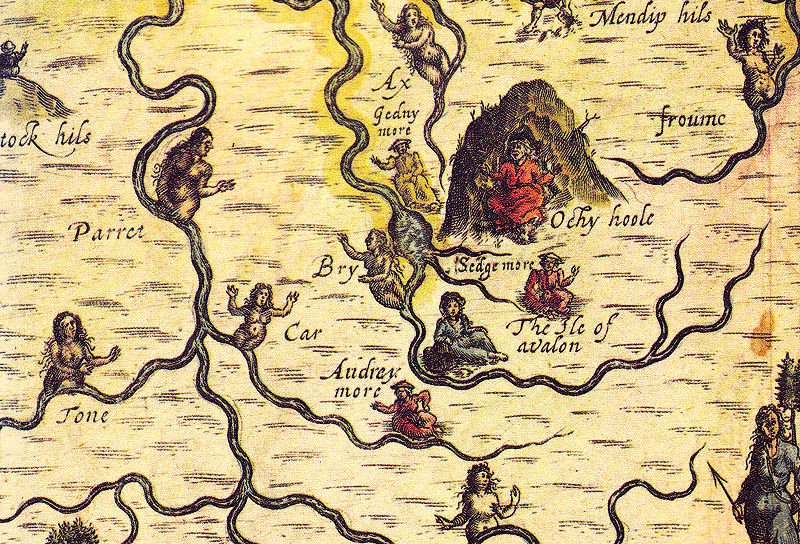
River Nymphs, Somerset, 1622
Source
As discussed a few times before, in the old Irish ‘cycles’ the salmon was always the fish of knowledge. Elsewhere there are legends of a miraculous supply of fish coming from from sacred wells and, whilst Mr. Macculloch speculates that these are later Christian redefinitions of pagan beliefs, I would speculate that it was originally taken from the Pagan tradition and ascribed to Jesus with his loaves and fishes performance.
The Each Uisge, or " Water-horse," is a horse with staring eyes, webbed feet, and a slimy coat, and is still feared today in certain areas. Many Scottish Highland lochs are still haunted by this dreaded being, who is also known in Ireland and France, although in those places his nature is more that of a trickster. Manannan Mac Lir's horses were the waves of the sea, and he was usually associated with a horse. Epona, the horse-goddess, is sometimes connected with the waters, however, the horse-forms of beneficent water-divinities have been a highly specific target of Christian distortion and redefinition.
“In Wales the ‘afanc’ is a water-monster, though the word first meant "dwarf," then "water-dwarf," of whom many kinds existed. They correspond to the Irish water-dwarfs, the Luchorpain… In other cases the old water beings have a more pleasing form, like the syrens and other fairy beings who haunt French rivers, or the mermaids of Irish estuaries. In Celtic France and Britain, lake fairies are connected with a water-world like that of Elysium tales, the region of earlier divinities. They unite with mortals, who, as in the Swan-maiden tales, lose their fairy brides through breaking a tabu.” (ibid)
The Swan-maiden tales involve a supernatural woman in the form of a swan who comes to bathe in a lake or stream, shedding her swan skin. An unmarried man steals the skin (in the case of the Swan Maiden) or clothes (with the Valkyrie) and hides them, thus trapping the Swan Maiden (or Valkyrie) on earth and he then entices her to marry him. In time, the husband either betrays his wife by destroying the skin or clothes – at which point she leaves him – or their children find the skin/clothes and return them to their mother – allowing her to fly away. This usually results in the husband being forced to embark on a quest to prove his worth to his wife and bring her back home.
The Fairies, or Maidens, that were once associated with wells or with a water-world beneath them, were usually nameless, except in certain cases, as we will shortly discover. They, like the older spirits of the wells, had a beneficent character, but they are all now long gone, having been replaced by Christian saints or by their wells having been buried beneath roads or office blocks etc. We will find out why later...
So, there we have it then, if the wells, springs, rivers and lakes were portals to the Otherworld and the source of nature’s abundance, then it’s reasonable to expect the King of that specific domain to be associated with sacred fish, as they are the most visible, and constant, of his manifestations in the physical realm.

Well Maidens
Perhaps the word ‘Fisher’ was a distortion of the original Celtic ‘peiskos’ (fish) that better satisfied the Christian scribes and their masters as it linked to “the fisher of men” speech supposedly given by Jesus. Let's not forget, of course, that the symbol of the fish was adopted by Christianity for little or no apparent reason. The not-so-ancient Greeks came up with ἸΧΘΥΣ (IKhThUS), which became an acronym for "Jesus Christ, God's Son, Savior," which only works in English. Maybe Peiskos sounded like 'Ichthys' to the Christian scribes? It’s interesting to note that the original spelling of Chrétien de Troyes’ name was ‘Chrestien’ which means “follower of Christ” and he was the one who started it all off with his ‘Perceval ou le Conte du Graal’ ...Peiskien de Troyes would have been a follower of Peiskos, or fish, I suppose. Incidentally, the word ‘peiskos’ became Piskies or Pixies.
A great deal of fuss is made regarding the ‘Grail Questions’. Even today you can find loads of online ‘spouters’ waxing lyrical about the spiritual significance of ‘asking the right question’. Personally, I’ve always found it a bit silly and I wonder if it was originally born of misunderstanding. If we take a quick look at the words ‘Quest’ and ‘Question’, it’s obvious that the two words are very closely related...
Quest - c. 1300, "an inquest, a judicial inquiry;" early 14c., "a search for something, the act of seeking, pursuit" (especially in reference to hounds seeking game in the hunt), from Old French [to mid 14th C.] queste "search, quest, chase, hunt, pursuit; inquest, inquiry"...The medieval romance sense of "adventure undertaken by a knight" (especially the search for the Grail) is attested from late 14c. Chaucer has questmonger (late 14c.), "one who profits from an unjust action at law." Source
Question - early 13c., questioun [WS: Middle English?], "philosophical or theological problem" (especially when phrased as an interrogative statement) ...early 14c. as "utterance meant to elicit an answer or discussion," also as "a difficulty, a doubt," from Anglo-French questiun, Old French question "question, difficulty, problem; legal inquest, interrogation, torture," Source
Both share the meaning of ‘inquiry’, ‘inquest’ and ‘interrogation’.
The Christianised Grail Quest romances are all derived from earlier sources which are ‘Celtic’ in nature. The ‘Quest’ element is a throwback to that very Celtic culture that inspired the later romances, whereby various tasks, or tests, must be performed successfully in order to achieve ‘The Grail’. In the original Celtic tradition, the Goddess would test the integrity of any prospective, or existing monarch (or surrogate,) by setting him particular tasks or even goading him into taking one course of action or another. These tasks would often involve trips to The Otherworld.
If the ‘The Grail’ itself is the agreement or contract between our world and The Otherworld, between humanity and the unseen Forces of Nature – then the cataclysm and the ensuing Wasteland, were the result of the Grail’s loss. If we then consider that, as mentioned above, in the original ‘Celtic’ tales the Goddess would ‘question’ or test the fitness of the prospective, or even the current, sovereign through some ‘quest’, then the possibility of misunderstanding seems even more likely. As we have already seen, the Grail ‘legends’ became more and more detached from their Pagan roots with each new version and the relationship between the Fisher, or Wounded, King and the Land eventually disappeared completely, being replaced by the attainment of Christian perfection and direct communion with the Christian God. The mystical concept of asking the right questions found a particular resonance with the Christian redefinition of the Grail Quest …ion.
Jessie L. Weston’s 1919 book, ‘From Ritual to Romance’ proved invaluable in my previous articles and it still has more to give. After all of her research, she could not help but lament the gradual manipulation and redefinition that was inflicted upon the original versions of the Grail Quest…
“...practically no trace of the old Nature Ritual survives in the final Queste form [La Queste del Saint Graal]. The remodelling is so radical that it seems most reasonable to conclude that it was purposeful, that the original author of the Queste had a very clear idea of the real nature of the Grail, and was bent upon a complete restatement in terms of current orthodoxy. I advisedly use this term, as I see no trace in the Queste of a genuine Mystic conception, such as that of Borron. So far as criticism of the literature is concerned I adhere to my previously expressed opinion that the Queste should be treated rather as a Lancelot than as a Grail romance. It is of real importance in the evolution of the Arthurian romantic cycle; as a factor in determining the true character and origins of the Grail legend it is worse than useless; what remains of the original features is so fragmentary, and so distorted, that any attempt to use the version as basis for argument, or comparison, can only introduce a further element of confusion into an already more than sufficiently involved problem.”

So, something had to be hidden. Not only that, but there were increasing warnings regarding the danger of acquiring this ‘knowledge’ and how it was to be reserved for an ‘elite’.
J. A. Macculloch has this to say regarding the geasa or taboos applied to kings in ‘primitive’ societies...
“...who are often magicians, priests, or even divine representatives. On them the welfare of the tribe and the making of rain or sunshine, and the processes of growth depend. They must therefore be careful of their actions, and hence they are hedged about with tabus which, however unmeaning, have a direct connection with their powers. Out of such conceptions the Irish kingly geasa arose. Their observance made the earth fruitful, produced abundance and prosperity, and kept both the king and his land from misfortune. In later times these were supposed to be dependent on the "goodness" or the reverse of the king, but this was a departure from the older idea, which is clearly stated in the Book of Rights. The kings were divinities on whom depended fruitfulness and plenty, and who must therefore submit to obey their geasa.” (Source: ‘Religion of the Ancient Celts’, by J A Macculloch, 1911.)
If, by some means, the 10th century cataclysm was in fact the result of a breach of the agreement made between the Goddess and her chosen earthly guardian, then the means by which that situation was achieved would be very valuable information to anyone wishing to repeat the event on a smaller scale. The Fisher King, or The Wounded King, in relation to the 10th century cataclysm would need to have been the ruler of a vast empire in order to account for the widespread effects of the cataclysm.

The ‘Lost Kingdom of King Arthur’ has been discussed many times before on this website, as has his responsibility as ‘Guardian of the North’ and the possibility that ‘Arthur’ was in fact a title pertinent to this responsibility. The frequent occurrence of the title ‘Emperor Arthur‘ throughout the Mabinogi, also relates to the substantiated claims that Arthur had an extensive empire even beyond Britain. These factors have remained hidden for a very long time. Furthermore, the Arthur of the Legends/Romances was married to Guinevere or Gwenhwyvar. Gwen or Gwenn, means ‘white’ and hwyvar, is a word “cognate with the Irish word siabhradh, a fairy, equal to siabhra, siabrae, siabur, a fairy, or ghost, the Welsh and the Irish word going back to the form seibayo.” (‘Welsh Folklore’, by Wirt Sikes, 1880.) Guinevere was therefore either divine or semi-divine – what was known as an ‘Ælfgifu’…
Ælf (n.) = An Elf or Fairy. ‘Gifu’ (n.) [gyfu, giefu, giofu, geofu, gif] = A gift ⬩ grace ⬩ favour. Also the name of the so-called Anglo-Saxon Rune ‘G’, which not only stands for the letter g, but for gifu as a gift. RUNE [Gifu] gumena byþ gleng and herenys ‘a gift is the honour and praise of men.’ (Source)

RUNE [Gifu]
Source
“It's described, for example, in the book The Runic Tarot as a representation of the giving-receiving balance in friendships.” (Source The Runic Tarot by Caroline Smith, John Astrop, 2005.)
This is a highly significant concept that will be very important later, and yes, you’re absolutely right – it is a cross.
Accounts of such Ælfgifus associated with kings can still be found in post-cataclysm ‘official’ history… even in the Bayeux Tapestry
Of course, such speculation requires the opening of a whole new ‘can of worms’. No doubt many will call this wild speculation and simply reject it out of hand. However, undaunted, I have the tin-opener already prepared...
The King Arthur we know from the poems, legends, books, cinema and television, is a hero destined to return again in Britain’s darkest hour. He’s the Christian hero who established the new religion in Norway and who’s Knights of the Round Table recovered the Holy Grail, brought to England by Joseph of Arimethea. We already know that most of that is nonsense, but what about the ‘hero’ part? If he was a Christian hero does that mean he turned against his Pagan origins? Is it for that reason he became so widely revered after the cataclysm when Christianity and its accompanying Feudal Lords, took control?
To help us out with this line of enquiry, it’s important to try and get a clearer understanding of the general esteem in which Arhtur was held after the cataclysm, or at least the vision of him that was being enthusiastically promoted on the newly formed ‘continent’. No doubt the 'peasant' populations all knew the truth – the real reason for the cataclysm. Along with the explosion in Arthurian literature, and from its most prolific source, the cult of Chivalry was born – or reborn depending upon your point of view. It was the Norman/Angevin/Plantagenet dynasty that patronised Chrétien de Troyes and his contemporaries to write the Arthurian Romances. Marie de Champagne was of that same lineage and was apparently directly responsible for introducing the idea of ‘courtly love’ into the genre which blossomed into the cult of chivalry.
In the 12th century, Henry II claimed that King Arthur’s tomb had been discovered within Glastonbury Abbey. This was nonsense, but Henry’s Angevin dynasty claimed descent from Arthur as their legitimacy to the throne of England, plus he also had his sights set on Scotland and Wales. The treacherous Welshman, Gerald of Wales, (of whom we will hear more later,) in his circa 1223 book, ‘On the Instruction of a Prince’ (De Instructione Principis), immortalised the hoax and established a connection between Avalon and Glastonbury which, rightly or wrongly, survives to this day.
Gerald of Wales wrote his book specifically for Edward I who was so obsessed with Arthur that his interest went far beyond being purely political. In fact, on the Easter holiday in 1278, Edward went to Glastonbury Abbey to preside over the opening and re-interment of the alleged remains of King Arthur and Queen Guinevere, as documented by Gerald in his book. This event took place about six months after Edward had quelled the rebellion of the Welsh Prince Llywelyn-ap-Gruffyd. Even so, those pesky scholars still claim that the event was propaganda intended to convince the Welsh that Arthur was really dead and not about to return. However, they haven’t really thought it through because the disinterment ritual took place at dusk on the Easter holiday, which coincides with Christ’s resurrection – and could equally constitute an attempt to resurrect Arthur in Edward I. This is further emphasised by the fact that Edward personally wrapped the supposed bones of Arthur in silk, while his wife, Queen Eleanor, did the same for the supposed Guinevere. Furthermore, their skulls were not re-interred, but left on display, which just has to signify that the ancient Celtic Cult of the Severed Head (whereby the soul or spirit as we would call it, was located in the head,) was still significant in the 13th century and what's more, Edward was obviously very familiar with it. Whatever the case, the Welsh rebellion began again shortly after the Glastonbury ritual, so if it was all propaganda it wasn’t very effective.
When the Welsh were finally defeated again in 1283. Edward added the Principality of Wales to England. He also forced the Welsh to surrender cultural relics as tokens of their submission, which included various precious stones, yet another piece of the true cross and what Edward declared to be the legendary crown of King Arthur, which he took from the head of the slain rebel Welsh prince, Llywelyn-ap-Gruffyd. (Sources “Annales Londoniensis,” and “Flores historiarum.”)
Obviously, being no relation to anyone significant whatsoever, Edward could only seize the sovereignty of Wales by force and by stealing the symbol of Arthur’s sovereignty, which was originally gained through the sacred marriage ritual. Edward would also later steal the Stone of Scone, or the Stone of Destiny, (the ancient coronation stone of Ireland and Scotland) from the Scots for exactly the same reason. He also further justified his claim to Scotland in a letter to Pope Boniface VIII (or Nicholas IV according to the source used,) by quoting a convenient version of Arthurian ‘legend’ and claiming direct descent from the king himself.
Round Table tournaments and similar, with their lavish pageantry and surreal theatrical aspects, proved a heady mix that served to engender enthusiasm for chivalric exploits and support for the king’s wars. Often such events culminated in the public swearing of ostentatious and elaborate oaths, (very real ones,) in which those present pledged themselves to certain causes… or ‘Quests’. Edward even went as far as to commission a physical copy of Arthur’s Round Table which became the centrepiece for a number of tournaments and chivalric festivals held at Winchester throughout the late 1280’s and ’90s which often culminated with mass knighting ceremonies.
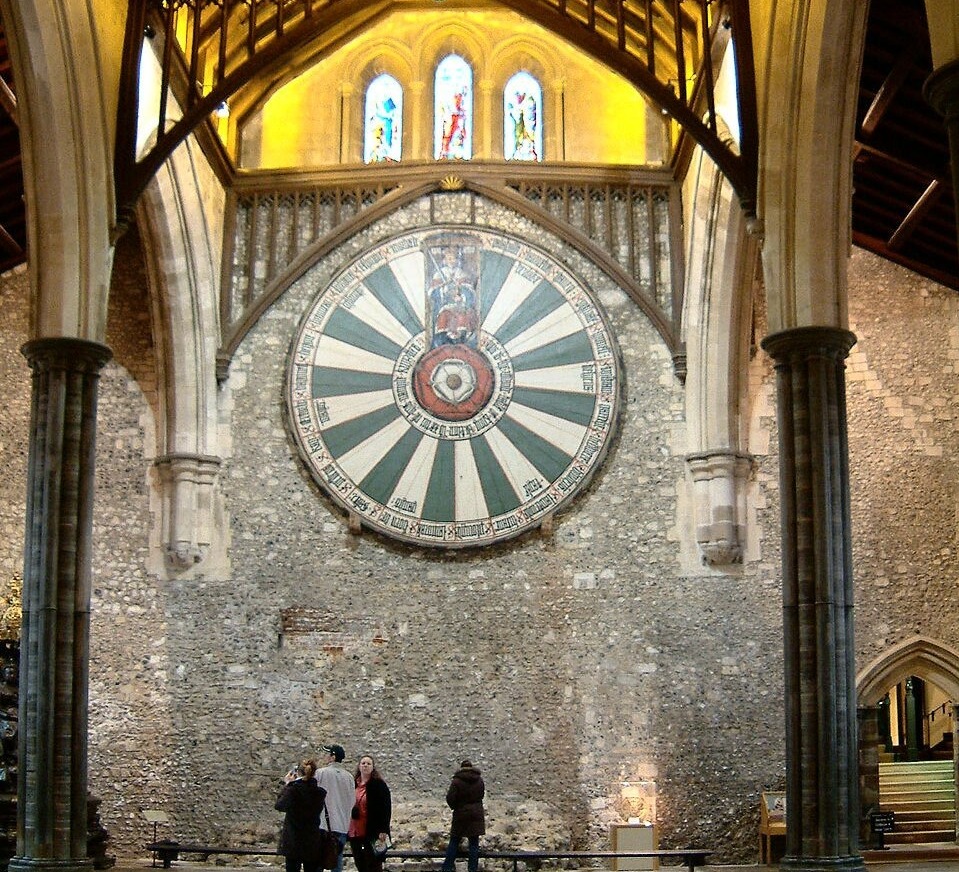
Edward I's Round Table, Winchester
Christophe.Finot, CC BY-SA 2.5
Besides being an opportunity for pontificating upon the close association between kingship and chivalric activity, Edward’s enthusiasm for such events served a secondary and very practical purpose. A long-running issue, which came to a head during his reign, was that the gradually shifting underpinnings of the European economy, and the ever-increasing cost of outfitting knights for war, greatly reduced the number of knights within England. Edward harnessed the popularity of Arthurian romance literature as a recruiting tool in order to reconstitute and resurrect English chivalry, which the king held was greatly diminished from the glory day of Richard I. This was also a cover for the provision of a reliable source of heavy cavalry for his frequent wars and so he passed laws requiring that every Englishman with an annual income above a certain threshold was required to take up the arms of knighthood.
By the way, he died from a sudden attack of dysentery just outside the Scottish border whilst en route to fight against Robert the Bruce, whose close family Edward had treated with inhuman brutality. Was this revenge for those crimes and his theft of the Stone of Destiny from Scotland?
Edward wasn’t alone in his manipulation and hijacking of the Arthurian legends and this has led many ‘scholars’ to consider that the entire Arthurian legacy is a hoax that was invented by Geoffrey of Monmouth, so that it could be used by monarchs purely for their own political advantage.
Whilst there could indeed be some truth in that, in the sense of redefinition rather than total invention, it ignores the later extreme measures employed by the likes of Polydore Vergil, to destroy the early (relatively) uncorrupted texts of Arthur’s involvement in British history. It also assumes that Geoffrey of Monmouth’s book was so widely read back in the early 12th century that it captured the hearts and souls of the entire British, Welsh and Scottish populations, who then passed their passion for it’s stories down from generation to generation.

Polydore Vergil
The vast majority of stately homes in Britain will have a very old genealogy on display showing their descent from King Arthur, (not William the Conqueror you will note) which they see as ‘proof’ of their legitimacy and family honour rather than a political ploy. The most notable of these were, and still are, the Plantagenets and their descendants who still sit on the British Throne. There are even examples that link King Arthur back to ancient rulers, including the House of King David of Israel.
For me there can be no doubt that the Arthurian phenomena was a pre-existing and firmly entrenched element of British, Welsh, Scottish, Irish, Breton, French and even Spanish ‘Celtic’ culture and this was precisely why it was used by monarchs and others to legitimise their political claims. More than that, it embodied the ancient system of sovereignty through sacred marriage and thus the concord with the forces of nature and the Otherworld. This goes to the very heart of the matter and defines the conflict between the ancient system and the new one imposed after the cataclysm, whereby it was the Christian God who demanded fealty, obedience and the ownership of everything through his earthly representatives – The Pope and the Feudal Kings.
The question remains though – was Arthur involved in the breaking of the relationship with the Old World and the arrival of the new one? Is this why he was so widely proclaimed as a champion of Christianity?
n my recent article, ‘Taliesin, The Divine Poisoner’, I reassessed the poem Preiddeu Annwn and found it to be a catalogue of raids, or maybe even quests, that were made, at one time or another, to the Otherworld and presented in such a way as to make it seem as if King Arthur and other ‘Celtic’ heroes, were involved in attempts to liberate various treasures from ‘Hell’ and all in the name of the Christian God. However, the most significant symbolism of the entire Taliesin saga occurs at the time of his thieving from, and betrayal of Cerridwen the Goddess. It was this premeditated act that caused the release of 'the most powerful poison as there could be in the world', which eventually spread throughout time itself, corrupting all that had come before it and all that came after – right up to today. This, of course, gave rise to many other questions that I voiced at the end of the article...

Arthur with Taliesin
Was The Divine Poisoner, Taliesin, responsible for ‘turning’ Arthur to break the geis of his sacred marriage to the Goddess and the land? Where and to whom exactly did Taliesin’s loyalties lie? Why does the god he serves need him to steal his gifts of divine inspiration and prophetic wisdom from what Christians would consider 'a witch from hell'? That's actually one of the most puzzling aspects of the entire business. If Taliesin's god was also the ruler of another kingdom in The Otherworld, then it makes perfect sense. Does the lament at the end of Preiddeu Annwn regarding ‘saints lost in the void’ indicate that other infiltrators of the old Pagan ways, like Saint Patrick for example, also originated in the Otherworld just like Taliesin himself? Does this mean that the Abrahamic religions originated in The Otherworld and was that truly “as powerful a poison as there could be in the world?"
Some may find those concepts a bit extreme and if so, I apologise. However, I would ask you to bear with me as I didn’t pose those questions without having good reasons…
Many of the intermediate Dark Earth Chronicles articles have been concerned with an attempt to discover something of the real situation immediately before and immediately after the 10th century cataclysm. Having a general idea of this will set the scene for much of what’s to follow. So, here we go again...
None of what follows is intended to claim that London is, or was, a special place. Being the capital city from supposedly ancient times, it has obviously received much more attention over the centuries than, for example, Milton Keynes, but it is indicative of how sacred Pagan sites in general have been redefined, reviled and destroyed over the past 1000 or so years. Later we will discover why.
“It has been suggested that the London area was controlled from three sacred mounds; they are named as Penton Hill, Tothill and the White Mound, otherwise known as Tower Hill. Any such theory can readily be dismissed as nonsense, but there are curious parallels and coincidences which render it more interesting than the usual fantasies of latter-day psycho-geographers. It is known that in prehistoric worship a holy place was marked by a spring, a grove and a well or ritual shaft. There is a reference to a ‘shrubby maze’ in the pleasure gardens of White Conduit House, situated on the high ground of Pentonville, and a maze’s avatar was a sacred hill or grove [WS: ‘Pen’ also means ‘head’]. Close at hand is the famous well of Sadlers Wells. In recent days the water of this well flowed under the orchestra pit of the theatre but, from medieval times, it was considered holy and was tended by the priests of Clerkenwell... Another maze was to be found in the area once known as Tothill Fields in Westminster; it is depicted in Hollar’s view of the area in the mid-seventeenth century. Here also is a sacred spring, deriving from the ‘holy well’ in Dean’s Yard, Westminster. A fair, similar to the pleasure gardens upon White Conduit Fields, was established here at an early date; the first extant reference is dated 1257.” Source ‘London – A Biography’ by Peter Ackroyd”
The part about the ‘shrubbery’ is highly reminiscent of the Knights Who Say Ni! Anyway, Tower Hill is closely associated with Bran the Blessed, who we have also discussed may times before.
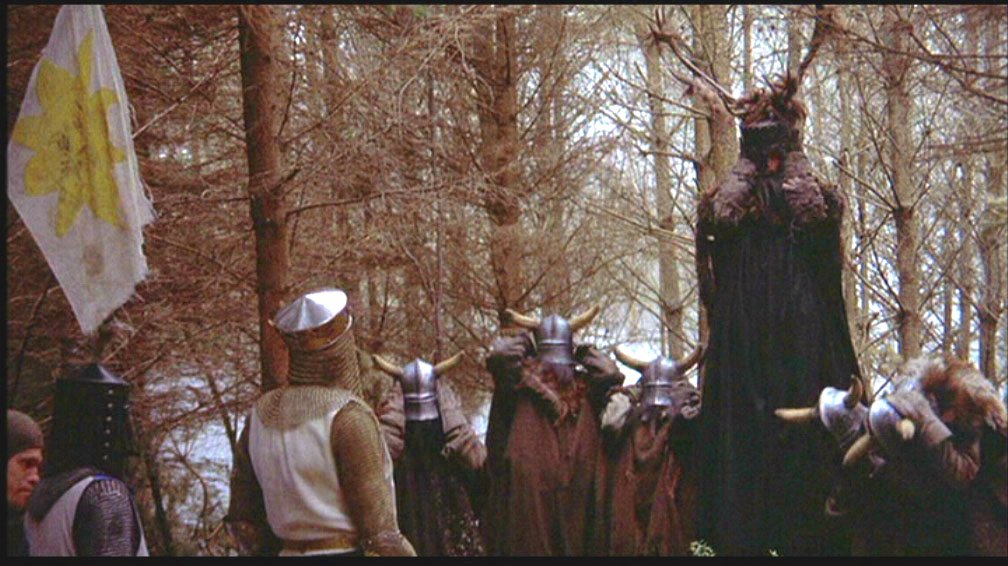
"Bring us a shrubbery!"
Source
“On Tower Hill there was a spring of clear bubbling water, reputed to possess curative properties. A medieval well exists there, and traces of a Late Iron Age burial have been uncovered. There is no maze but the place has its own share of Celtic legends; according to the Welsh Triads the guardian head of Bran the Blessed is interred within the White Hill to safeguard the kingdom from its enemies. London’s legendary founder Brutus, also, was supposed to have been buried on Tower Hill, in sacred ground that was used as an observatory until the seventeenth century.” (ibid.)
This relates to the tale from the Second Branch of the Mabinogi, ‘Branwen ferch Llŷr’, whereby Bran was mortally wounded and his companions carried his still eloquent severed head to Tower Hill in London (via a stop-off in the Otherworld.) The three London mounds, or hills; Penton Hill; Tothill and Tower Hill; all bear very similar characteristics and were clearly sacred Pagan sites. They are also linked by ley lines and Tower Hill, (aka The White Mound or Bryn Gawr,) also connects to Silbury Hill in Wiltshire and thus into the wider international network. In Pagan lore, the head was considered to be the dwelling place of the soul, just as sacred mounds or hills are considered to be the heads, or souls, of the local landscape. Many ‘scholars’ equate Bran with The Wounded King Grail motif, in fact as being the original. However, the resulting Wasteland is entirely missing from the story of his wounding and death… although stay tuned for the tale of Brangemor later on.
Another such site was Bridewell Palace, which was built in 1520 for Henry VIII, right next to the ancient sacred well of ‘St. Bride’ – the Christianised form of the Goddess Bride, Brigit or Britannia. It was situated on the banks of the Thames where the River Fleet joined. In 1533, Edward VI gave it “to to the City of London as a home for destitute children and vagrants and as a prison for punishing disorderly and loose women and petty offenders with short periods of incarceration and regular whippings.” (Source ) Many more of these institutions were opened all over the country – all of them were called Brideswells. “The whippings took place in public twice a week, there was a ducking stool on the banks of the Thames in 1628 and there were also stocks.” (ibid.) The River Fleet was entirely covered over in 1764, destroying many other sacred wells. Over time these prisons evolved to accommodate more serious offenders and the Brideswells became ‘human zoos’ when, “As with Bedlam, the public could gain admittance to view the unfortunate inmates. Priscilla Wakefield, author of ‘Perambulations in London’ (1814) wrote, ‘Many of the prisoners who we were permitted to see, were women, young, beautiful and depraved.’” (ibid.) Eventually the term ‘Bridewell’ became a general one that covered, prisons, village lock-ups and even Police Stations. As for the well itself in St. Bride’s Church, Fleet Street, it “was once one of the great spiritual centres of London, but was diminished to secular use by the end of the sixteenth century. It met its end on the occasion of the coronation of George IV, in the summer of 1821, when thirsty visitors are said to have drained it.” (Source: Ackroyd, Peter, ‘London Underground – The Secret History Beneath the Streets’, 2011) The disrespect involved in turning the name of a well, sacred to the Goddess Bride, into an institution of punishment, incarceration and law enforcement speaks volumes regarding Christian tolerance and ‘charity’.

'Clooties' at Saint Brigid’s Well, Kildare
Source
“Many springs once rose in London, coming up from the gravel beds beneath the surface...The river Fleet, in the vicinity of Smithfield, became known as “the river of wells.” In the thirteenth century, according to the antiquary John Stow, ‘they had in every street and lane of the city divers fair wells and fresh springs.’...Many wells were once deemed to be holy, continuing a tradition of water worship that goes back to the very beginning of human history. In the Anglo-Saxon period, curses were imposed ‘if any man vow or bring his offerings to any well’ or ‘if one holds vigils at any well.’ In the course of archaeological excavations, or of building work, coins and vessels are found buried beside wells. One of the most common finds is that of the lachrymatory, or vessel for tears. Coins are still thrown into wells as a harbinger of good luck. Wishing wells, and ‘wakes of the well,’ were ubiquitous…
“...In the crypt of St. Martin-in-the-Fields, after recent excavation, were uncovered a well together with a place of interment that can be dated to the fourth century AD; the well itself may be a remnant of pagan worship. So the church has been hiding its origin for more than 1,500 years. It has concealed its source, all the more numinous for being buried. That is another property of the underworld. Another well was found beneath the crypt of Southwark Cathedral. A well dedicated to St. Chad, the patron saint of medicinal springs, was situated close to King’s Cross in what is now St. Chad’s Place...
“Wells and springs are places of transition, where the underworld rises out of the ground. They encourage song and dance; they are the site of ritual. The plethora of London names such as Spring Gardens, Well Walk and Wells Street testifies to the extent and variety of these waters. We also have Shadwell and Stockwell and Camberwell. It would be weary work to enumerate all the buried wells of London. It is enough to know that they once existed.” (Source: Ackroyd, Peter, ‘London Underground – The Secret History Beneath the Streets’, 2011)
Before we leave the subject of London, there’s one very curious thing I’d like to relate concerning Princess Diana…
“In the records of St. Paul’s Cathedral the adjacent buildings are known as ‘Camera Dianae.’ A fifteenth-century chronicler recalled a time when ‘London worships Diana,’ the goddess of the hunt, which is at least one explanation for the strange annual ceremony that took place at St. Paul’s as late as the sixteenth century. There, in the Christian temple erected on the sacred site of Ludgate Hill, a stag’s head was impaled upon a spear and carried about the church; it was then received upon the steps of the church by priests wearing garlands of flowers upon their heads. So the pagan customs of London survived into recorded history, just as a latent paganism survived among the citizens themselves.” (Source: ‘London – A Biography’, Peter Ackroyd)
I wonder if the “annual event” took place on the 29th of July, the same day that Prince Charles married Lady Diana at St. Paul’s Cathedral, London? Of course, Diana is a Roman Goddess, therefore of absolutely no interest whatsoever – what Ancient Romans would there have ever been in London to worship her – none of course. However, the supposed Roman gods were all redefined Pagan ones and, as usual, there’s a variety to choose from. My personal favourite is Epona / Bride / Brigit, so was the wedding of Charles and Di an attempt for Charlie-boy to gain sovereignty over the land? Was Diana meant to be Charles’ Ælfgifu? Did she have to be sacrificed later when it all went wrong?
TJust an observation – I was perusing the Wikipedia entry for John and Caitlín Matthews and I noticed this...
“Hutton, commenting on Caitlín Matthews' works, states that she ‘falls below the standards required of a professional historian. She makes no attempt to distinguish between the relative value of sources, so those from the seventh century and from the seventeenth are put together with no sense of context.’ He also states that she conditions her work to the needs of her audience and that she has incorrectly suggested parallels between Celtic lore and Native American religion. [Hutton, Ronald (1991). The Pagan Religions of the Ancient British Isles: Their Nature and Legacy.]” Source
Spoken with true ‘professional’ arrogance and ignorance. Shame on you Ronald Hutton and shame on Wikipedia for allowing that totally unfounded and biased opinion to be a part of someone’s entry. I’m also about to condition my work to the needs of my audience, such as it is, and suggest a parallel between Celtic lore and the Native Australian way of life, so ‘up your pipe’ Mr. Hutton.

The Dreamtime
Source
The Dreamtime is the foundation of Aboriginal spirituality and mythology. It’s the equivalent of the ‘Celtic’ Otherworld, but their understanding of it is far greater and deeper than ours because they’re still in touch with it. Songlines are the equivalent of our Ley Lines, but, hold on to your hats, there’s so much more to them than anyone ever imagined...
“The religion of Australian Aboriginal people is deeply intertwined with their culture and way of life. At the heart of their beliefs lies the Dreamtime, a creation story that forms the basis of their spirituality and guides their practices. According to this belief system, the universe was created by ancestral beings who shaped the land, animals, and plants. The Dreamtime also teaches that humans were created from the earth, and that they are connected to the natural world in a profound way...
“...One of the key aspects of Aboriginal spirituality is the connection with the land. This belief holds that the land is a living entity with a spirit that needs to be respected and cared for. This bond between Indigenous people and nature is central to their spirituality, and it is believed that the land provides them with everything they need to live…
“...Ancestors play an important role in Aboriginal religion, as they are believed to continue to guide and teach the living. The spirits of ancestors are often called upon to offer guidance and strength, and their wisdom is passed down through generations. Ancestor worship is a key feature of Aboriginal ceremonies, which are held to mark important events such as initiation, healing, and the changing of the seasons...
“...Totems are another important aspect of Aboriginal religion, as they are sacred symbols that are associated with particular clans or groups within Aboriginal communities. These symbols are believed to represent qualities or traits that the group is known for, and they are often depicted in art and other cultural expressions…
“...Ceremonies are at the heart of Aboriginal spirituality, and they play a central role in maintaining the balance between the spiritual and physical worlds. These can be for initiation, healing, celebrations of the seasons, or other significant events. Ceremonies often involve singing, dancing, and the use of sacred objects, and they are a way for the community to come together and connect with the spiritual realm…
“...Aboriginal belief systems include the existence of a range of spirits and supernatural entities, such as nature spirits, ancestral spirits, and spirits associated with local landmarks. These entities are believed to have the power to influence the physical world, and they are often invoked in ceremonies and other spiritual practices…

Songlines
Source
“...Songlines are another important aspect of Aboriginal spirituality. These are intricate maps that depict the routes taken by ancestral beings during creation, and they are essentially oral histories that detail the importance of particular places. Songlines have been passed down through generations, and they serve as a way for Aboriginal people to connect with their ancestors and the land…
“...Taboos also play a role in Aboriginal culture, serving as prohibitions or restrictions on certain behaviours or practices. These taboos are often associated with certain sacred objects or places, and they are seen as a way to maintain the balance of the spiritual and physical worlds…
“...Aboriginal culture has complex kinship systems, which determine social relationships and responsibilities. These systems have a spiritual dimension, as they serve to connect people with the spiritual world and their ancestors…
“...Gender roles are also an important part of Aboriginal culture and spirituality. These roles are often reflected in ceremonies and other cultural practices, with specific duties assigned to men and women…
“...In conclusion, the religion of Australian Aboriginal people is a rich and complex system of beliefs and practices that is deeply connected to their culture and way of life. From the Dreamtime to the connection with the land, from ancestor worship to totems and ceremonies, Aboriginal spirituality is a testament to the resilience and wisdom of this ancient culture.” Source
When I read that it blew my socks off. Never mind the glaring similarities to the pre-cataclysm, Pagan / ‘Celtic’ beliefs, it’s like a lesson in what they truly comprised before they were totally screwed up by Christianity and all the other selfish, moronic influences. Of course, even though Australia was fairly late on the colonisation agenda, there were still all the usual despicable abuses...
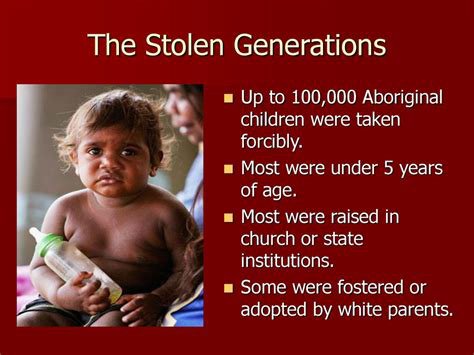
“The Stolen Generations refer to Indigenous children who were forcibly taken from their families by the Australian government between 1910 and 1970. This practice was an attempt to assimilate Indigenous people into mainstream Australian society. The impact of the Stolen Generations on Aboriginal culture and spirituality has been profound and long-lasting.” (ibid. & image)
Right, so now we can contrast all of the above, with what happened after the cataclysm in the 10th century…
The very idea that a king could take ownership of the land, and everything in and on it, must have been as bizarre a concept to the Pagan inhabitants of Britain as landing a man on the Moon would have been (and still is.) That this ownership could passed on as a legacy to descendants would be even more ridiculous. This is exactly what William the Bastard did in 1066.
Incidentally, the word ‘pagan’ originally meant "of the country, of a village," and it is also the root of the word ‘peasant’ or Old French paisant, paisent "local inhabitant" (12c., Modern French paysan), earlier paisenc, from pais "country, region.” (Source) So, the association of nature and the countryside with non-Christian naughtiness was made very early on.
Almost immediately after the invasion, William the Bastard began to enclose and isolate the forests from the ‘peasants’. This act alone accounted for the majority of the rebellion against the Normans. Indeed, it was believed that William Rufus, Bill the Conk’s son, was believed to have been executed in the New Forest. Hampshire, because of the sequestration of the forests, although he was deeply unpopular within the Norman ranks and also amongst the officials of the church. Others see this as a ritual sacrifice offered up by the secretly heathen Norman/Angevin/Plantagenets.
Apart from isolating the population from the abundance of nature in terms of food, raw materials, herbs and fuel, they were also isolated from the sacred sites, such as wells, springs, standing stones and the groves of trees within the forests. They could no longer observe the age-old rituals and celebrations that ensured the joint welfare of both the people and the land. Hunting was now a sport exclusively enjoyed by foreigners – people who had no respect for any life other than their own. Anyone caught ‘poaching‘, or even inside a Royal Forest, was put to death.
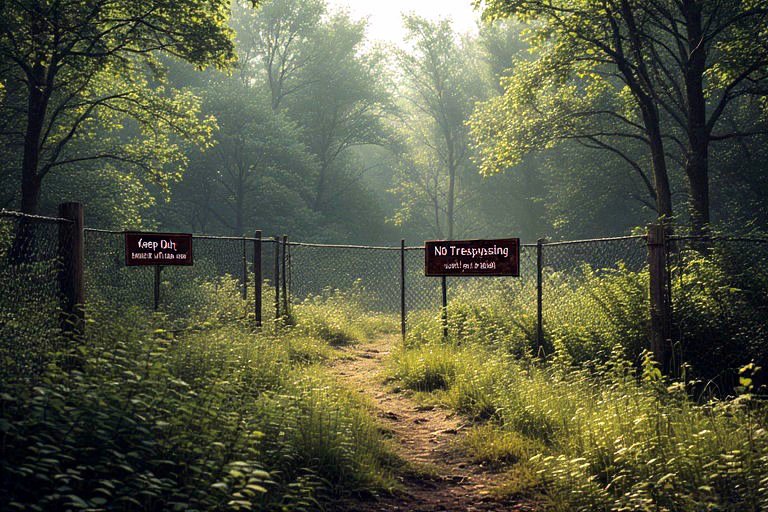
Gradually the forests, along with their sacred sites, were destroyed, the land cleared and forever wounded by roads and new towns. Castles littered the countryside and became home to feudal lords who owned all the local land, along with all the local people and their animals. They were all put to work as labourers digging the land for their masters. Churches replaced ancient sacred places and the local deities were redefined as saints. The new Catholic religion preached suffering and obedience to an absentee supernatural feudal lord, or god, who had chosen a foreign Pope and their new king as the earthy representatives of his authority, and who also hated trees.
Soon, the ancient customs that couldn’t be eradicated, or absorbed, were demonised as the work of Satan – another supernatural feudal lord who ruled over the place that was the promised land for all sinners. His chosen representatives on earth were all the peasants, who had unwittingly committed an ‘original sin’ simply by being conceived and then born. For this they were doomed to suffer for eternity, unless they could suffer even more in the service of their overlords in order to earn a place in ‘heaven’.
Meanwhile, those very overlords knew exactly how to use the sacred sites in the forests and the land, just as they knew very well the consequences of neglecting the ancient rituals and ceremonies, and destroying the forests. They used the new Catholic religion as a weapon to enslave the population and maintain its obedience.

But there was resistance. Like most English folklore, the Robin Hood story we have been handed down is largely rubbish, and yet it bears witness to the fact that the ‘old ways’ were not entirely abandoned after the cataclysm. Even the sanitised versions cannot disguise the central importance of the ‘greenwood’ – the forest. Neither can the significance of the Maid Marian figure be ignored, being an echo of the Maidens of the Wells and the Goddess of Nature. For centuries Robin Hood and Maid Marian were the central characters of all May Day celebrations in England.
All of the above has been leading up to this point. It’s a complicated subject because it’s so obscure and highly confusing. The text itself appears to be, and even claims to be, a prologue to all of the Grail stories and in particular Chrétien de Troyes’ Persevalus, but it differs greatly from that story. Besides the surviving manuscripts having suffered damage over time, the story has also been heavily redefined and Christianised, as you might expect. Much has been made of ‘The Elucidation’, although others dismiss it out of hand. Rather than parroting someone else’s opinion, I intend to make my own analysis.
The only translations available to a cheapskate like me were: one by William W. Kibler from the book by Albert Wilder Thompson, ‘The Elucidation: A Prologue to the Conte del Graal’, 1931, as published in “The Elucidation’, by Norris J. Lacy, from The Camelot Project 2007; and one by Gareth Knight and Caitlín Matthews from ‘The Lost Book of the Grail – The Sevenfold Path of the Grail and the Restoration of the Fairy Accord,’ of 2019.
It’s presented in verse and begins in the form of a recitation with a warning about revealing or recounting the story of the Grail, as according to a ‘Master Blihis’, (much more on him later,) no one should reveal the secret. However, it then goes on and claims to do just that – tell the story of the Grail. We’re then told that the story includes ‘seven guardians’, “Who throughout the world have charge of all the good stories that have ever been told.” One can’t help but assume that these will be seven characters within the tale, especially when we’re told, “These writings will recount what sort of people the seven guards are, how [they act] and what end they will come to.”
We are then promised the truth regarding how and why the powerful country of Logres was destroyed. Logres is generally considered to be King Arthur's realm as per ‘The Matter of Britain’, (but this shouldn’t be taken for granted here,) and in the poem we hear that it became a dead and desolate Wasteland. This, we are told, was common knowledge in times gone by. As a direct result of this, Logres lost “the voices of the wells (hills/mounds) and the maidens who dwelled in them.” The original French word for ‘wells’ could also mean hills or mounds. These maidens performed “a very important purpose.” They provided ‘hospitality’, in its total and original sense, to such travellers that may be in need of it. The maidens were beautiful and served their food on silver platters and their drink in gold vessels. Nothing was too much trouble and food could be exchanged if it wasn’t to the traveller’s taste. It’s worth reminding ourselves here that ‘Hospitality’ (the rune gifu or ‘G’) is described in the book ‘The Runic Tarot’ as a representation of the giving-receiving balance in friendships. (Source: ‘The Runic Tarot’ by Caroline Smith, John Astrop. 2005.) It was considered a highly important part of social etiquette in ancient times.

Then we hear that a certain King Amangons, (sounds quite like Armageddon… or even ‘a-man-gon crazy’,) violated the hospitality of one particular maiden, by raping and kidnapping her, stealing her golden bowl and making her his slave. We’re also told that it was actually his duty as king to protected her, therefore its reasonable to assume that the well was within his kingdom. Many others soon followed their lord’s example until no maidens came from the wells/hills/mounds ever again. This is a little surprising in that it’s hard to imagine a mortal man having that kind of power over a maiden of the Otherworld, unless of course, Amangons was from the Otherworld himself.
King Amangons’ realm – Logres (?) – then became a Wasteland and he, along with all those who had followed his lead, came to a dreadful end. We’re then told that, “Afterwards no one could locate the court of the Rich Fisher which had provided the land with such an abundance that “in the kingdom of Logres were all the riches of the world.” So, there we have confirmation that Logres was King Amangons’ realm, not King Arthur’s. However, we now face another conundrum…

In the vast majority of Grail stories, it’s the Fisher King’s own kingdom that has become a Wasteland due to either his old age, death or wounding, or that of his surrogate. In no instance has it become a Wasteland due to the actions of a king within a totally different country or kingdom. Furthermore, it seems as if his court is being portrayed as some kind of no-cost supermarket for another kingdom that has outlets in that country’s wells, or hills or mounds. If we cut through the Christian attempts to conceal all the Pagan origins of the Grail stories, then what we find in this early version is the correct placement of the Rich Fisher in the Otherworld, fulfilling his role as the embodiment of the abundance and power of the natural world. This is the only explanation that makes sense in view of his direct connection to the Maidens of the Wells. Furthermore, it’s worth considering that, as Christianity is a misogynistic religion, it makes even more sense that the original Rich Fisher character was most likely female, in other words the Goddess – Bride, Bridgit, Rhiannon, Cerridwen etc. Heaven forbid (literally) that such a role in a Christian tale should be given to a woman.
To make matters more confusing, we’re told that, “The peers of the Round Table came there (to Logres) in the time of King Arthur.” Where did they come from and why wasn’t Arthur himself with them I wonder? Wherever it was, it was too far away for them to have any prior knowledge of the situation there… “As soon as they heard tell of the adventures they wished to restore the wells/hills/mounds.” Obviously, such a long time had passed since the original violation that knowledge of it had never reached Arthur and his knights. The land they came from obviously didn’t have any Maidens of the Wells, given that this was all news to them, so, we can only assume that the geas broken by King Amangons deprived the entire physical realm of the Maidens and not just Logres, which uniquely also became a Wasteland. Anyway, the Knights all swore an oath to restore the Maidens to the wells and destroy the lineage of the perpetrators. So, off they went, hanging or killing any “of King Amangons's men” that they captured, whilst praying to God that he would restore the wells to their former glory, but all this was in vain. And… how come King Amangons still had “men” if both he and they came to a “bad end” a long time ago?
However, despite having been told some lines earlier that, “The land was so wasted that there were no wells nor tree in leaf, the grasses and flowers withered, and the streams dried up,” they managed to find “Maidens more beautiful than you could wish; with them were knights heavily armed and on their chargers. They stood beside the Maidens and fought against anyone who wished to carry them off.” Where did they find them? ...In the forests!?
It seems that the Knights of the Round Table stopped the hanging and killing of Amangons’ men in favour of forcing the surrender and parole of the Maiden’s knights. In this way, apparently, Arthur lost many good knights, but gained many good ones as well. So, here we have a curious intermingling through surrender and exchange of Round Table knights and the Maiden’s knights. I wonder what happened to the Maidens who had been deprived of their knights?
Gawain was the first to capture a knight – one Blihos Bliheris – who was sent to surrender to Arthur at his court… it’s worth noting that Arthur obviously wasn’t involving himself in the fighting. Doesn’t Blihos sound a lot like Master Blihis? Blihos was such a good story-teller that he kept Arthur's court entertained for days. They enquired about the Maidens and their knights in the forests, and were told, “I'll tell you the truth: we are all offspring of the damsels—there will never be any more beautiful in the world—whom King Amangons raped. The wrong will not be righted so long as this world lasts…

“The men all travel together, along with the Maidens who have returned to that land. Through forest and countryside they must to wander thus until God allows them to find the court from which will emanate the joy that will bring splendour back to this land. Such adventures will come to those who seek the court as were never before experienced or recounted in this land." So, as the Maidens returned to ‘that land’ and the recounting of the adventures will be in ‘this land’, there are obviously two separate lands, therefore Arthur’s court was outside of Logres in a different kingdom.
Blihos then, is himself a descendant of the original well Maidens who were violated by Amangons and his men. He is therefore, not completely human and neither are the Maidens and knights who wander the forests. That there are a substantial number of them indicates that quite some time has elapsed since the original act of violation. However, we can’t assume that they are, or have been, subject to the same laws of time as those in the physical realm. All we know is that they have been wandering through the land for a long time, as a dispossessed group, searching for a sign that ‘God’ will unite them once more with the abundance of the Rich Fisher’s court – the spirit of nature. If it was up to the Christian God then I’m sure he would have been quite happy for them to wander about “as long as this world exists” as we were informed earlier in the poem.
Here's a thought... Maybe back then being half 'human' and half Faë was 'the norm'. Our modern conditioning forces us to consider such a proposition as being monstrous and giving rise to all manner of hideous chimeras. Perhaps we are all beings from The Otherworld who have chosen to incarnate in this realm, which requires a human form. And perhaps this explains the mysterious way one can meet a total stranger and feel as if you have known them forever, because you are both from the same Faë race.
We’ve been told that the court of the Rich Fisher, is to be found within Logres, but can only apparently be found when God allows it. Also, this Rich Fisher, “was so skilled in magic that he could take on a hundred shapes; some would seek him in one guise and others in another.” ‘They seek him here, they seek him there, that damned illusive Fishy bloke.’ This is obviously another Christian ploy to disguise the fact that the ‘Rich Fisher’s court’ or his realm, is in the Otherworld and therefore only accessible through ‘adventures’, or good old quests, in other words.
There then follows a jump from the retelling of the past at Arthur’s court, when Bilious Bliheris was persuading the Knights of The Round Table to go on a quest for the Rich Fisher’s court, to some point in the future when, “My lord Gawain found the Rich Fisher during the reign of King Arthur, and truly went to his court. Later you will be told of the joy he brought about there, which restored the whole kingdom.” And then, “But even before Gawain a very young knight had discovered it first,” this was Perceval the Welshman and there then follows a lot of information about all the questions he did and didn’t ask and the Grail procession and the banquet served by the Grail itself, in fact everything except a “great marvel” that Perceval must relate later in the story.
What then follows is a promise that, “When the good knight comes who found the court three times, then will you hear me relate point by point, omitting nothing, the truth about whom the wells/hills/mounds served…” and the knights and the sword and the corpse and the bleeding lance and bleedin’ Uncle Tom Cobley and all. But don’t hold your breath, because it never happens. The strange thing is though, if this is meant to be a prologue to all of the Grail stories, then prologues are usually written first, so how come the narrator assumes that everyone already knows about the Grail procession, the banquet and what the corpse, sword and the bleeding lance and all the rest are, if his audience had never heard any of the bleedin’ Grail stories before?
“My lords, it is the proven truth that the court was found seven times in the seven branches of the story; but you do not know what this means. Understand that the seven branches are in truth the seven guards; each guard will tell for himself that he found the court; it should not be told in advance.”
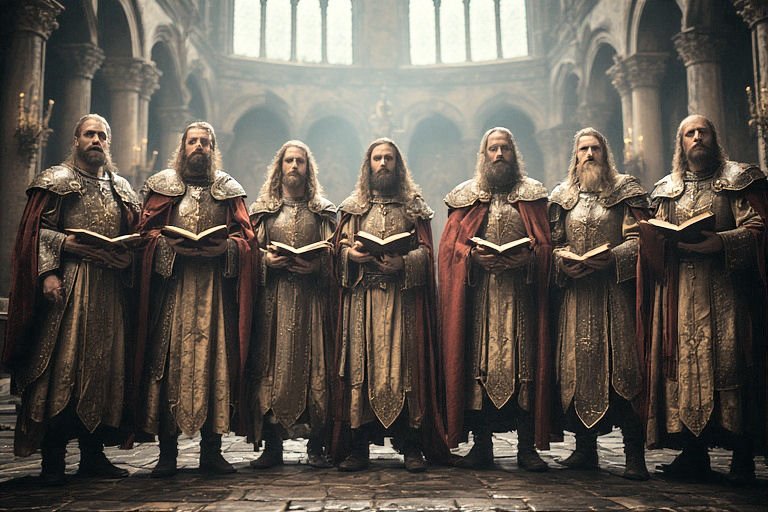
“So, now we’re told that the Rich Fisher’s court was actually found seven times, not never, or once by Gawain or three times by Perceval. These discoveries are then linked to seven branches of “the story.” Usually when any kind of source is referred to in the Grail stories, it’s ‘Le Grant Conte’ which, just like the Mabinogi, had several ‘Branches’ and who’s hero was Gawain, not Perceval. It’s tempting to assume that these seven stories were all about King Arthur and his knight’s quest to find the court of the Rich Fisher and the Grail, but we’ll have to see about that later.
In yet another contradiction, these seven branches are actually not themselves stories, but the same guardians who were mentioned right at the beginning, “Who throughout the world have charge of all the good stories that have ever been told.” We’re then told that the narrator is about to identify and describe these guardians, “All in order, from beginning to end…” So, where does he begin? With the seventh guardian, of course. However, rather than being given an identity and description, we’re simply told that it’s a story, “...all about the lance with which Longinus struck the side of the King of Holy Majesty.” This is overtly Christian dogma that has nothing whatsoever to do with the price of cheese or the Rich Fisher. The sixth, without a doubt, is about the great struggle, the great torment (alt. strife of the toil,)” ...so no identity or description again, just another story. “The fifth will tell you in its turn about the wrath and loss of Husdent (alt. Huden,)” but no indication if this Huden was actually a guardian, so just another tale. “The fourth is the Story of the Swan: no coward was Carahet, that dead knight in the skiff who first came to Glamorgan,” again, not an identity, but another story about a deceased knight. “Next is the third, about the goshawk which so frightened Castrar; Pecorin, Amangons' son, always bore the wound upon his forehead,” another story. “The second... is the Story of the Great Sorrows, how Lancelot of the Lake came to the place where he lost his strength,“ clearly a story not the identity of a guardian. “Finally, there is the last story… it is the Adventure of the Shield,” no surprise there then, another story.
OK, so having been assured that the seven guardians were characters who controlled all the best stories in the world and then that the narrator is going to identify and describe them, but doesn’t and instead gives a list of seven other stories, he then tells us, “These are seven genuine stories that all proceed from the Grail.” He then assures us that these stories comprise an “adventure” which restored the Wasteland and how the court of The Rich Fisher and the Grail was found – presumably the court was found seven times, once in each story.
Anyway, we’re told that the land recovered and the water began to flow again. The vegetation and the forests flourished throughout the land. However, you may think this took a little while, but you’d be wrong. “On the day the court was found again, throughout all the land the forests became so dense and deep and so beautiful and thickly grown that everyone who was travelling through the land marveled.” It must be assumed that this happened after the seventh finding of the Fisher King’s court, when someone finally managed to ask the right question I suppose.
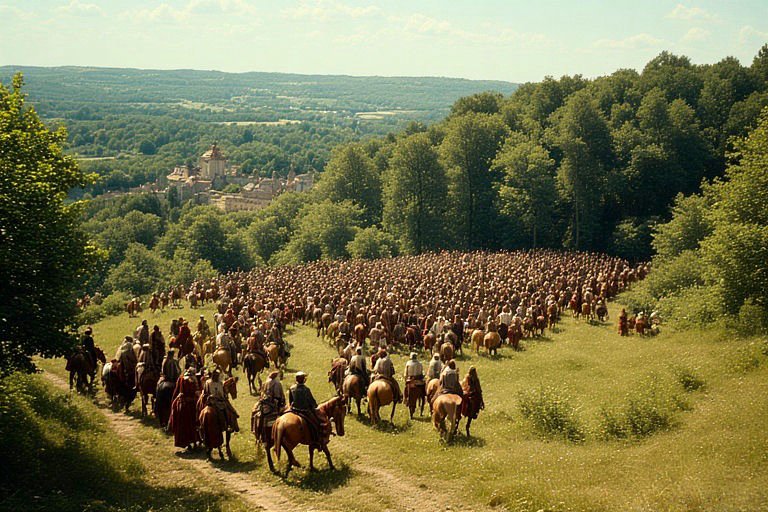
The next part is quite important. “But then there returned a band of people full of bitter resentment: those who had come from the wells (alt. hills, mounds,) but were not recognized.” An alternative translation reads, “Then there came in turn a people full of great ill will, who came forth from the wells but they were not known.” In the first example it could mean that these unhappy people were those who had descended from the Maidens of the Wells, whilst the other claims that they weren’t returning but they actually climbed out of the wells. Perhaps there may be some clarification later.
Whatever the situation, these people, who are referred to as The Rich Company, “...built castles and cities, towns, villages and strongholds, and for the damsels they built the magnificent Castle of Maidens; they built the Perilous Bridge and the great Proud Castle.” Apart from the castles and cities, towns, villages and strongholds, which sounds very much like the Normans in England, the others all sound like ‘otherworldly’ places.
The following lines are quite curious… “Nobly and graciously they (The Rich Company) set over them (the castles etc.) a troop of peers from the rich household; in their great pride they set up in opposition to the Round Table; this became known to everyone.” That comes from the 1931 translation.
The 2019 translation reads, “For nobility and lordship, they created an order for themselves of the Peers of the Rich Company, in their great pride set up against the Table Round; it was well known by everyone,” which is quite different as it omits the ‘troop of peers from the rich household” who were set up to defend the castles. It also makes it sound as if the “Peers of the Rich Company” comprised the opposition to the Round Table.
The word ‘peer’ can refer to a person who is of equal standing with another in a group or specifically in British English, a nobleman (duke, marquis, earl, viscount or baron) who is a member of the British ‘peerage’. The word ‘household’ in reference to a castle or country estate, refers to the domestic staff who run the day-to-day affairs, such as cooking, cleaning and more to the point, security and defence. “The Peers of the Rich Company” could refer to the nobles within the Rich Company, although this new order was created “For nobility and lordship,” in other words to create nobility. “A troop of peers from the rich household” sounds more like they recruited able bodied men, like themselves (their peers) from the castle’s household and formed them into a troop of fighting men to defend their castles. It’s perfectly reasonable to assume that the massive building program of “castles and cities, towns, villages and strongholds,” required the recruitment (or enslavement) of local labour – humans who had not come from the wells, therefore “the rich household” translation would seem more likely, especially as the Rich Company itself would be too busy fighting against The Round Table to build anything themselves. However, there’s the time factor again, because just like the restoration of the forests, the appearance of the castles, towns and villages etc. seems to have been instantaneous. This is something we will deal with later.
Next comes more incompetence and vagueness, “Within the castle each knight had his ladylove; they led a splendid existence,” (1931.) “Therein each had his lady love; many thus led a fine life.” This obviously refers to a specific castle and we can only assume it to be the Proud Castle… as The Castle of Maidens wouldn’t have men in it… would it? We’re then told that there were 366 nobles, or lords, of the castle who each had charge over 20 knights, giving a total of “7,686”… except it doesn’t, 366 multiplied by 20 gives 7,320. Either way it’s frankly a ridiculous number for one castle when you consider that each knight also had a lady love, which could mean either another 366 or 7,320 maidens, plus all the domestics.

Maiden Castle, Dorset, England
Source
“They exerted themselves mightily, but in vain; know well, all you who live in the world, that you wouldn't find any of them alive today,” (1931.) “To deny that these things happened, know this, through all the world, that you won't find any such today,” (2019.) Quite a difference there and it’s worth bearing in mind the idea that none survived, as the conclusion of the story doesn’t really agree with that.
So, the Rich Company rode throughout the land making war on Arthur and The Round Table. “The good knights” (without Arthur) set off to sort them out and when any of them were captured, the Rich Company held him prisoner. Arthur wanted to attack “the castle,” presumably to free his captured knights, but there’s no real indication as to which castle, so we have to assume it’s the Proud Castle.
Now we come to a surprising section of the poem. “But everyone who hated him in those days attacked him at that point and made mighty war against him,” (1931.) “But all those who hated him attacked him at every point, and kept him engaged in the wars,” (2019.) This obviously doesn’t refer to the Rich Company, as using the phrase “everyone who hated him in those days” carries a much wider implication. Subsequently, we are given the impression that the tide of insurrection against Arthur was so great that it lasted 4 years and prevented the Round Table knights from engaging in quests to find the Rich Fisher’s court, and also any attacks on the Rich Company’s ‘castle’ to free Arthur’s captured knights. But, hang on a minute… why would any further quests be required if the land of Logres had already been restored? No makie sensie.
There then comes another strange section, “So the story tells us, as does he who wrote the book (‘this’ book and if) I tell them to you one by one because (for) he wishes to show each of you what purpose (in what way) the Grail served, for the service it performed was revealed to him by the good master. The good purpose it served will no longer be hushed or hidden, for he will teach it openly to all.” If this is a prologue to ‘Percevalus’ then the “he” must be Chrétien de Troyes and his “good master” Philip I, Count of Flanders , otherwise it’s Master Bilhis.
The following lines give conformation that “everyone who hated him in those days” comprised more than just the Rich Company… “So you have heard from me about King Arthur, how he was at war for four years against the people of his land.” However, Arthur prevailed, although the manner in which he did so sounds rather strange… “But he brought all this to an end in such a way that no vassal or neighbour failed thereafter to do his will, either freely or by force; this is the proven truth. Know, moreover, that the war redounded to [affected for good or bad] the king's honour and to their shame, as most people know.” This final part may be clarified by the 2019 version, “But know that it was named to the shame of them and the honour of the king, as most people know,” proving that the victor always writes history and makes himself look good.
Once again we have the distinction “against the people of his land” (“people of his country” 2019) in reference to the people who hated him and kept him busy with war for 4 years, thus preventing him from dealing with The Rich Company, obviously because Arthur was in a different country to The Rich Company – i.e. in his land or his country, not in Logres.
And then, it was all over, “Then on that day the rich household took leave of the court and went to hunt in the forests. Those who wished to fish followed the good rivers. This was how they comported themselves (Just so are the people of good upbringing): Some spent time playing at love, some passed their time in other ways. They relaxed thus the entire winter until the summer came.” (Brackets are 2019 differences.) It seems strange that they should choose to live outdoors for the winter, or maybe this is an indication of the pre-cataclysm mild climate? At this point the prologue then hands over to Chrétien de Troyes.

It’s very interesting to note the way in which the narrator / author sometimes treats the Rich Company with distain, but at other times with respect. There may be a valuable clue in that, along with the fact that the name ‘Rich’ Company must have some relation to the Rich Fisher, particularly as they both come from The Otherworld. Maybe they have a relation to the narrator of the poem?
Well, the first business of the day is to try and sort out where the bloody hell Logres was. I know the official line is that it’s King Arthur’s Realm or Kingdom, but that doesn’t make any sense in the context of The Elucidation. Searching on the internet vomits a plethora of contradicting theories and I could spend loads of time presenting them all, but by the end nobody would be any the wiser – least of all me. All of the scenarios that rely on Roman or Anglo-Saxon invaders and Latin or Greek elements can safely be discarded.
In Chrétien de Troyes’, ‘Perceval’, which is supposedly the continuation of The Elucidation prologue, he describes it as "The Land of Ogres" (L'Ogres,) which isn’t very convincing really as it aught to be ‘Terre des Ogres’. “To the Welsh, Lloegyr was a foreign land with a foreign populace, distinct from the lands and peoples of the Cymry. Cymry is the Welsh word for themselves, and historically included all of the Britons living north and west of Lloegyr, south of the Scottish firths of Clyde and Forth, and not including the people of Cornwall and Devon. (Source) Geoffrey of Monmouth used this specific division in his stories of Loegria. However, it's very much a post-cataclysm division and not necessarily relevant to the period we are concerned with.
Mind you, there are other theories claiming the exact opposite – that Logres was the name given to Devon and Cornwall as Arthur’s kingdom… which falls in line with many Arthurian stories.

(not) my work, CC BY-SA 3.0
“Logres was sometimes known in Arthurian Literature (especially in the Lancelot-Grail — Vulgate Cycle) as the 'Kingdom of Adventures'. Logres equates to the Kingdom of Lystynoyse (Lystenoyse, Lystyne(y)s(e)), Ly(s)tenoys(e), and Listonei(s) (Lystenois, Lystenoys,) as found in Malory, the Prose Merlin, and Arthour and Merlin, respectively; to Malory’s ‘Waste Land’ (‘Waste Londe’), the Prose Merlin’s ‘Waste Londes’, and Henry Lovelich’s History of the Holy Grail’s ‘Wastable Lond’” (Source)
“Logres means the ‘Lost Lands’ or ‘Lost Territory’ (as mentioned by Neil Whalley and Timothy Venning, respectively, among others), referring to the land lost during the Anglo-Saxon conquest (in one instance, the loss of territory around the upper Severn valley to the Anglian Kingdom of Mercia in the mid-seventh-century) (ibid.)
We can ignore the Anglo-Saxon conquest nonsense, but Lyonesse could be a candidate as it is indeed a Lost Land. There’s also much speculation that Logres refers to London, or ‘Londres’, but again, it’s not very convincing.
I’m going to reserve judgement upon the location of Logres until much later on, as my hypothesis relies upon stuff I haven’t told you yet.
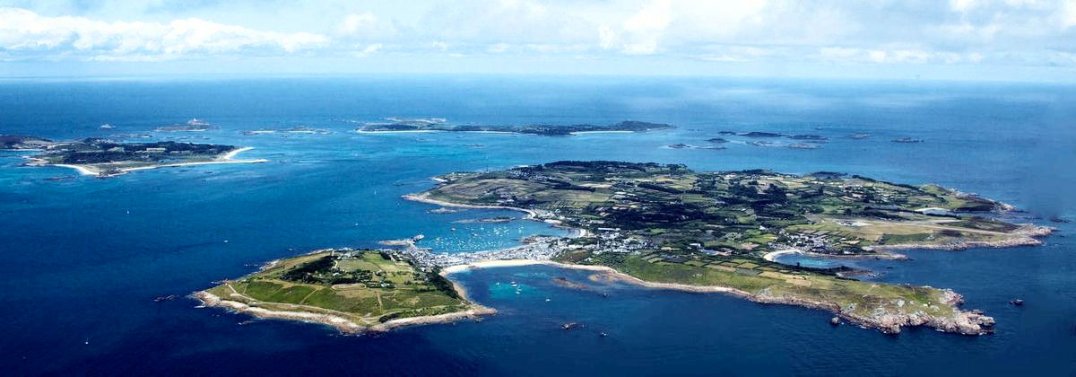
What remains of Lyonesse
Source
Jessie L. Weston, in her 1919 book, ‘From Ritual to Romance’, also discusses The Elucidation…
“For 1000 years the land lies waste, till, in the days of King Arthur, his knights find maidens wandering in the woods, each with her attendant knight. They joust, and one, Blihos-Bliheris, vanquished by Gawain, comes to court and tells how these maidens are the descendants of those ravished by King Amangons and his men, and how, could the court of the Fisher King, and the Grail, once more be found, the land would again become fertile.”
Unfortunately I have no idea what version of the MS she was quoting from (perhaps one that has since been lost or disappeared into a private collection,) but the 1000 years between the ravaging of the Maiden by Amangons and the coming of Arthur and his knights, is missing from the translations I have been working from. However, it does offer some clarification to the whole business of the timeline, although it does make a nonsense of the passage where The Knights of the Round Table are hunting down Amangons’ men, because he was a-man-gone… long gone, unless of course he and his men were not ‘of this world’, but The Other.
Concerning the identity of King Amangons, I bow to the superior knowledge of John Matthews who has done a superb job of researching this figure throughout all of the Arthurian legends and beyond. Rather than get involved in identifying them all, the following summary expresses perfectly the concept of some form of Otherworld influence behind the provocation of the Wasteland phenomena, as has been proposed before on this website. As mentioned earlier, in order to be capable of overwhelming, abusing and enslaving one of the Well Maidens, Amangons must have been at least partly Faë himself.
“In considering these widely various figures [various Amangons types], whose only connection seems to be their name, we may note that most live in a faery castle, or rule over a land of no return, or have otherworldly powers. In this way, they each have something in common with the most prominent of the anti-Grail Kings. There seems to be the shadowy outline of a single figure who stands behind most of those listed here. Taken as a whole, the lineage of the anti-Grail Kings looks back to a coherent image of an otherworldly king of great power who, when he encountered the Maidens of the Wells, took what he considered to be his by right.” (‘The Lost Book of the Grail’, J.Matthews)
This embodies the post-cataclysm Feudal System reality, whereby popes and kings took what they considered to be theirs by right. It provokes the image of “the most powerful poison as there could be in the world” as initiated by Taliesin.
As noted previously, the whole “seven guardians” business is a mess. One minute they’re actual characters and the next they are seven branches of the Grail story. Fortunately, once again, John Matthews has done a magnificent job of making sense of it all in his 'The Lost Book of the Grail’.
“The nearest we will get to seeing those who told this story can perhaps be seen on the opening page of the Mons manuscript of The Elucidation, which shows a faint rectangular miniature at the top of the page: on the left, a knight on horseback approaches a crowned figure, whom we must see as Arthur; beside him, to his left, are seven figures—the seven guardians of the story!” (Source: 'The Lost Book of the Grail' by John and Caitlín Matthews.)

As the Elucidation progresses it becomes clearer that the promised guardians are in fact closely related to the seven occasions that the Grail was found. Therefore, each of the seven branches of the main Grail story must be the accounts of those seven discoveries. However, personally I’m going to immediately dismiss the seventh branch, which is the ‘The Story of Longinus’ and the lance. Whilst it may, or may not, have some kind of spiritual significance to certain people, it has no relevance here and must have been inserted over the original ‘branch’ which is now lost to us forever.
The sixth branch is “The Great Strife of the Toil,” which is too vague to provide a definite identity. Personally I favour the idea put forward by John Matthews, that it refers to the period commencing with the 4 years of war against The Rich Company and the people of Arthur’s own land. This is somehow paralleled by the fictitious Roman and Saxon invasions which, according to later legends, ended with Arthur becoming The Wounded King and his land the very Wasteland we are still living in today. John Matthews cites a very interesting tale by the Mallorcan Guillem Torroella , written sometime between 1360 and 1370, called somewhat unimaginatively, ‘La Faula ’ (the Tale.) It is, “a magnificent mélange of surreal adventures, including the voyage by the hero/author on the back of a whale, to the island of Morgan la Fay. There Guillem encounters Arthur, lying on his bed of pain, his wounds yet unhealing, his life preserved by a yearly visit from the Grail! This hitherto unnoticed account makes it clear that Arthur was at one time perceived as a type of the Wounded King—perhaps as a Grail King—but this appears to have been a storyline that was not developed beyond this time.” (ibid.)
If this explanation is correct, it relates more to the subsequent loss of the Grail, than it’s discovery.
The fifth branch is “The anger and loss of Huden / Husdent.” Unfortunately this is far too obscure to be of any use.
The fourth branch, or guardian is, or rather are, “The Stories of the Swan,” concerning a dead knight in a skiff who went to Glamorgan. Unfortunately, Glamorgan didn’t exist until 1080 when the Normans conquered what was Glywysing in South Wales. Anyway, rather than going into details, the gist of the stories is that a dead ‘Wounded King’, the semi-faë Brangemor, is brought from the Otherworld in a skiff, towed by a swan, to the shores of Glamorgan. Meanwhile, another knight belonging to the Round Table is manipulated into a similar situation to that which ended in Brangemor’s wounding and shame. The knight becomes a surrogate for the dead ‘Wounded King’ and through the machinations of a dwarf, is manipulated into killing Brangemor’s slayer with the same weapon, causing the same wound. Brangemor’s shame was thus avenged and his corpse was able to be returned to the Otherworld by the same swan that brought him from it. Note the ‘Bran’ motif, perhaps this was Bran returning from the Otherworld to avenge his shame. Mind you, the severed head element is missing from the story as is the wound being to the ankle.
The third branch is The Hawk that scarred Pecorins, the son of Amangons, for life. There is no surviving version of any tale with these characteristics… Harry Potter maybe.
Branch two is the Story of the Great Lamentation. This, we are told, relates to Lancelot. Again, this is very difficult to place in relation to the Elucidation, or the Grail legends in general. However, please stay tuned as it may well become clearer later when we examine the role of infidelity in another light.
The Adventure of the Shield is the the first, and oddly the final branch, but “the greatest.” Once again, the only candidates are all based upon tales that are all quite clearly Christian contamination, so the one referred to has either been lost or destroyed.
The definition of the word ‘rich' and its different meanings over time, are quite revealing in relation to its use in the Grail stories...
‘Old English rice "strong, powerful; great, mighty; of high rank" (senses now obsolete), in later Old English "wealthy;" ...German reich "rich," Gothic reiks ("ruler, powerful, rich"), borrowed from a Celtic source akin to Gaulish "rix," Old Irish ri (genitive rig) "king," from Proto-Celtic *rix...
‘...The form of the word was influenced in Middle English by Old French riche "wealthy, magnificent, sumptuous," which is, with Spanish rico, Italian ricco, from Frankish "riki "powerful," or some other cognate Germanic word. Old English also had a noun, rice "rule, reign, power, might; authority; empire" (compare Reich). The evolution of the word reflects a connection between wealth and power in the ancient world, though the "power" sense seems to be the oldest…
‘In transferred and extended senses from c. 1200. The meaning "magnificent" is from c. 1200; that of "of great value or worth" is from mid-13c. Of food and colors, "having an abundance of a characteristic quality that pleases the senses," from early 14c. The noun meaning "the wealthy" was in Old English ...English once had a related verb rixle "have domination, rule,’ from Old English rixian "to rule."’ Source
These days one can’t help but associate the word with material monetary wealth, but as seen from the above, that wasn’t always the case. Even today the Spanish word “rico” is used more to describe taste – both the physical sensation and ones choice in material objects. I would suggest that the sense of its use with The Rich Company and The Rich Fisher, has more to do with "strong, powerful; great, mighty; of high rank" than being ‘filthy rich’.
The Rich Company are an intriguing element within The Elucidation. Bleheris was defeated and paroled by Gawain and we later learn that he is of the lineage created by Amangons when he violated the Maiden. As the offspring of two Faȅ beings, he cannot be considered ‘human’ and this explains how he could still be alive after the maybe 1000 year period between the Amangons event and the days of King Arthur, although obviously he still appears to be human otherwise someone would have noticed. If we think about this in terms of gene pools, which may be rather silly on the one hand as we’re dealing with non-humans, then we get a 50-50 mixture of good and evil. As this same lineage grows then the gene pool would become more diverse and the good to evil ratio would vary wildly. The Rich Company are the result of this more diverse genetic ratio. To be honest, and I don’t really know why, they remind me of ‘The Gentry’.
So, what happened to the Rich Company and how were they vanquished? Well, The Castle of Pride is a prominent feature in Arthurian legends. In the First Continuation of Chrétien de Troyes unfinished Perceval, the story of Proud Castle’s fall begins 10 years before it happened. In a revealing scene whereby the lords, or rulers, of the surrounding countries come to pay homage to Arthur – clearly showing that he was an Emperor, not merely a king, there’s one who is conspicuous by his absence – Brun de Branlant (Bran-land?) Following some indecisive battles, Arthur orders the siege of Brun de Branlant’s castle and, in a very Norman fashion, decides to starve it into submission. This takes seven years (?!* what were they doing, eating the furniture?) during which time Arthur took control of the port supplying Castle Branlant and built 3 castles nearby. This has the effect of turning the surrounding countryside into a Wasteland.

Following the recuperation of a severe wounding by Brun de Branlant, Gawain goes out riding in search of “some rare encounter.” It doesn’t take long for him to find one in the form of a beautiful maiden lying in a bed inside a pavilion. She just happens to be a huge fan of Sir Gawain and even has a detailed embroidery of his face – by which she recognises him… like a poster on her bedroom wall. One thing leads to another and, following the customary cigarette the morning after, Gawain takes his leave, promising to return.

Norroiz de Lis, the girl’s father, arrives at the pavilion shortly after and discovers that she is no longer a ‘maiden’. He then takes off after Gawain determined to kill him, not only for deflowering his daughter, but also for killing his brother (although it isn’t clear exactly who that was.) When they fight, Gawain leaves Norroiz de Lis for dead. Then, in yet another appearance of the name ‘Bran’, Bran de Lis gets involved, he being the deflowered maiden’s brother, and he sets off after Gawain’s blood, as you might expect. Their fight is evenly matched, until Gawain’s previous wound opens up, so Bran de Lis agrees to postpone the fight for a later date. Gawain leaves Bran de Lis with a pregnant sister and a dead father (plus maybe an uncle or two,) then returns to Arthur for another 6 months convalescence, during which time Brun de Branlant finally submits to Arthur after seven and a half years with only the furniture to eat.
Another 10 years pass during which time there’s an episode in the prose called ‘The Great Tournament’, which actually features Gawain and Bran de Lis fighting on opposite sides, but not against each other, strangely. In fact, it’s as if the previous events had never happened. There’s also a malicious type of chastity test. Which we will talk about later, but what’s conspicuous by its absence is the discovery of the Rich Fisher’s Court of Joy and the recovery of the Wasteland, which precipitates the arrival of The Rich Company. However, we do finally get to the mission to be rid of Proud Castle and its Rich Company.
After a ride out with his closest companions, Arthur is obviously preoccupied and lags behind on the return journey. He confides in Gawain that he wishes to repay his men for their excellent services. To this end he summons all the lords
to Carahes (?) for a feast. All those in attendance are seated at the Round Table, but three are absent. When Arthur notices this, he suddenly plunges his knife into the table, wounding his own hand in the process. He wraps his hand in a cloth and tries to hide it from the assembled guests without much success. Gawain notices and admonishes Arthur for behaving in such a shameful manner. Arthur ‘blows his top’, saying that he has been provoked by all the treachery and envy of the knights, which causes an uproar and demands are made for an explanation. Arthur replies, insisting that it was due to them having confronted the enemy who then overwhelmed them before he could get to the scene. He mourns the lives lost, and those captured. So, it’s clear that he blames his knights for his own failure to get off his backside and fight with them. Arthur is concerned about one knight in particular, Girflet, who has been held prisoner for three years and decides, there and then, to go and rescue him. Curiously, all the knights agree they have been treacherous and cowardly.
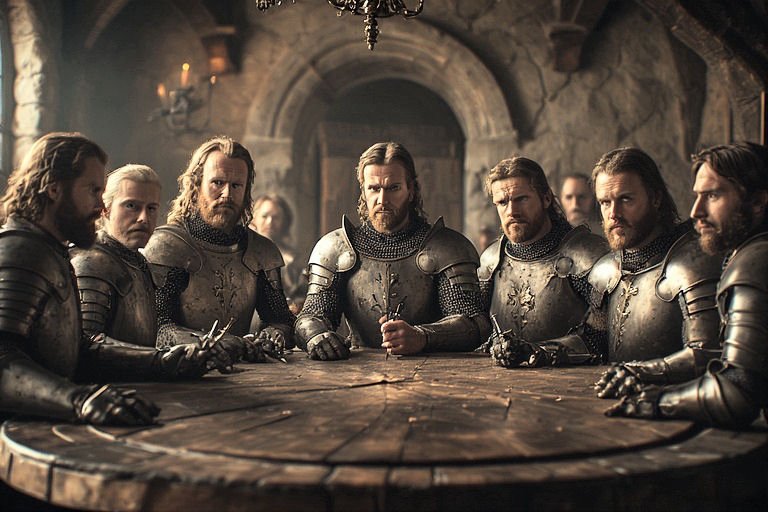
Arthur sets out on the long journey to Proud Castle (Castle Orgueilleux) with a small party of fifteen men and they ride through a Wasteland (?) with little to offer in the way of shelter or food… it’s at times like this that The Maidens of the Wells were sorely missed.
On the journey there’s a strange adventure involving Sir Kay (who ends up scarred for life,) a dwarf, a peacock and a knight with a dog, who eventually gives them shelter for the knight ...I mean night. The most significant thing about this is that when the knight offers to join Arthur’s party, he is refused on the basis that Arthur only wants knights from his home land, which shows once again that The Proud Castle of Logres was in a different land to that of Arthur’s court.
After another day without food or lodgings, they take refuge in the Garden of Tombs, which was a beautiful cemetery with ‘wonders indescribable’. Refreshed, they continue on until the Wasteland gives way to fertile green pastures. That evening they notice a trail in the long grass which must have been made by a company of around 100 men. Gawain scouts ahead, following the trail and then sees the riders on a distant hilltop – 100 of them were busy jousting. Gawain sets off to introduce himself, but by the time he arrives they have all gone. He then spots them riding down the hill towards a river and the “most handsome city he’d ever seen.”

Gawain reaches the bridge that crosses the river and notices a fountain in a small grove of nearby olive trees. Two Maidens dressed in purple tunics were busy filling their golden vessels with water from the fountain. Gawain greets them both and enquires as to whom they were taking the water for… or for whom the water was being tooken at… or words to that effect. “To the good knight whom we follow, nor for any other do we pour,” came the reply. This was obviously a cameo of the fate that had befallen the Maidens of the Wells, whereby Amangons and his men had taken ownership of the Maidens and their services, for their own personal pleasure – this had obviously become the accepted custom for the subsequent generations.
Inside the rich and elaborately decorated city, which was such like no man had ever seen before, were draped beautiful tapestries. There were currencies of every land (what a strange thing to say,) the most beautiful goblets and cups. Every door was open, and it was then he noticed that there wasn’t a living soul around, so he continued to the Castle. He entered a hall full of tables spread with gorgeous linen. The tables were set and the food was ready but again, there was no one around for him to enquire about “hosting the king.” I have to admit, I find all this very strange – it’s obvious that this castle belongs to one of the Rich Company with whom Arthur is supposed to be at war, so what the whom is Gawain doing asking for food and a bed for the knights ...or the night? Anyway, Gawain decides to go back to the Maidens outside to ask about the bed and breakfast facilities, but they have vanished.
So, with nobody at Reception, Gawain leads Arthur and the knights into the hall of the castle. This time he notices a shield with its colours and immediately recognises them as belonging to the Bran de Lis clan. Gawain confesses his previous misadventure to Arthur and states that he would have married the mother of his child, but having killed both Bran de Lis’ brother and father, and maybe even uncle, there will be no option but to fight it out. Gawain’s confession is very different to the original version of events described earlier, which is very odd indeed. Also, the agreement Gawain made with Bran de Lis to postpone their battle until the next time they met is again reiterated, once again totally ignoring the tournament they both previously attended.
There then follows a sudden incursion by a dog, whom Kay wants as a companion for his own dog, Huden (as per one of the guardian branches.) Kay follows the dog into a large garden where he discovers Bran de Lis entertaining a large company. So, it’s his castle then. Before Gawain can book reservations for Arthur and his men, there has to be a fight to the death between himself and Bran de Lis.
The details of whom was the brother of the sister and whom it was that Gawain actually killed are completely confused by the two different accounts of the same event I’m afraid. Anyway, just as Bran de Lis and Gawain began their mêlée, the sister appears with Gawain’s child, whom she then sends into the fray in order to stop the fight between her brother and her child’s father.
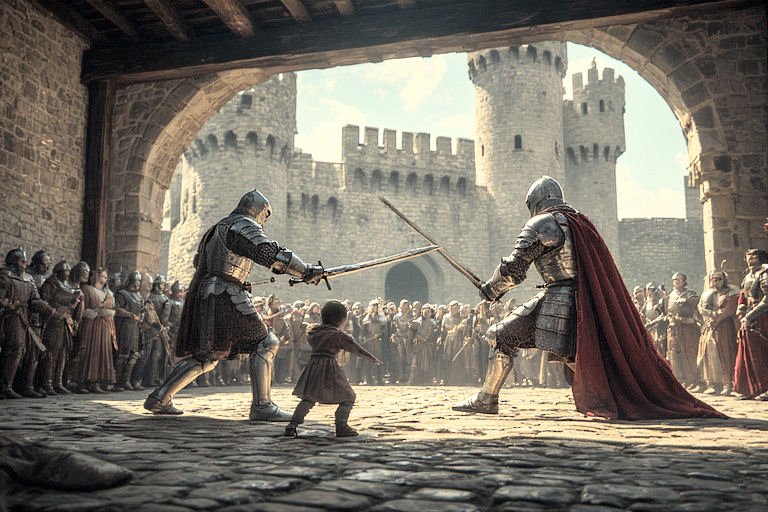
Upon seeing this, Arthur calls an immediate halt to the fight and promises to compensate Bran de Lis for his loss and whom now finally gives Arthur his loyalty and respect. Although I thought it was Brun de Branlant whom refused to attend the audience with Arthur 10 years previously? Also in another version, the child is only five years old by the time of the battle with Gawain and “Sir Bran de Lis then asked for the Knights of the Round Table to pledge loyalty to him and King Arthur agreed.” Eh?
It’s then confirmed that Ban de Lis is one of The Rich Company as, when Arthur reveals his mission, Bran confirms that Girflet is alive and still being held captive within Proud Castle. He is also able to furnish them with as much information about the Rich Company and the Proud Castle as they could wish.
It took seven days to reach Proud Castle from Bran de Lis’ city. Upon their arrival, the castle began calling in reinforcements whom came in vast numbers. There are no battles though as all the fighting is undertaken on a one-to-one basis and subject to the rules of The Joust, which include not stepping over certain lines or entering certain areas unless it's to fight. Saturday is a no jousting day because it’s “a time when the Mother of God is worshipped” in Proud Castle… whom are you kidding?
On the following day, Arthur’s gang go hunting… or in another version it’s on Saturday. Anyway, Gawain ends up following the call of a goshawk into the forest. He finds a fortified tower with a moat and drawbridge. A knight sits outside this tower in moody silence, which he maintains throughout all of Gawain’s efforts to engage him in conversation.
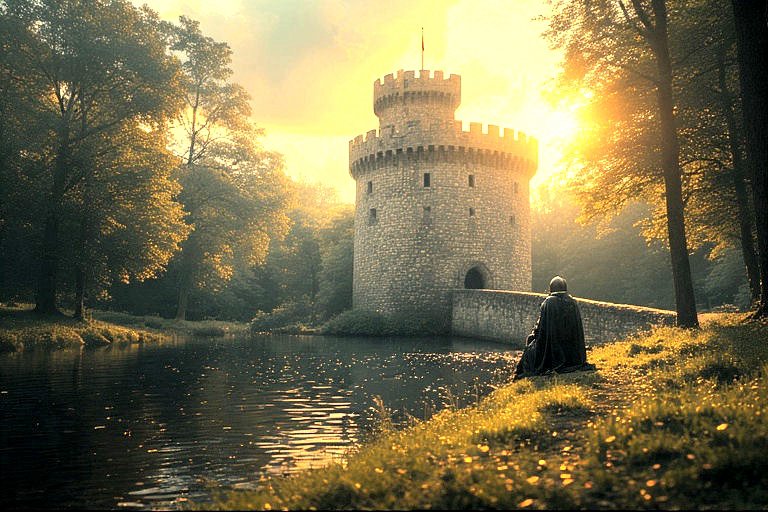
When Gawain gives up and leaves, he meets a lady whom is riding towards the tower. She explains that she fears she may have caused the moody knights death by failing to keep her word to him. Bran de Lis – a fountain of knowledge regarding the Proud Castle and the Rich Company – explains that the silent knight is not only a Christmas Carol, but also The Proud Knight or Rich Soldier – the big cheese of Proud Castle. The lady whom went to meet him was his paramour, with whom he is totally infatuated to the point of physical weakness. That night 20,000 townsfolk descend upon Proud Castle to see their lord bring his lady home for the first time.
Monday arrives and it’s back to work with the jousting. Another knight from The Rich Company is defeated and swears allegiance to Arthur. The next day sees Gawain face the Proud Knight in combat. Thanks to his gift of supernatural strength, which increases as midday arrives, Gawain beat the sh*t out of the Proud Knight who yielded. The Proud Knight realised that his defeat would cause so much shame to his new paramour that she would die of it. So, Gawain agrees to a bargain, whereby he will pretend to yield to the Proud Knight and for this act, the Proud Knight will guarantee that no member of the Rich Company will ever oppose Arthur again. Gawain goes along with this and even offers his sword to the Proud Knight’s Lady, much to the confusion of Arthur and his entourage.
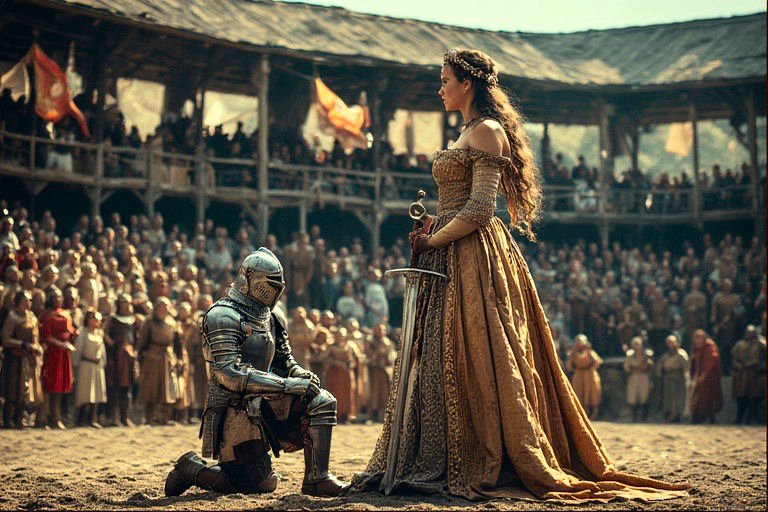
IAll becomes clear when Arthur’s imprisoned knights are released, including Girflet who so pricked Arthur’s conscience. The Proud Knight’s Lady has already left on a shopping mission to establish another castle for herself and her lover and The Proud Knight submits to Arthur, handing the Proud Castle over to him as well.
To discover what happened to the Rich Company after this, we must return to The Elucidation, where it tells us that they all went off to spend the winter hunting, or fishing, doing all of the things that “people of good upbringing” would do, including “paying court to the ladies.”
t’s very revealing to note that Arthur stayed at home during the entire Elucidation poem. Even when he went with his knights to rescue Girflet and defeat The Rich Company, he did not participate in any of the jousts. This coincides with some interesting information provided, once again, by Jessie L. Weston in her ‘From Ritual to Romance’ book of 1919…
She describes a story from Perlesvaus, which is the direct continuation of the Elucidation prologue. She also states that this same tale “is twice referred to in texts of a professedly historical character.“
“The tale runs thus. King Arthur has fallen into slothful and faineant [WS: ‘lazy’] ways, much to the grief of Guinevere, who sees her lord's fame and prestige waning day by day.”
If we consider Guinevere’s actual status as an Ælfgifu, or earthly representative of the Goddess of Sovereignty, then we can understand her concern, but this is a thoroughly Christianised story, of course, Euhemerism dictates that all characters must be fully human. In order to “restore his reputation,” or ‘quest-ion’ his continued suitability to rule, she suggests that he undertakes a quest to the Chapel of Saint Austin, which is apparently a “perilous adventure.” No doubt Saint Austin, the patron saint of British Leyland, was actually a Pagan deity who had been redefined. Arthur agrees to go, but says he will only take one squire with him due to the danger involved… not sure I can see the sense in that, but still. He calls a youth called Chaus and tells him to be ready to ride at dawn. Not wishing to oversleep, Chaus waits fully dressed in the hall, but falls asleep. He awakes at some point and panics when he thinks the king has gone without him and so sets off after him, following what he believes to be Arthur’s tracks.
Eventually he arrives at a churchyard set in a forest glade. Within it he finds the Chapel and enters expecting to find Arthur, but instead sees the body of a dead knight upon a bier, lit by candles burning in golden candlesticks. He takes one of the candlesticks and stuffs it in his trousers and then rides off to find Arthur.
Before long he meets an unsavoury looking man dressed in black, carrying a large two-edged knife. Chaus enquires as to whether he has met with King Arthur. He replies in the negative, but says that instead he has met a thief and a traitor who has stolen the golden candlestick – Chaus. He advises Chaus to give up the candlestick or pay dearly.

“Is that a candlestick in your pocket,
or are you just pleased to see me?”
Chaus decides to pay dearly, and so he awakens with a loud cry in the hall back at Arthur’s court in Cardoil (Carlisle) with the knife in his side and the candlestick still in his trousers. He lives just long enough to tell the tale (of course,) and Arthur donates the candlestick to the newly-founded Church of Saint Paul, "for he would that this marvellous adventure should everywhere be known, and that prayer should be made for the soul of the squire." It seems it also saved Arthur from having to undertake the quest himself, but I’m sure Guinevere would have had a few words to say about that.
The story was certainly well known, and appears to have been accepted as a genuine tradition. Thus the author of the Histoire de Fulk Fitz-Warin also gives a resume of the same adventure, and “asserts that the Chapel of Saint Austin referred to was situated in Fulk's patrimony, i.e., in the tract known as the Blaunche Launde, situated in Shropshire, on the border of North Wales.”(Jessie L. Weston) As source for the tale he refers to ‘Le Graal, le lyvre de le Seint Vassal’ (The Grail, the book of the Sainted Vessel [?]) He goes on to state that here King Arthur recovered ‘sa bounte et sa valur’ (his goodness and valour) when he had lost his knighthood and fame.“ I don’t really understand how the death of his squire by supernatural means could restore Arthur’s goodness and valour. I mean, what did Arthur do? Bugger all except donate a candlestick that his squire liberated, to a church.
“This obviously refers to the Perlesvaus romance, though whether in its present, or in an earlier form, it is impossible to say. In any case the author of the Histoire evidently thought that the Chapel in question really existed, and was to be located in Shropshire. But John of Glastonbury also refers to the story, and he connects it with Glastonbury.” (JLW)
Jessie L. Weston was puzzled over how “so wild, and at first sight so improbable, a tale” could achieve a semi-historical character, and be connected with a definite and precise locality, given that the vast majority of Grail stories cannot be tied down to any physical location. After much research, she came to the conclusion that “the author of the Histoire de Fulk Fitz-Warin and most probably also the author of the Perlesvaus before him, were mistaken in their identification, that there was no tradition of any such Chapel in Shropshire, and consequently no tale of its foundation, such as the author of the Histoire relates.” However, she was able to discover that in Northumberland, another ‘Blanchland’ exists that also has a connection to King Arthur, and numerous dedications to Saint Austin, who also apparently drove out the local demons, “closely analogous to the tale told of the presumed Shropshire site,” although I must have missed that part.
“I therefore suggested that inasmuch as the Perlesvaus represented Arthur as holding his court at Cardoil (Carlisle), the Northern Blanchland, which possessed a Chapel of Saint Austin, and lay within easy reach, was probably the original site rather than the Shropshire Blaunche Launde, which had no Chapel, and was much further away.” (JLW)
Regardless of Arthur’s actual lack of action, what is most interesting is the fact that the tales of that same event have maintained a semi-historical status, including the record of Arthur’s “slothful and faineant ways” and that he had lost not only his goodness and valour, but what’s even worse, his knighthood and fame. Given that the original quest was set by Guinevere in order to test his continued suitability regarding the sovereignty of the land, she must have been most disappointed to discover that he never even went on the quest, but instead put his own ‘spin’ on the squire’s adventure, or rather misadventure, and claimed all the glory, even though it cost the squire his life.
In both ‘Arthurian Magic’ and ‘The Lost Book of the Grail’ by John & Caitlín Matthews, other similar ‘tests’ are noted throughout the Arthurian tales. In ‘The Wedding of Sir Gawain and Dame Ragnall’, Gawain must marry a hideous ugly hag to save the life of Arthur. This he does and on their wedding night, Gawain’s new bride turns into a ravishingly beautiful woman. However, this change is not permanent, he must choose whether she should be ugly during the daytime and beautiful at night, or vice versa. He decides to allow her to make the choice for herself and in doing so he breaks the spell, having given her the right of “sovereignty” – to choose her own appearance according to her own nature and not exerting his own will over her. This is an allegory for the Goddess of Sovereignty, the representative of the land itself testing the fitness of her earthly consort to rule. In the story, Gawain acts as Arthur’s surrogate, and is, at the same time, established as the Champion of the Goddess, who through him offers her blessing upon the land. This situation is perfectly acceptable in Celtic culture as the relationship of a sister’s son was considered of equal or even greater worth than ones own direct offspring.

Katy Mcgrath as Morgana in the
‘Merlin’ TV series of 2008. Source
In the later Arthurian romances, and also many of the ‘tackier’ modern ones, Arthur unwittingly fathers a child upon his half-sister Morgause, who is usually attributed a magical background and is also the sister of Morgan Le Fay (Faë.) If we remove the Euhemerism, then it’s clear to see the same issue of Sovereignty at play again. In this instance Mordred is the son/nephew who ends up being Arthur’s bane. Obviously, for whatever reason, (normally because Morgan / Morgana is usually portrayed as an evil witch, or out of pride,) Arthur refuses to acknowledge the right, by Celtic law, of his 'sister’s son', Mordred, to rule. This denial alone would be enough to break Arthur’s ‘contract’ with the Goddess.

"The head of Bran the Blessed (London)." George Arents Collection,
The New York Public Library Digital Collections. 1850 - 1959. Source
Regular readers will know that I’m no fan of the ‘Welsh Triads’, however, there seems to be a general body of agreement concerning the burial of the Head of Bran the Blessed. For one thing, it’s confirmed by the Mabinogion as having been being buried there at Bran’s request. That Arthur dug it up on the grounds that only he should defend the land is mentioned in the Triads, but it’s clear from the cigarette card, pictured above, that there was a whole other version kicking around in 1850…
“The story of Bran the Blessed tells how he brought Christianity to Britain after his own and his sons’ captivity in Rome. He ruled wisely and well, and so firmly he held the trust of his people, that, at his death, they placed his head under the White Mount of London, facing towards France, where lay the chief menace of invasion. But King Arthur, much to the concern of his people, dug up the head and reburied it facing another way. He disdained to hold the land by any other means than the strong arms and trusty steel of his Table Round.”
Regardless of the Christianity nonsense and the Rome nonsense, the outcome is the same – Arthur dug up the Head of Bran the Blessed because of his own personal ego. So, not only do we have the pride and ego element along with the laziness and the loss of his knighthood and fame, but also the arrogance that effectively dissolves his sacred marriage contract with the Goddess of the Land and its Sovereignty. And then...
“By the time we come to the thirteenth-century story of Perlesvaus, or The High History of the Holy Grail, the failure at the heart of the Arthurian kingdom, which is illustrated by the Wasteland, has become more directly linked with the actions of Arthur himself, whose failure to take the initiative in the Quest—leaving it to his knights instead—is to be seen as a failure of will and the empowerment of his sovereignty.” (Source: ‘The Lost Book of the Grail’ by J. Matthews.)
There is one problem with that though, in The Elucidation, The Wasteland only affected the kingdom of Logres and it’s quite clear, (to me at least,) that Logres did not comprise the entirety of ‘England’ – or whatever it was called back then. Logres may well have been one of the kingdoms within Arthur’s empire, but that could place it outside of England entirely. However, this does not detract from Mr Matthews’ main point – Arthur became so unpopular that he was engaged in a war against his own people, which kept his Round Table Knights fully occupied for four years and, rather than fighting in the wars or going on the quest for the Rich Fisher’s court himself, he simply did nothing.
As John Matthews also notes in his “Lost Book of the Grail,” Arthurian literature is full of chastity tests in one form or another. Sometimes these are sent from a malicious source, intent on embarrassing or humiliating Arthur and his knights, but sometimes they are also tests of worthiness for Sovereignty. Interestingly, they all usually presuppose Guinevere’s infidelity.
“We cannot help noting that chastity tests, ...may be signs of the broken Faery Accord,” (Source: ‘The Lost Book of the Grail’ by J. Matthews.)
I met someone once who’s second name was ‘Arthur’. All he knew about the king he was named after was that he had been cuckolded by his best friend. The more I study for Dark Earth Chronicles and other subjects, the less I understand about Guinevere’s supposed infidelity. Chrétien de Troyes himself claimed that the inclusion of the Guinevere-Lancelot affair in his ‘Le Conte de la Charrette’ (The Knight of the Cart) was insisted upon by Marie de Champagne (of the Norman/Angevin/Plantagenets,) one of his royal ‘masters’. She apparently gave him the source material for it, but that has not come down to us. Chrétien was unhappy about this and this is the reason given as to why he never finished the story.

The Lady of the Lake
Source
IIf we examine the story from another point of view, things become clearer. If we remember that Guinevere was an Æflgifu, or representative of the Goddess of the Land and its Sovereignty, then Arthur had actually been ‘unfaithful’ to her, as we have seen previously. Lancelot was raised by the ‘Lady of the Lake’, or Nimue, (Cerridwen / Bride / Brigit.) She had rescued him from danger when he was an infant, taking him away to be raised in the Otherworld. In Ulrich von Zatzikhoven’s ‘Lanzelet’, he is described as being raised by ‘The Queen of Maidenland’, a magical, otherworldly location in which there are no men.
So Lancelot was actually a kind of ‘Good Taliesin’ – a chosen champion of the Goddess rather than a sneaky little thief. It’s also interesting to note a famous story that developed around Nimue, whereby she had a relationship with Merlin, although she later ‘betrayed’ him and trapped him in a death-like state. Maybe she found out he was actually Gwion Bach / Taliesin or another of his ilk?
In the light of all this, it makes sense that Lancelot would step in to protect ‘the land’, i.e. the Goddess, when Arthur had proved himself inadequate. Perhaps this is the source of the Lancelot-Guinevere ‘affair’. It also supports the theory that chastity tests, or even presumed infidelity, may be signs of the broken ‘Faery Accord’.
Not only have the Grail Legends been completely messed up with all of the Christianisation, but also with Norman/Angevin/Plantagenet interference in bucket-loads. You will recall the earlier section regarding the cult of chivalry and the Arthur obsession, well hopefully you noticed something else from the story of the Fall of The Rich Company, given in such great detail above. Arthur’s tactics were exactly the same as those that have been attributed to the Normans – siege, a “scorched-earth” policy, the building of castles everywhere – although they may have been just as fictional as they were in the story. Then there’s all the jousting instead of actual battles – in which, you will notice, Arthur never participated. This is all a transposition of an idealised Norman/Angevin/Plantagenet ‘world’, because these were exactly the people who commissioned the likes of Chretaín de Troyes and many other Arthurian writers, to spread what was actually their propaganda! They were also the self same dynasties who, under the guise of the Crusades, created the Holy Land in the Near East.
But, where does all the spooky supernatural fairy stuff fit in, I hear you say. Well here, right at the very core of everything…
That quote is attributed to Bernard of Clairvaux and refers to the Plantagenet dynasty, although it’s often quoted as being from members of that dynasty themselves.

The Marriage of 'La Belle Melusine'
Source
The origin of the Plantagenet dynasty is weird... the fourth count of Anjou, Geoffrey I Greymantle, encountered (en-count-’ered, get it?) a beautiful maiden washing her hair in a river. He became so enamoured that he kidnapped her and they were married as soon as possible. She was always restless and disinterested in church and never stayed for the Eucharist. Rumours of adultery started and so she was locked up behind guarded doors. It’s claimed that when she was confronted by the transubstantiated body of Christ, she made a deafening scream and transformed into a winged demon and flew away never to return. Another version of her demise claims that she stomped her way through the church floor with her monstrous legs and returned to hell. (How you would react when confronted with the transubstantiated soggy bread body of Christ dripping wine all over the floor?)

Actually, it is quite scary.
In another version, she bore Geoffrey four sons and one day he tried to forcibly prevent her from leaving the church early, as she normally would. In this version she is actually named as ‘Melusine.’ Upon the attempt to restrain her, she grabbed her two youngest sons, flew up to the highest window of the church and vanished through it in full view of the congregation. Neither she, nor her two sons were ever seen again. One of the remaining sons became the ancestor of all the later Counts of Anjou and the Kings of England. (‘Tales From the Long Twelfth Century: The Rise and Fall of the Angevin Empire’, R. Huscroft, 2016)
Gerald of Wales confirms that Richard I (The Lionheart) of England would frequently claim he was descended from a countess of Anjou who was actually the fairy Melusine…
“The Limburg-Luxemburg dynasty (which ruled the Holy Roman Empire from 1308 to 1437 as well as Bohemia and Hungary), the House of Anjou and their descendants the House of Plantagenet (kings of England), and the French House of Lusignan (kings of Cyprus from 1205–1472, and for shorter periods over Cilician Armenia and Jerusalem) are said in folk tales and medieval literature to be descended from Melusine.” (Source)

Melusine
Julius Hübner, Public domain
If we strip away all the Christian sensationalism, defamation and redefinition, it appears that Geoffrey found one of the Maidens, or some similar guardian of a sacred site, and just like Amangons, took her for his own ‘use’. So, was Geoffrey somehow himself descended from Amangons? Could he have been from that same lineage as The Rich Company? That same Rich Company who, rather than being annihilated by Arthur and his knights, were simply incorporated into Arthur’s Empire, where they were free to go about their business, to interbreed with the general populace and pretty much continue the work of the Rich Company Ltd in a ‘business as usual’ way.
While Melusine doesn’t appear explicitly in the Perceval stories, the thematic connections and shared motifs between their narratives, highlight the rich interplay of characters and ideas within Arthurian legend and medieval romance – and, of course, the exact same Norman/Angevin/Plantagenet dynasty was behind all of them. Melusine always gets the blame as being the source of the ‘bad blood’ that flowed through the Plantagenet dynasty... or die-nasty. The eldest of Geoffrey Greymantle’s remaining sons was a wife-beater who treated his subjects violently. His viciousness in war won him the name of Fulk Nerra (Fulk the Black,) which aptly suited his mood and temperament. He was also a prolific castle builder and he visited the Holy Land on four occasions.
Stories and sightings of ‘Melusine’ proliferated throughout the continent. They were all labelled as Melusine returning, rather than being separate water divinities from the Otherworld. I will be returning to Melusine later on in this article, as she still has a lot to tell us...

Fulk Nerra’s son, also named Geoffrey, became count of the Angevins, was nicknamed Martel, and was “a treacherous man in every respect, (who) frequently inflicted assaults and intolerable pressure on his neighbours." He fought with all of his rival counts, most famously with William the Bastard just before he died in 1060, which left the county of Anjou heir-less, bald, and in decline for several years, to the point where they were considering changing the name to Alopecia.
In the early 12th century, Fulk V abdicated as Count of Anjou in favour of his son, another Geoffrey, but this time ‘The Fair’, so that he could become the king of Jerusalem in 1131. His wife became queen, of course, her name was Melisende. From that point on for the next 35 years or so everything went swimmingly for this particular branch of the Rich Company, that was until Richard the I, ‘The Lionheart’, came along. As he was apparently so fond of saying, "From the Devil we sprang and to the Devil we shall go."
It took yet more poems, or ‘Romans’ to whitewash the true character of ‘Richard, Coer de Lyon’ as one of the titles called him. The Victorians would cement the image of the consummate Christian hero in the British conscience much later. Among other things, the romances worked to rectify perceived sinful defects in the historical king’s character, among them rumours of his patricide, homosexuality, and secret alliances with Saladin ...but not the cannibalism. The truth is that he only ever visited England twice as an adult, once in 1176 and again in 1184, before his coronation. He was only mildly interested in England and more concerned with using it as a purse to fund his crusades and the defence of his Continental holdings from Philip of France.
“In the romance, Richard not only slays his enemies, he also eats them. The first instance of this cannibalism comes about as the result of an illness; in this case, the Richard of the romance asks for a ‘leche,’ meaning either a doctor or a cure, from among the English or ‘Sarezyn’. While his illness is historically documented, his cure, the act of cannibalism, is not. The Richard of the poem suffers from fever and an insatiable desire for pork, a food considered taboo to his Muslim adversaries and not available in that region. One of his old knights is depicted in the role of physician, who, unbeknownst to Richard, privately advises the king’s cook… [WS: to cook the severed head of a recently deceased Saracen and serve it to Richard as pork.]” (Source: ‘Jerusalem In Medieval Narrative’, Suzanne M. Yeager 2008)
Richard eats the ‘pork’ and is cured overnight. The next day his new-found super-strength results in the total retreat of the enemy from the battlefield. When he learns the true identity of the pork, he simply laughs and recommends it to his men – probably one of the first food commercials ever…

By Appointment to HRH Richard I Since 1190
His barbarity and depravity increased with each ‘meal’. One is reminded of the ‘Celtic’ cult of the severed head. It’s quite astonishing to note that this portrayal of Richard was totally acceptable in medieval, and later, society, in fact it made him even more popular with the Christian audience who saw his barbarity as an act of piety.
As for King John, who ruled whilst Richard was imprisoned and beyond, well he was nothing less than a total disaster – as a person and as a king. He single-handedly destroyed the Plantagenet dynasty ...but not The Rich Company – they are still here. Perhaps this is the famous ‘bloodline’ much loved by conspiracy theorists everywhere.
It’s clear from the First Continuation excerpt above, regarding the fall of Proud Castle, that Bran de Lis and his clan, were not Faë – they were not descended from the offspring of the original raped Maidens of the Wells, because they were fighting against Arthur ten years before the fall of Proud Castle and therefore did not arrive along with the Rich Company. They were normal humans who chose to ally themselves with The Rich Company. It’s not unreasonable to assume that there were more such allies, and these may have comprised the ‘people of Arthur’s own land’ who made war against him for four years.
Doesn’t this all sound very familiar in a way? What if we equate the dirty deed of Amangons and his men with the fake Roman invasion of England. Then, what if we do the same with the Maidens and their attendant knights in the forests (i.e. Blihos Bliheris) and equate them with the fake Anglo-Saxon invasion of England. Then we can equate the final assimilation of the Rich Company with the highly dubious Norman invasion of England. And there we have three perfect cover stories.
So, exactly who, or what was this mysterious ‘Master Blihis’, who is attributed as being the one who gave the dire warning about how no one should reveal the secret of the Grail, ever? Later in the Elucidation, a certain ‘Blihos Bliheris’ is the name of the Knight of the Maidens captured by Gawain, who then swears allegiance to Arthur, captivates his entire court with his storytelling and inspires the Knights of the Round Table to seek the court of the Rich Fisher. This would enable Blihos and his fellow Maidens and Knights to cease their interminable wanderings and find, “the court from which joy will come, by which the country will be resplendent.” Without the intervention of the Round Table, Blihos and his gang would be rambling around aimlessly until God allows them to find the court of joy. This Master Blihos seems to be telling his own story as both narrator and actor.
Fortunately, the author Jessie L. Weston did an amazing job of researching Master Blihos in her 1919 book, ‘From Ritual to Romance’. She identified two mentions of ‘Bleheris’ in the second continuation of Chrétien’s Perceval by Wauchier de Denain...
“Wauchier definitely refers to the author by name, Bleheris. On the second occasion he states categorically that this Bleheris was of Welsh birth and origin, ‘ne et engenuis en Galles’, and that he told the tale in connection with which the statement is made to a certain Comte de Poitiers, whose favourite story it was, he loved it above all others, which would imply that it was not the only tale Bleheris had told him.”
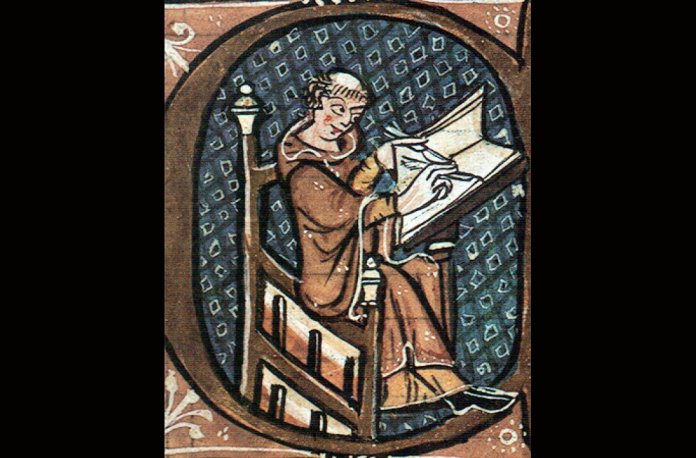
Giraldus Cambrensis looking for the page 3 girl
Source
Amongst the fragmentary remains of Thomas's ‘Tristan’ , she found reference to ‘Breri’ as being the poet’s source of the tale, who knew "all the feats, and all the tales, of all the kings, and all the counts who had lived in Britain." Still more clues are found in the works of Giraldus Cambrensis (Gerald of Wales) who refers to a “famosus ille fabulator, Bledhericus,” (the famous storyteller, Bledhericus,) who had lived "shortly before our time" and there is an implied assumption that he was wellus knownus to his audiensiusis.
“Now are we to hold that the Bleheris who, according to Wauchier, had told tales concerning Gawain, and Arthur's court, one of which tales was certainly the Grail adventure; the Master Blihis, who knew the Grail mystery, and gave solemn warning against its revelation; the Blihos-Bliheris, who knew the Grail, and many other tales; the Breri, who knew all the legendary tales concerning the princes of Britain; and the famous story-teller Bledhericus, of whom Giraldus speaks, are distinct and separate personages, or mere inventions of the separate writers, or do all these passages refer to one and the same individual, who, in that case, may well have deserved the title ‘famosus ille fabulator?’”
In an attempt to circumvent the scorn of “certain critics” who would claim that such references are of no evidential value, she makes the point that “when Medieval writers quote an authority for their statements they, as a rule, refer to a writer whose name carries weight, and will impress their readers; they are offering a guarantee for the authenticity of their statements.” Interestingly, she goes on to say that such attributions may well be fictitious but, even so the person referred to always has an established reputation.
“Thus, the later cyclic redactions of the Arthurian romances are largely attributed to Walter Map, who, in view of his public position, and political activities, could certainly never have had the leisure to compose one half of the literature with which he is credited! In the same way Robert de Borron, Chretien de Troyes, Wolfram von Eschenbach, are all referred to as sources without any justification in fact. Nor is it probable that Wauchier, who wrote on the continent, and who, if he be really Wauchier de Denain, was under the patronage of the Count of Flanders, would have gone out of his way to invent a Welsh source.”
(Please note that last statement regarding Wauchier being under the patronage of the Count of Flanders – it’s the same Norman/Angevin/Plantagenet lot again.)
Miss Weston goes on to reason that the probability of Bleheris being a real person renowned for his storytelling is “extremely probable.” She argues against there being more than one Bleheris on the basis that it’s a proper name rather than a family one. She similarly dismisses the idea that it could refer to a group of ‘bardic poets’, whose office it was to preserve, and relate, the national legends. But we are dealing with variants of a proper name, and that of distinctly insular, and Welsh origin.”
Bledri is the original form of Bleheris and it was a common name in Wales. However, not all of them could have possessed the same qualifications as our particular Bleheris, which Miss Weston lists as being: well versed in popular traditions; blessed with the gift of storytelling; on friendly terms with the Norman invaders; possessed of such a knowledge of the French language to enable the telling of stories in that language.
She makes an additional important and overlooked point. It’s highly unusual to find a loyal Welshman willing to share the national history, or legends if you like, of his country with an invading force. This, combined with the ability to communicate and express a story in French – and be confident of a sympathetic reception, makes our Bleheris an extremely rare beast indeed.
“Mr Edward Owen, of the Cymmrodorion Society, has suggested that a certain Welsh noble, Bledri ap Cadivor, fulfils, in a large measure, the conditions required. Some years ago I published in the Revue Celtique a letter in which Mr Owen summarized the evidence at his disposal. As the review in question may not be easily accessible to some of my readers I will recapitulate the principal points...
“...The father of Bledri, Cadivor, was a great personage in West Wales, and is looked upon as the ancestor of the most important families in the ancient Dyfed, a division now represented by Pembrokeshire, and the Western portion of Carmarthen. (We may note here that the traditional tomb of Gawain is at Ross in Pembrokeshire, and that there is reason to believe that the Perceval story, in its earliest form, was connected with that locality...)
“Cadivor had three sons, of whom Bledri was the eldest; thus, at his father's death, he would be head of this ancient and distinguished family. At the division of the paternal estates Bledri inherited, as his share, lands ranging along the right bank of the lower Towey, and the coast of South Pembrokeshire, extending as far as Manorbeer, the birthplace of Giraldus Cambrensis. (This is again a geographical indication which should be borne in mind.) Cadivor himself appears to have been on friendly terms with the Normans; he is said to have entertained William the Conqueror on his visit to St David's in 1080, while every reference we have to Bledri shows him in close connection with the invaders.”

Carmarthen Castle and the River Towy, Wales (1781)
Thomas Pennant, Public domain
We then discover that this Bledri, and ‘other Welsh nobles’, were actually traitors. “Mr Owen also points out that portion of the Brut-y-Tywysogion which covers the years 1101-20 (especially the events of the year 1113, where we find Bledri, and other friendly Welsh nobles, holding the castle of Carmarthen for the Normans against the Welsh), is related at an altogether disproportionate length, and displays a strong bias in favour of the invaders. The year just referred to, for instance, occupies more than twice the space assigned to any other year. Mr Owen suggests that here Bledri himself may well have been the chronicler; a hypothesis which, if he really be the author we are seeking, is quite admissible.”
Other records show that Bledri was not very popular with his fellow Welshmen. A gang of brothers are on record as having “outraged” his daughter, for which they were fined 7 marks. In the Pipe Roll of Henry I, 1131, Bledri's name is entered as being debtor for a fine incurred by his men for the killing of a Fleming – who were usually employed as mercenaries. So, it didn’t always go so smoothly with the Normans either and the fact that he had ‘men’ is an indication of his rank, which makes the insult to his family by his compatriots all the more poignant.
Miss Weston then goes on to calculate when Bledri lived. I won’t bore you with all the details, but the evidence she presents is impressive and she arrives at the period of 1070-1150 as being the extreme limit of his life and activity. As we have seen above, Giraldus Cambrensis wrote about ‘Bledhericus’ in about 1194, and therefore it could easily refer to someone who died some 40 or 50 years earlier. Furthermore, it’s clear that Giraldus was born in an area that formed part of Bledri's ancestral heritage, and so could have easily been familiar with his reputation as a storyteller.
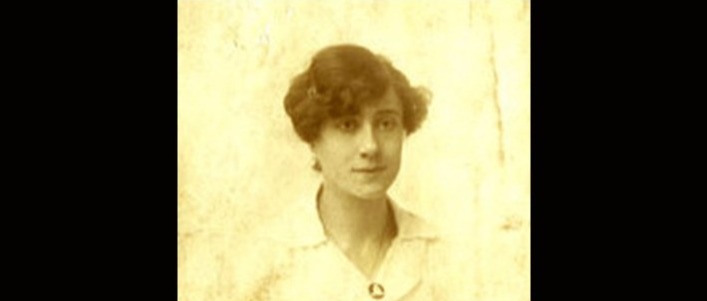
Jessie L. Weston
Source
“The evidence is of course incomplete, but it does provide us with a personality fulfilling the main conditions of a complex problem. Thus, we have a man of the required name, and nationality; living at an appropriate date; of the requisite social position;on excellent terms with the French nobles, and so well acquainted with their language as to sign himself officially 'The Interpreter.' ...I would submit that we have here quite sufficient evidence to warrant us in accepting Bledri ap Cadivor as, at least, the possible author of the romantic Grail tradition. In any case, so far, there is no other candidate in the field.”
Miss Weston conferred with other ‘scholars’ in the field to get their reaction to her theory regarding Bledri / Bleheris. A Professor Singer, (all I can say about him is that he was German, as he doesn’t feature in modern internet searches,) expressed his general acceptance of the theories, especially the suggested date. He then commented on the literary activity of Bleheris. He pointed out that Eilhart von Oberge's ‘Tristan’ features a knight of King Mark's court named ‘Pleherin’. In the ‘Tristan’ of Heinrich von Freiberg, it appears as ‘Pfelerin’, and the professor believes that both poems were derived from a common French original. ‘Blihos’ (or Blio)-Bliheris, also appears in the Gawain-Grail compilation as a knight at Arthur's court. Breri-Blihis-Bleheris is always referred to as an authority throughout the Tristan, Grail and Gawain traditions.
The professor went on to suggest that these references were all made by Bleheris himself, who not only narrated the stories in the third person (a common device at that period), but also included himself as an eye-witness and actor in his own stories. In the Tristan he is a knight of Mark's, in the Elucidation and the Gawain stories he becomes a knight of Arthur's court. This would mean that the information concerning Bleheris's Welsh birth and origin given in Wauchier de Denain’s second continuation of Chrétien’s Perceval, was all given by Bleheris himself and simply copied later by Wauchier from the original source. Miss Weston notes that the double form, ‘Blihos-Bliheris’, would
have been penned by Bliheris himself, to indicate the common dual identity of both Blihis and Bleheris. Furthermore, when he’s “dealing directly with the Grail, he assumes the title of ‘Master’, which would seem to indicate that here he claimed to speak with special authority.”

Alfred Nutt
Public domain
Jessie L. Weston also corresponded with Mr Alfred Nutt on the subject of Bleheris. He was very impressed with Miss Weston’s theory and Professor Singer’s additions. He postulated the existence of “...a set of semi-dramatic, semi-narrative, poems, in which a Bledri figures as an active, and at the same time a recording personage,” became the source of all the later Arthurian Grail ‘romances’. He justified this by the fact that two such ‘sets’ have survived, one from Wales, in the ‘Llywarch Hen’ cycle, the other from Ireland, in the ‘Finn Saga’. In both cases the poems are narrated by a character from the story – in Wales by Llywarch, in Ireland largely by Oisin. From the earliest times these poems were wholly ascribed to Llywarch and Oisin respectively. Alfred Nutt found it perfectly feasible that a Welsh storyteller, who was no doubt familiar with the Llywarch and Oisin poems, would present his versions of the Arthurian stories in exactly the same way.
“Now that both Professor Singer (who has an exceptionally wide knowledge of Medieval literature), and the late Mr Alfred Nutt, knew what they were talking about, does not need to be emphasized, and the fact that two such competent authorities should agree upon a possible solution of a puzzling literary problem, makes that solution worthy of careful consideration; it would certainly have the merit of simplifying the question and deserves to be placed upon record.”
And that’s about as far as it ever got. As we shall see, for me and the purposes of this article, it’s the final piece in the jigsaw.
It’s a terrible shame to waste all the research of Jessie L. Weston, Professor Singer and Alfred Nutt. If we accept that Bledri ap Cadivor is an actual concrete link between reality and the Grail ‘legends’ and if then we make an attempt to understand exactly what the nature of that link was, then… then who knows where it could lead? I think I’m right in saying that it’s probably never been done before. I suppose it will be regarded as nothing but speculation, but you have to ‘speculate to accumulate’, or so the saying goes.
Bledri lived between 1070 and 1150. His father, Cadivor, was a highly respected person in West Wales, who was believed to be the ancestor of the most important families in ancient Dyfed, which is now an area divided between Pembrokeshire, and the Western portion of Carmarthen. This same area is home to the traditional tomb of Gawain and there is reason to believe that the Perceval story, in its earliest form (1180-1190,) was connected with that locality. Apologies for the repetition, but this information is crucial in order to put Bledri and his father in the correct context regarding the most significant events.
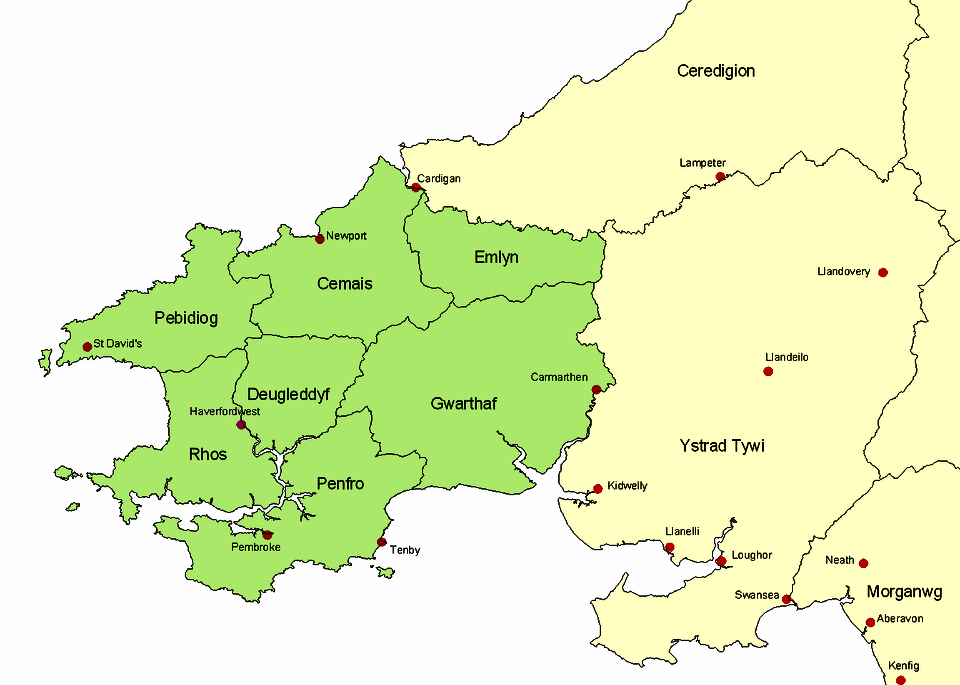
Dyfed
Public domain
It’s clear then that Cadivor was already well established in Dyfed before the Norman Conquest of 1066 and therefore didn’t arrive in Britain with the Normans. If he was THE ancestor of the most important families in ancient Dyfed then does that mean there weren’t any important families there before him? Records show that Cadivor died in 1089, only 19 years after the estimated birth of Bledri, who was the eldest son of three. It doesn’t give much time for him to have had, not only two more sons, but also become the ancestor of the most important families in the area. Perhaps he had children by a previous marriage ...or two or three? Maybe he was superhuman… Supercadivor?
Let us anchor the date of the cataclysm at 934. Let’s also assume that the Arthurian Grail Legends are all based upon events that took place before the cataclysm and that the Wasteland of Logres, as described in The Elucidation, was not sufficiently widespread to qualify as being the 934 cataclysm. This gives us a period of maybe 80 years before Cadivor might have been born ...if he was human that is.
OK, so if Cadivor was THE ancestor of the area, then Bledri must have learned all of the stories about the history of the land from his father. He no doubt also inherited his gift for storytelling from the same source. We should not forget that Bledri, as narrator of his stories, included himself in the action as an eye-witness. However, this does not (and cannot) mean he was actually there, simply that he gave his own name in place of the actual eye-witness, or the person he got the story from – his father Cadivor. But, I hear you say, if Cadivor was the actual original Bleheris of the Elucidation, who had obviously lived a great deal longer than any normal human, why did he die in 1089? That's a very good question... I believe it has something to do with the restoration of Logres from a Wasteland to its previous verdant state. It's clear that the latest discovery of the Rich Fisher's Court of Joy, whilst lifting the curse over Logres, didn't bring back the Maidens of the Wells and their hospitality. This is confirmed by statements in The Elucidation that refer to the 4 year period of war preventing Arthur, and/or his Knights, from undertaking more 'Quests' - why would anymore quests be necessary if everything was restored? Obviously the restoration of Logres was only a partial restoration of 'The Fairy Accord', or the agreement between Arthur's earthy realm and The Rich Fisher. Maybe this situation also made Cadivor 'mortal' and subject to a normal human lifespan?
I’m going to leave that ‘hanging’ for a moment. By the way, just prior to publishing this article I discovered the following (which I have had no time to investigate btw)...
“When a seventeen-year-old C.S. Lewis was preparing for Oxford entrance and WWI service in 1916, he wrote seventeen chapters of a prose novel. “The Quest of Bleheris” is a letter-styled chivalric tale of heart-longing for adventure in a latter-days world. Young Bleheris must discover the true meaning of knighthood in a land where King Arthur is a distant memory and chivalry exists only as a formal social game.” Source
The Pembroke peninsula of Wales, or Dyfed, is a ‘special’ place which has been featured many times on this website. Bran and his company stopped off at Gwales (Grassholm Island, now just of the coast,) on their journey to Tower Hill in London with his severed head. They spent 80 years there, but that was Otherworld time. In the first branch of the Mabinogi, Pryderi, his wife Cigfa, his mother, the Goddess Rhiannon, and Manawydan the brother of Brân the Blessed, climbed the sacred hill known as Gorsedd Arberth, the Throne, Seat or Mound of Arberth, in Dyfed. When they climbed down, Dyfed had turned to a Wasteland and the entire population had vanished. To the west of Dyfed, out in the Irish channel, fairy islands can often be seen, although only briefly before they disappear. These enchanted green islands were still being spoken of by sailors in the 19th century. The Faë inhabitants of these islands were claimed to have done their weekly shopping at the Milford Haven and Laugharne markets. Apparently they never spoke, but selected their purchases and passed over the exact amount of money without needing to ask the price. The stallholders would not always see such customers, but many people did. One Milford Haven butcher in particular was regularly favoured with their custom.
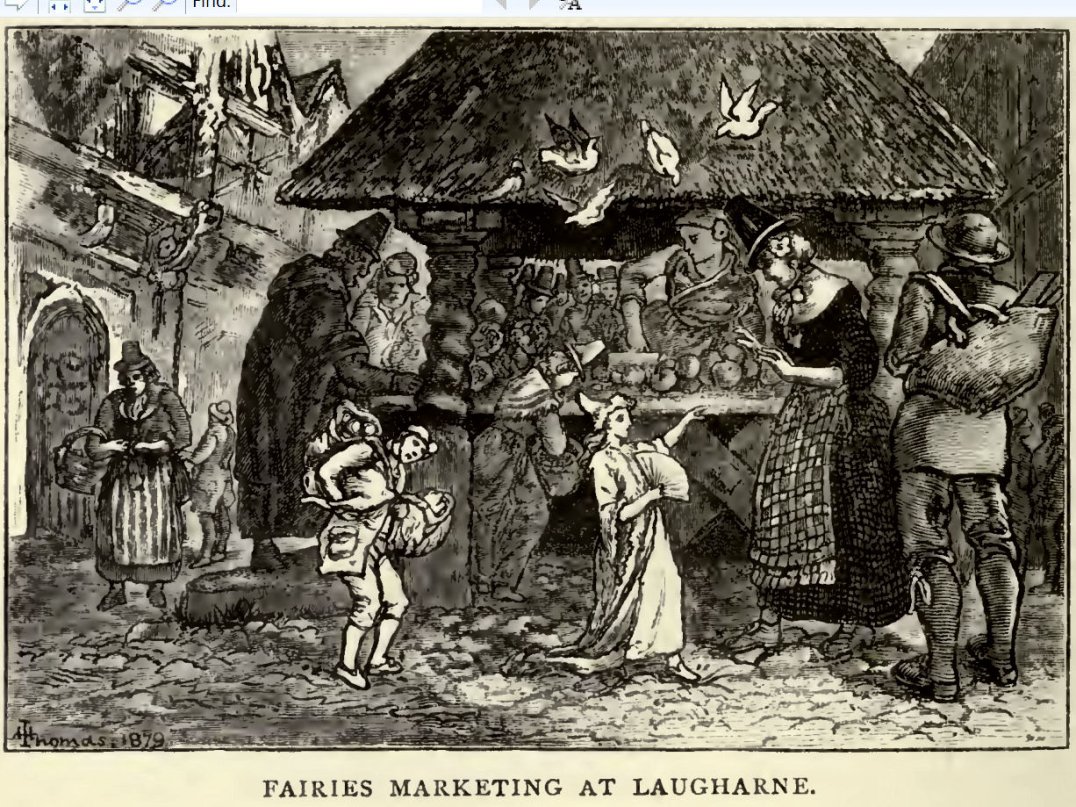
Fairies at market, Laugharne, Pembrokeshire, South Wales.
From British Goblins by Wirt Sikes, 1880
If we turn our minds back to the events of The Elucidation, we can recall that Bledri (Cadivor) identified himself as one of the faë, first generation offspring knights of the abused Maidens of the Wells – Blihos-Bliheris. Given that the abuse and breaking of the ‘geas’ by King Amangons occurred long before the reign of King Arthur (1000 years before according to one source,) this Blihos-Bliheris could easily have been 1000 years old, in human terms, by the time he was defeated by Gawain and submitted to King Arthur. Also, it’s by no means certain that Blihos-Bliheris and his gang, were actually wandering around for the entire 1000 years – for all we know they could have appeared just before the Knights of the Round Table went to Logres.
His subsequent storytelling in Arthur’s court does not claim that the wandering band of Maidens and accompanying Knights included the original Maidens of the Wells, just their children, because “There will never be any more beautiful in the world.” This sounds very much like the original Maidens had gone from the physical realm by this time. Let’s also not forget that Blihos-Bliheris wasn’t the only potentially 1000 year old knight who went over to Arthur’s side, as we are told that, whilst he lost many good knights, “he gained many a good one too.”
The Elucidation, although allegedly composed after Chrétien’s Perceval, is unique in its treatment of the Fisher King element. As mentioned in the introduction, The Rich Fisher, his court and his realm, are not located within the physical world. This perfectly represents the unseen force, power and abundance of Nature, which is the cause of the effect we experience in the physical realm. When that same unseen force is withheld or prevented from manifesting, we experience The Wasteland. In my opinion, of all the Grail legends, this is the only one that portrays the Fisher King correctly and that actually makes sense. For me, this indicates that it was the original version that underwent later modification to satisfy the Christian God’s ownership of everything.
Speaking of which, there’s actually a remarkable parallel here. If we consider Amangons’ violation of the Maiden to be “The Original Sin,” and that this caused all the Maidens to be expelled from this ‘earthly paradise,’ we can’t help but be reminded of another similar tale. Furthermore, the children of the Maidens were forced to wander the earth, like a people dispossessed, searching for ‘the promised land.’ Where have I heard that before?
Anyway, back to the telephone call to try and connect with reality. For some unspecified reason, the children of the violated Maidens were cursed to wander the land forever, until God, the Christian one, allowed them to reconnect with the ‘court’ of The Rich Fisher – the unseen force, power and abundance of Nature. Obviously this is later Christian opportunism – a convenient point in which to slip the word in. If we think about it reasonably, then it’s clear that these children were a new hybrid species, or as I speculated earlier, perhaps this was actually the normal state of human affairs. Whilst it’s obvious that Amangons was Faë, or at least semi-Faë, it doesn’t follow that ‘his men’ were Faë and not fully human. So, we have a race of beings who don’t ‘belong’ to the Faë world or the human world. Therefore, deliberately or otherwise, this was Amangons’ curse upon them – to wander around searching for a place to ‘Be’. In the poem, their stated aim was to “to find the court from which will emanate the Joy that will bring splendour back to this land.” (Interestingly he was in Arthur’s ‘land’ when he said “this land” and the word “splendour” has a connotation of ‘magnificence’ or even ‘fame’ about it.)
For another unspecified reason, Blihos-Bliheris (Cadivor) and his gang, were not capable of finding the court of The Rich Fisher, or Court of Joy as it’s also called, despite their Faë nature. This was the reason Blihos put all of his storytelling talent to work, inspiring the Knights of the Round Table and Arthur’s court, to undertake the Quest for the Court of Joy ...which they did, the knights that is, not Arthur. It’s all very convenient for the Blihos faction who managed to get the Knights of the Round Table to do their ‘dirty work’ for them.
Bledri as Blihos referred to seven other ‘branches’ of his story that detailed how and when, the Court of Joy was found on seven different occasions. By now, these are mostly lost or just too obscure. If we recall the definition of a Quest, it shows that these seven ‘branches’, or guardians, were simply tests of worthiness – like a kind of peace negotiation – to re-establish faith and trust between the human world and that of the ‘court’ of The Rich Fisher – the unseen force, power and abundance of Nature. This is why all the later tales focus heavily upon the purity of the quester’s moral character – something that greatly suited the Christian manipulators.
So, when the Court of Joy was finally found and all the right questions were given to the answers, (?!*) the land of Logres was instantly restored to its former glory. However, at the same moment, another even greater wave of Amangons’ spawn “returned” to Logres via the wells – or through the reopened portals to The Otherworld. This bunch were not as friendly as Blihos and his pals though, they were “full of bitter resentment” for an unspecified reason. The use of the word “returned” is puzzling, it doesn’t make any sense. Also, at each appearance of the children of the Maidens, Bledri always says that “he or they weren’t recognised.” Maybe this and the “returned” business are simply the result of a bad translation. What's more interesting is that the return of The Maidens of the Wells is conspicuous by its absence.
What follows in Bledri’s tale is quite hard to believe. His details regarding the number of these “returnees” are badly calculated, but even so they show that they came in their thousands. Then we discover that their building abilities were ‘out of this world’, perhaps even literally. They built “castles and cities, towns, villages and strongholds,” not to mention two particularly magnificent castles and a Perilous Bridge. The only indication of a timescale for this program of construction comes from the section of the poem which tells us that Arthur and his Round Table were unable to confront ‘The Rich Company’ due to being embroiled in wars with their “own people” for four years.
If we bear in mind that Bledri’s audience was the invading Normans, and that they are also attributed (rightly or wrongly) with huge building programs, then perhaps Bledri was trying to make an identification between the Normans and The Rich Company.
There is another explanation for all of the "returning" and the insane building agenda... Whilst the children of the original Maidens, such as Blihos (Cadivor,) were cursed to wander Logres as a Wasteland, maybe there was a version of Logres that wasn’t a Wasteland, but still existed, just outside our reality. This means it contained the entire population of Logres at the time of Amangons’ “Original Sin.” This isn’t unprecedented – in the Mabinogi story mentioned above regarding Dyfed and its weirdness, when Pryderi, his wife Cigfa, his mother, the Goddess Rhiannon, and Uncle Tom Cobley and all, climbed down from the sacred hill of Gorsedd Arberth, Dyfed had become a Wasteland with no inhabitants. This same concept appears many times throughout ‘Celtic’ folklore, whereby the Faë races are protected behind an impenetrable cordon of mist. So, the opening of the portals in the earthly Wasteland Logres, upon the restoration of The Joy, then restored the hidden Logres to full visibility in the physical realm. This would explain the word “returned,” in the sense that all the inhabitants, the Rich Company and its creations, whilst actually being in Logres but invisible, returned to the physical realm and became visible to everyone. It also explains the otherwise ludicrous timescale of the building program and how all of the forests and vegetation became lush and healthy in an instant. The “resentment” aspect of the returning Logretians… Logrecites(?) could also be due to having been excluded from physical reality for maybe 1000 years (perhaps they hadn’t aged during that time either), although personally, I don’t think I would complain – quite the opposite in fact, perhaps they resented being back come to think of it. (The two explanations given above – identifying with the Normans and the hidden Logres – are not mutually exclusive really.)
Could it also be that Blihos and The First Generation (I think I bought their LP many years ago actually,) were really a scouting party on a rescue mission for the hidden Logres, sent to persuade The Round Table to seek the Rich Fisher’s Court of Joy and thereby rescue the hidden Logres and its inhabitants, from behind the veil of obscurity that kept them outside of the physical realm? It’s also an explanation for Beldri’s constant compliments when referring to The Rich Company, i.e. as people of good breeding etc., as they were of the same family. The discovery of hidden cities happens almost everyday in Peru.

Blihos and The First Generation
As we have already seen, the four years war wasn’t just a battle against The Rich Company in Logres. That Arthur fought against “his own people” and then forcibly subdued them, has been discussed previously. However, the Elucidation poem makes the ending of the wars coincide exactly with the day that The Rich Company of Logres “took leave of the (their?) court and went to hunt in the forests.” I examined the story of the Rich Company’s defeat in detail earlier, in order show the striking Norman-ness of the battle tactics, the chivalric jousting contests and the final act of courtly love, which resolved the entire affair. Even as The Rich Company rode off into the sunset with their liberty they went to indulge in the Norman’s favourite sport of hunting in the forests. Mr Bledri certainly knew how to please his audience.
The true origins of The Normans are obscure, in my opinion. It’s a subject that’s been dealt with many times on this website. When once the popular opinion was that the Normans were not a separate race of people from Normandy in France, but an elite group of wealthy local ‘nobless’ aristocrats. Today, the mythical origins of the Normans as descendants of the Viking Rollo, is now taken as ‘gospel’. It was actually invented by Dudo of Saint-Quentin in 1015. This, and their absorption into the Frankish kingdom, all supposedly began in 880-911, just 23-54 years before the cataclysm and 155-186 years before their invasion of England.

In yet another version of her story, we find a mirror of the same sovereignty test mentioned before in ‘The Wedding of Sir Gawain and Dame Ragnall’...
“If she found a man willing to marry her, he would have to promise not to look at her on Saturdays, nor ever reveal the taboo to anyone. As long as he adhered to the pact, Melusine would be capable of extraordinary achievements: the building of great fortresses, multiple towns, the amassing of inordinate wealth. She would bear many children, thus creating the great Lusignan lineage.” (Source: Knapp, B. L. 'French Fairy Tales: A Jungian Approach’, 2002.)
In the 14th-century Melusine was actually linked to the Arthurian tales by French writer, Couldrette, in his Roman de Melusine. As the Arthurian tales were so popular with Europe’s nobility, for reasons that I hope will be clear by now, Melusine was absorbed into their genealogies. Whilst being a supernatural being, she was given a Christian ‘gloss’ of values and virtues by most, if not all, writers of medieval literature. Her children were regarded as heroic foundational figures by the various houses of Europe. This is precisely ‘the truth in plain sight’ – Melusine represented the original Maiden of the Wells who was abused by Amangons. Her children were The Rich Company, who then became the various ruling dynasties of Europe. Obviously emphasis on the Amangons element was not something to be publicly aired, therefore, Melusine was made more acceptable to Christian morality and all the emphasis was placed upon her. In this way, her children – The Rich Company – successfully ‘closeted’ their ‘demonic’ ancestry to the point where it became a mere intriguing and distinctive ‘quirk’, and an amusing excuse for bad behaviour. It’s quite amazing to see how the Melusine phenomena was uniquely allowed to bypass the Christian Euhemerism process.
Jean d’Arras’ romance of Melusine was written for Jean de Berry, the brother of King Charles V of France, Duke Louis I of Anjou and Duke Philip the Bold of Burgundy. The author, promises to tell “how the noble and powerful fortress of Lusignan in Poitou was founded by a fairy.” He goes on to give an astonishing account of the origins of the powerful feudal dynasty of the Lusignans in southwestern France, which flourished in western Europe and the Near East during the time of the Crusades.

Chateau-Fort Saint-Jean-d’Angle de la Fée Mélusine, south-western France
Source
The legend of Melusine is closely tied to the founding of several castles, most notably the Château de Lusignan in Poitou, France, which is said to have been built by Melusine in a single night using her magical powers. According to the tale, she constructed the castle and its church for her husband, Raymondin, using "three apronfuls of stones and a mouthful of water". Beyond Lusignan, Melusine is credited with building numerous other fortresses and towns throughout the region, including Pouzauges, Tiffauges, Mervent, Châteaumur, and Vouvant, each constructed in a single night. The in Vouvant, a 45-meter-high cylindrical keep, is considered the only remaining vestige of the ancient castle of the Lords of Lusignan and is directly linked to the legend of Melusine.
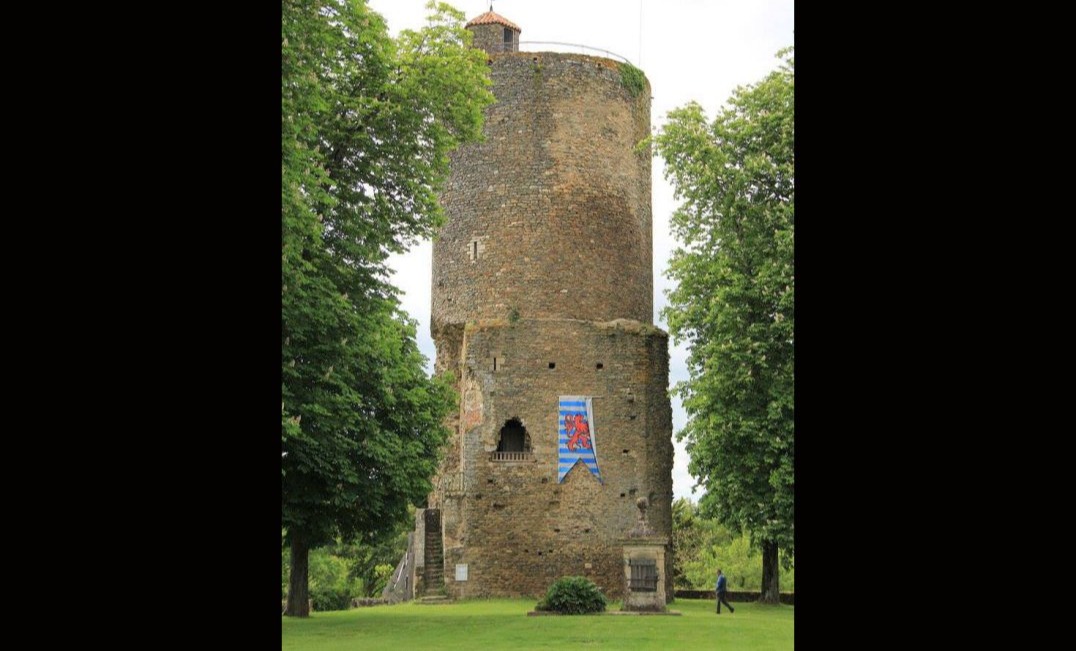
The Tower of Melusine, Vouvant,
Pays de la Loire, France Source
The association of Melusine with the construction of castles, fortresses and towns etc., corresponds to the same association in The Elucidation regarding The Rich Company. Was this some kind of sorcery that conjured up actual physical edifices and objects, or is it the only way that the people of the time could explain the sudden appearance of these structures? Are we again dealing with the same phenomena encountered at the time of the Rich Company’s return to the physical Logres? Did the ‘original sin’ – the abuse of the various ‘Melusines’ – cause parts of the local area to become physical Wastelands, but to continue their existence isolated and hidden behind a veil separating them from our reality? Then, many years later, once the ‘Melusines’ had been released from their bondage and trust restored, the hidden areas suddenly popped up again, appearing to have been freshly constructed by the newly released Melusine. It certainly seems that the male members of the Amangons lineage just couldn’t resist a fairy woman, regardless of the consequences.
In the present day, Melusine is featured in video games, poetry, novels, and she has even, controversially, been the Starbucks logo.
It’s my contention that Logres was actually Lognes, which is now in the Seine-et-Marne region of Paris. This area was once part of the enormous forest of Lauconia Silva (which extended to Normandy,) and today the town of Lognes is within the area designated as the ‘Forest of Noisy’. Let’s bear in mind that the Logres of The Elucidation was an entire ‘land’ or kingdom and therefore the modern town of Lognes is merely a surviving remnant. Paris is only 22kms from the town of Lognes. It’s been extraordinarily difficult to find any historical information regarding Lognes and the little I did find is all in French, which Google refused to translate. However, after a struggle, I found out that the area was given to a Lord named Aimon at a claimed date of 946… Aimon sounds a little like Amangons. This Aimon was descended from “numerous counts of Paris”, and Lognes was given to him as a gift upon his marriage to Elisabeth, daughter of Lisiard Le Riche (The Rich).
In 1060, just before the Norman invasion, the Lord of the nearby area of Noisy-le-Grand, Milon I (the first) Le Riche (The Rich,) was accused of treason by the King of France and had all of his lands confiscated. They were given to a bunch of monks. However, they did not include the Forest of Noisy, the fiefs of Villeflix, Normandy, La Barre, or the rights to the river Seine.
In 1106, Ansoud de Bry, renounced his claims upon the Forest of Noisy. This was signed by (among others,) Milon, son of Hildoin (both of the Riche family.) In 1182-83, the nearby woods of "Noisy-sur-Marne” were confiscated by the crown. “It is surprising to see the king daring to confiscate a property owned by a powerful ecclesiastical order, with the only reason being lack of maintenance and bad conservation.” Source
According to Wikipedia’s page on ‘Famille Le Riche’ They ‘appear’ in 880 with Arnould Le Riche…
“Under the first kings of this dynasty, it held major military posts which quickly became hereditary, and owned many monastic properties - hence the original family name [WS: eh?!*] . Several members were among the highest officials of the kingdom (grand chambellan , grand chambrier , etc.) under different kings.”
I repeat… “They ‘appear’ in 880,” which is exactly the date attributed to the first appearance of Rollo and his Vikings, in what would become Normandy.
Images from the Forêt de Noisy, Lognes Source
In view of the ‘fact’ that Arthur didn’t exile or annihilate The Rich Company, but simply integrated them into his empire – an empire that included Northern France at that time. They simply went off hunting in the forest, which was obviously the Lauconia Silva (which extended to Normandy,) so it doesn’t require any stretch of the imagination to realise that they could have easily taken up residence in both Normandy and Paris. Given that Britain wasn’t an island at that time and the coastlines of both Britain and France were, if not joined, then much closer to each other than they are today, it doesn’t seem so unlikely that Arthur and his knights (mostly his knights) travelled to and from Lognes. The frequent appearance of groves of olive trees whenever the scene shifts to the Logres of The Elucidation is also more easily explained, because olive trees are not native to Britain. Furthermore, given that Blihos and others of The First Generation went to Arthur’s court in Britain, it’s no surprise that they ended up in Dyfed after the cataclysm. Therefore, Bledri’s father, Cadivor – mentor to Bledri and THE ancestor of all the important (Rich) families in Dyfed – was actually the original eye-witness and narrator Blihos-Bliheris / Master Blihis. It’s curious that Cadivor was only referred to as ‘Cadivor’, I expect ‘ap Amangons’ just didn’t work in Welsh ("ap" means "son of" by the way.)
This explains an awful lot. Obviously it would make Bledri ap Cadivor family to the invading Normans. This is evidenced by Bledri’s acts of betrayal to his supposed Welsh ancestry as we have seen earlier, plus...
“Cadivor himself appears to have been on friendly terms with the Normans; he is said to have entertained William the Conqueror on his visit to St David's in 1080, while every reference we have to Bledri shows him in close connection with the invaders…
“...Thus, in 1113 the Brut-y-Tywysogion mentions his name as ally of the Norman knights in their struggle to maintain their ground in, and around, Carmarthen. In 1125 we find his name as donor of lands to the Augustinian Church of St John the Evangelist, and St Theuloc of Carmarthen, newly founded by Henry I. Here his name appears with the significant title Latinarius (The Interpreter.)” (Jessie L. Weston, From Ritual to Romance, 1919)
If this is all true, then it’s no wonder that Bledri was welcomed by the Normans as a storyteller of their own history. It doesn’t require any stretch of the imagination to see that he was also been invited to Normandy to retell his stories, which then became the Arthurian Grail Romances.
As for the Norman Conquest, well, not all of The Rich Company necessarily went to Normandy, many others of those captured by the Knights of the Round Table might have stayed in ‘England’. There could easily have been a network of them throughout Britain. After the worst effects of the cataclysm had died down, leaving England a Wasteland, and the Scandinavians all squabbling amongst themselves for the prize of Britain, the time would have become ripe for a takeover of power. William the Bastard, who would later claim that England was rightfully his due to descent from King Arthur, needed only to arrive in England and be pronounced king by The Rich Company already living there. As demonstrated in previous articles, it’s abundantly clear that the pre-conquest Norman infiltration of England has been entirely overlooked, never mind underestimated. We saw how Bran de Lys was easily persuaded to join The Rich Company and defy Arthur, so we shouldn’t be surprised to find this same situation in the England of 1066.
All of this was hinted at earlier during the discussion of Melusine and the origins of the Norman/Angevin/Plantagenet dynasties. I postulated that the fourth count of Anjou, Geoffrey I Greymantle, and his dynasty, was descended from Amangons – The Rich Company were his offspring, but they were also the children of The Maidens. I also discussed the curious mixture of good and bad, like a duality of extreme opposites. As I look around me today I see the results of this mixture of extreme opposites and all the various shades between. As I look back on our so-called history I see it making alliances and fighting against itself over and over again. Make no mistake, the worst of them have always found each other – “birds of a feather flock together,” and they know the secret of The Grail. Fortunately though, this also applies to the best of them.
Instead of simply complaining about all the Euhemerism and Christian redefinition, it’s time to address the subject of King Arthur and Christianity. If we return to the basics – the archaeology – then, according to Gunnar Heinsohn and many others, Christianity didn’t ‘take-off’ until just after the cataclysm, in spite of all the gospels. However, logic dictates that there must have been some kind of development before it ‘took off’ – everything had to be in place prior to that time. As I have said many times before in these articles, archaeologically speaking, there was no Roman Empire in the year 1 AD and no Jerusalem or Holy Land, so ‘The Gospels’ and their stories, have to be fictional, but must have been elaborated prior to the cataclysm.

“But Doctor, there's No Romans! No Holy Land!?*”
“Taken as a whole, the lineage of the anti-Grail Kings looks back to a coherent image of an otherworldly king of great power who, when he encountered the Maidens of the Wells, took what he considered to be his by right.” (‘The Lost Book of the Grail’, J.Matthews)
This “otherworldy king of great power” is Amangons. The philosophy whereby he “took what he considered to be his by right,” is the Norman Feudal System in a nutshell, which is hardly surprising if they were his descendants. But, how far did this really go and what implications does this have for the introduction of Christianity, which was so closely associated with the Normans?
Gunnar Heinsohn observed that the development of Christianity during the first millennium supposedly took place in several phases, separated by several hundred years. These phases all shared the common characteristic of destructions with the ensuing mass construction of baptisteries. He then showed that, just like the duplication of Roman history, these phases were actually one phase. He gives detailed archaeological evidence for this situation in Poland, The Czech Republic, Slovakia and Scandinavia. The construction of baptisteries for mass conversions almost immediately after the cataclysm was a veritable 'pandemic' in Europe.
This question has been asked before on this website: how do we assimilate this situation of mass conversions almost immediately following the cataclysm? Is it reasonable to expect that the construction of baptisteries would be the major consideration and an urgent priority after a cataclysm? There are other considerations as well – who was so highly organised as to have been able to build all these baptisteries on such a widespread scale and to have amassed a sufficiently large army to facilitate these mass enforced conversions? Were some more prepared to survive the cataclysm than others?

An additional consideration related to the above question is: were the effects of the cataclysm consistent everywhere? Right back at the very beginning of this series we showed maps indicating that they were not consistent. However, in the new light of The Elucidation material, and my whacky interpretation, it obviously didn’t involve the disappearance of the entire population within Arthur’s Empire – which isn’t to say that they didn’t disappear in some places. For example, the Domesday books of 1085, show vast tracts of England without any population at all.
It’s interesting to note that such ancient books as the ‘Insule Britannie’ and also another known as ‘Leges Anglorum’ of 1210, whilst mentioning Arthur’s extended Empire, also include incorporations from Adam of Bremen's ‘Gesta Hammaburgensis Ecclesia Pontificum’ of c. 1075, whereby the Christianisation of Norway was attributed to Arthur. The modern view is that it was achieved by Olaf, king of Norway between 995AD and 1000AD through a policy of ‘convert or die’ which inspired a mass migration to Iceland, as documented in the Icelandic Sagas, and earned Olaf the title of ‘Saint’.
As an example of the chaos that followed the cataclysm, I’d like to return to the subject of the Ælfgifus. As stated previously, this title refers to what John Matthews has termed ‘The Fairy Accord’ – the trust and shared friendship between the human world and the Faë world. It was usually given to the earthly representative of the Goddess, normally the queen. In recent times it has become the victim of ignorant confusion, however, when correctly understood it’s a fine example of how the ancient traditions were still lingering on, even at the time of the Norman invasion. It’s interesting that if you search for King Arthur II all you get is a computer game. No other kings of Britain have ever been called Arthur. We’ve had loads of Edwards, Henrys , James’, Georges and Charles’, but never any Arthurs. Perhaps ‘Arthur’ wasn’t a title, as we have proposed, or maybe there’s another reason why no one else has ever used it.
Coincidentally, the word ‘Ælfgifu’ is now believed to be a proper name, not a title. There are as many as eight recorded Ælfgifus, although some of them refer to the same person. The ‘Ælfgifu Of Shaftesbury’, or Saint Ælfgifu, was Queen to Edmund I. ‘Ælfgifu Of York’ was the Queen of Æthelred the Unready. ‘Ælfgifu’ was the consort of King Eadwig and the daughter of Ælfgifu Of York – which shows it was a title, otherwise why would mother and daughter have the exact same name? ‘Ælfgifu’ was the daughter of Edward the Elder who “married a prince near the Alps’, perhaps Louis, brother of King Rudolph II of Burgundy.” (Wikipedia) Her name prior to the title was ‘Edgiva’. Oh yes, also King Harold is shown as having a sister named ‘Ælfgifu’ in one of the Domesday Books, who was possibly to have been married to one of William's nobles as part of the agreement to secure his release from captivity in Normandy.
Things get more interesting when we get to the ‘Ælfgifu Of Northampton’. She became consort to Cnut the Great and later Queen of Norway. Cnut’s marriage to her was strategic and secured the invasion of England for his father, Swein Forkbeard. Later, once he succeeded to the throne of England, Cnut married Emma of Normandy who, after much shenanigans, became the RICH-est woman in England. When she became queen...
“An English name for her new, English life was given to her on her coronation – ‘Emma’ is deemed too foreign-sounding for Anglo-Saxon royalty. Officially she is to be known as Aelfgifu, although she is mostly to be referred to as the Lady. It rankles that Aethelred’s previous wife was also called Aelfgifu, but Emma has been assured this is purely a coincidence. The name has been conferred on her in memory of the king’s late grandmother…” (Source: Harriet O'Brien, ‘Queen Emma and the Vikings’, 2019)
That’s a prime example of the kind of nonsense created by the confusion – or is it concealment – of Ælfgifu as being a title, not a proper name. The Witan, or king’s council of advisers, obviously insisted that Emma must adopt the traditional title of Ælfgifu. To claim that it was “purely a coincidence” that Cnut’s existing wife/consort had the same title is just ludicrous. There are no records of Cnut’s grandparents either. Anyway, it shows that the ‘Old Ways’ were still respected even in 1016. Incidentally, later when Emma had given birth to a daughter, she named her Godgifu, no doubt just to make a point… or maybe someone sneezed during the baptism.
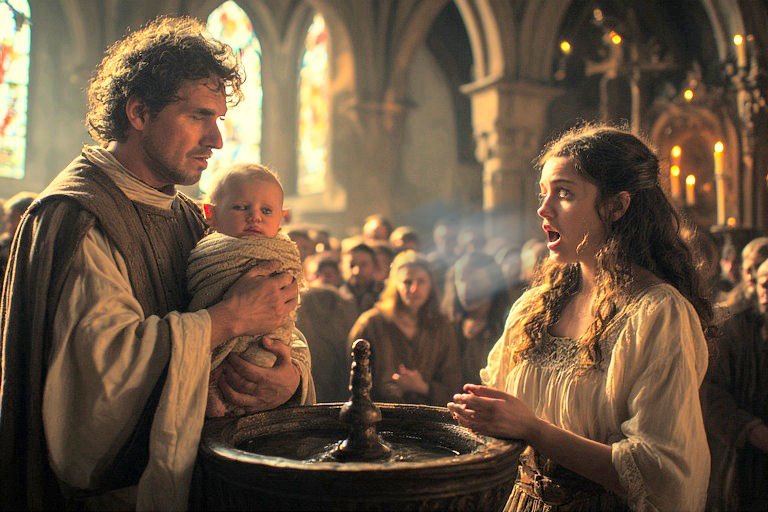
Priest: “I name this child...”
Emma: “Ah-choo!”
Priest: “Godgifu!”
There’s a curious, and famous story, about King Cnute and ‘The Old Ways’. It was first recorded by Henry of Huntingdon in his ‘Historia Anglorum’ in the early twelfth century...
“When he was at the height of his ascendancy, he ordered his chair to be placed on the sea-shore as the tide was coming in. Then he said to the rising tide, ‘You are subject to me, as the land on which I am sitting is mine, and no one has resisted my overlordship with impunity. I command you, therefore, not to rise on to my land, nor to presume to wet the clothing or limbs of your master.’ But the sea came up as usual, and disrespectfully drenched the king's feet and shins. So jumping back, the king cried, ‘Let all the world know that the power of kings is empty and worthless, and there is no king worthy of the name save Him by whose will heaven, earth and the sea obey eternal laws.’” (Source )

Who knows if he had been converted to Christianity at that point or not… or if it ever happened. Anyway, it’s interesting to note that following the rupture of the Fairy Accord and the ensuing cataclysm, the loss of the sovereign’s power to rule the land (and sea) is now seen as the superiority of the Christian God rather than the failure, ignorance and weakness of men.
This same Ælfgifu confusion has perplexed scholars for hundreds of years.The Bayeux Tapestry is supposedly a detailed representation of the Norman Conquest, but actually a work of complete fiction. In one of the early sections two strange characters appear, ‘Ælfgyva’ (latinised Ælfgifu) and ‘Clericus’ (Cleric.)
The amount of time and effort that has been, and still is being, put into identifying this ‘Ælfgifu’ is quite unbelievable. There are books and novels and papers by the shed-load, plus more theories than you can shake a stick at, but none of them have been accepted as definitive. Hopefully, regular readers will have absorbed all of the evidence presented previously regarding the Norman invasion, and realise that, for me, the whole thing was a fantasy – one that was depicted in comic strip fashion in the Bayeaux Tapestry. The Norman invasion had to be a grand and epic affair, one that would outdo the previous fictitious invasions of the Romans and Saxons. However, what the 70m (230 ft) long and 50cm tall comic strip reveals is the intention and the story that was to be handed down to posterity, not the reality. There’s apparently another 8 – 10 metres missing from the end of it as well, which have mysteriously vanished.
In the scene above, ‘Clericus’ is placed in front of a church and in a pose that looks as if he is striking the hooded woman – one of only three who appear in the entire comic strip and the only one with identifying text. She is stood beneath what looks like an ornate arch supported by two columns. At the top of each appear the heads of two unidentifiable animals (maybe dogs?) both with protruding tongues. Given that Ælfgifu, or Aelfgyva, is a Pagan title, it’s clear that the arch represents her Pagan ‘church’ or sacred space. The Cleric is not named, only his title is given. Similarly, the woman is not named, only her title is given. The implication is clear – Christianity overcoming Paganism.
Much is made of the seemingly ‘erotic’ figures in the lower border. There are similar naked figures elsewhere in the lower border of the comic strip, where there is no connection at all with the main action. However, given the Christian view of Paganism, it is probably a not very subtle insult.
The comic strip is two dimensional. It’s like a child’s painting, where the ground is represented by a strip of green along the bottom and the sky by a strip of blue across the top. The inevitable house is then placed upon the lower strip of green. It’s the same in the comic strip, but the extra upper and lower borders seem to represent heaven above the sky and hell below the ground. Also some of the characters are above the ‘ground-line’ and seem to be floating or flying. Aelfgyva is one of those. The artist of the comic strip included several animal fables in the borders, touching on themes of deceit, dishonesty and possession and both the upper and lower borders include many mythical ‘beasts’, all separated by a crucifix or some other object like a candlestick.
I’m afraid I haven’t studied enough of the 70 metre comic strip to know if the floating depiction of certain characters is significant, however, this one is quite amusing...
The horses that Turold is holding, or trying to, are clearly on the ground, but he isn’t. The overriding official consensus is that Turold is suffering from the medical condition of dwarfism and that he was employed as a kind of court jester – which they deduce from his ‘jongleur’s’ outfit. Perhaps the only thing he was suffering from was being lifted off the ground by the horses.. Of course, no one would ever dare suggest that he was a real Dwarf, or Gnome.
Before I go too far off the rails (again,) the purpose of this digression was to show that England was not the Christian country we’ve been led to believe it was at the time of the Norman Conquest. The ‘Old Ways’ were still very much in use, even if the ‘Fairy Accord’ had been broken again – as witnessed by the cataclysm. It was the Normans who brought Christianity to Britain as an integral part of the Feudal System.
In the late tenth century, Russia was converted when Prince Vladimir (980-1015,) adopted Christianity. His subjects were given the simple choice of Christian baptism in the river Dneiper or drowning in it. He is now a saint. Throughout Europe conversion involved prolonged conflicts, warfare and bloodshed. Sixteen years after the conversion of Iceland, the exemptions for traditional practices, including the liberty to worship other gods, were abolished. The same happened everywhere else, Christians denied others the liberty of worship that they had so earnestly advocated for themselves (or was that just in the movies?) Within a century compulsory tithes were introduced. Soon the Benedictines and Augustinians would introduce the abuses and corruption common in mainland Europe. By the thirteenth century a feudal system had been introduced in Iceland and freeholders were reduced to feudal tenants of the Roman Church.
As stated elsewhere on this website, obviously the cataclysm was a huge benefit to Christianisation – the Fairy Accord was broken again and the spirit of nature had retreated once more. But the new Christian God promised salvation from all of the suffering in exchange for a new form of suffering – slavery to the feudal lords and the church.
Back in September 2021, before stolenhistory.net went completely down the toilet, an incredibly interesting article appeared, entitled ‘France-Biblical Israel’. It was a translated transcription of a Russian documentary, the original information was researched and compiled by Alexey Khrustalyov. The translation was made by Sasyexa, a forum member at that time.
The entire thread runs to some 8 pages, but fizzled out in early 2023. I’m going to try my best to summarise it because it’s extraordinarily relevant and important to this article… and very very long.
It begins by extensively illustrating the fact that there is no archaeological evidence to support the contention that the events of the Old and New Testaments took place in the territories of present-day Israel, Palestine, Syria, Jordan, Lebanon and Egypt. Furthermore, it shows that there is a huge gap in the testimonies regarding the Holy Land. In 3 AD there’s the account of Helena, the mother of Constantine, but we can ignore that, as there was no Roman Empire at that time, then there’s a massive break until after the Crusades.
Local Arab authors from the region itself call Jerusalem ‘Al-Quds’. For them there is no Jerusalem and never was. In the DECs Part 2, I pointed out that The Shahnameh (The National History of Iran) has one reference to Jerusalem in the wrong place and as the palace of a demon king, which is more than likely a later modification. For the Arab Muslims it is a holy city, but only because Mohammed is said to have made his nocturnal trip to heaven from that point. Moreover, there is direct evidence from Arab authors that the Franks, as they called them, those people who came during the Crusades, openly fabricated the story of Christ's stay in Al-Quds. One author, Isfahan, states that the Franks built a church upon The Dome of the Rock in which they placed an altar, pictures and statues, then they designated a place for the monks and the gospel. They further constructed a small gilded dome and placed it above the footprint of “the prophet” – actually the prophet Mohammed, but the Franks claimed it belonged to the messiah, Jesus.
Testimony left by Al-Harawi, states that the most important site of Christian pilgrimage in Al-Quds was a tomb, which they called the tomb of resurrection, 'kiyamah', believing that the resurrection took place inside. In fact, this place was the ‘Kumamah’ – the local refuse dump. Although the Arabs didn’t have good relations with the Franks, they did respect Isa (Jesus) as a prophet and generally treated Christians with decency… but they must have seemed like nutters to the Arabs.

The next section deals with place names and their geographical relationship to each other. I don’t want to reproduce all of that here, otherwise I’ll never get this article finished. I highly recommend spending a few days reading the original post though. The thing is, all of the geographical relationships quoted in the gospels only make sense if they’re located in northern France, or Gaul as it was known, which in medieval times comprised modern France, a piece of Germany, a piece of Switzerland, a huge piece of Italy, and further into Galicia (both the Spanish one and the eastern European one.) What all of this research shows is a remarkably accurate coincidence of the gospel topography of the ‘Holy Land’ with that of France – a coincidence that is completely missing from Israel, either ancient or modern. Furthermore, the names of places are, or were to a large extent, mirrored in France: Galilee – Galia / Gaul; Samaria – the Samara River (now the Somme); Samara-Breguet or Samara-Bravy (now Amiens); Cana in the territory of Bethsaida – Cannes in the historical territory of Bessen, southern France; Cana of Galilee – Caen northern France; Nazareth – Saint-Nazaire, northwest France; Quiberon or Kebren (close to Saint-Nazaire) – Hebron (birthplace of John the Baptist;) Bethlehem – Belem (very near the last two;) Bethany – Bethune; Gehenna of Fire – Guyenne; Mount Sion – on the French/Swiss border, Upper Savoy department in France, beside the modern Swiss city of Sion; Lake Genisaret – Lake Geneva. The list goes on and on, but I won’t reproduce it all. Also, I will allow the author himself to respond to the obvious criticisms regarding these coincidences…
“There are a lot of cities with such names, including biblical ones, but it is very important to understand which of these names are primary and which are introduced later. For example, in Portugal there is a place called Nazareth, but it does not have a rich history and was established quite late. This is one of the objections I always hear, that in fact there are many such places with biblical names. And very often when people oppose me, they say, ‘Look, there are quite a few places with biblical names all over Europe, you can localize what you are talking about anywhere in Europe.’ To which I say, ‘No, guys, not in any place, because if somewhere there is one, two, three such places, it is very good, but try to find any territory in Europe, where biblical places are all concentrated within a small enough area.”
I produced the following map in Google Earth, but please note, there are more duplicated places than those shown, but I didn't want to waste anymore time fighting with it and it gives the general idea, it's not 'gospel' you might say...
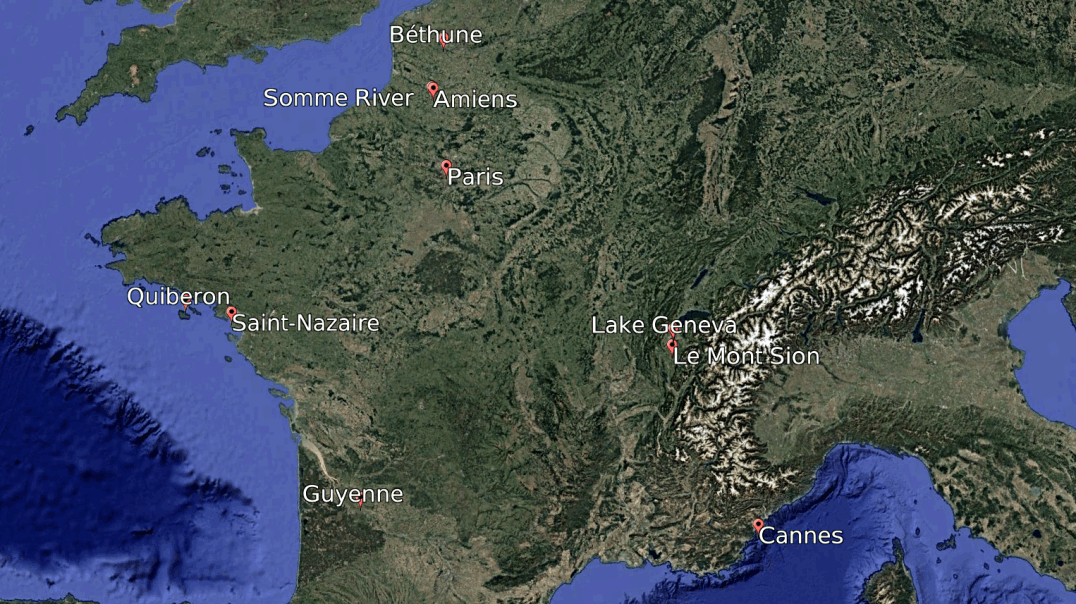
Jerusalem equates to Paris ...or vice versa. No coincidence in the names there, but the author points out that the Pharisees, the traditional opponents of Jesus, were actually the Parisees with the ‘h’ silent or dropped, which later modified to Parisians. We can completely ignore the Julius Caesar Roman cobblers about the name of Paris and the theories about the origin of the name are myriad. One interesting idea is “it may derive from the Celtic root pario- ('cauldron').” The most dominant of the official dogma is that it comes from the Parisii tribe, who can also be found in East Yorkshire, northern England, according to the Greco-Roman clever-dick, Ptolemy ...so more cobblers then. Oh yes, then there’s all the Trojan War business, with Paris being a leading player, or so the not-so-ancient Greeks say.
Whilst the name doesn’t give any clues to the association between Paris and Jerusalem, its geographical location, when examined in conjunction with the identifiable sites, does. This is further enhanced by the features of Paris, which tell a very compelling story. Golgotha, or Calvary, finds an exact match with Montmartre, ‘the mountain (or hill) of the martyr’ and not only through its location outside of the city. Upon the top of Montmartre is the ‘Sacre-Coeur’ Cathedral, the Cathedral of the Sacred Heart of Christ. On the 15th August, 1534, Ignatio Loyola and six mostly marrano Jews from Spain, met on Montmartre to establish the Society of Jesus, or The Jesuits. They swore the usual oaths in a crypt beneath the Temple of Saint Denis, now Saint Pierre de Montmartre. Today this place is a little known landmark, even by Parisian taxi drivers, but it was a place of pilgrimage in the Middle Ages and the crowned heads from all over Europe went there. Speaking of ‘crowned heads’ the Saint Denis just mentioned, was supposedly decapitated and then picked up his head and walked several miles while preaching a sermon on repentance. Sounds remarkably similar to the Bran the Blessed story.
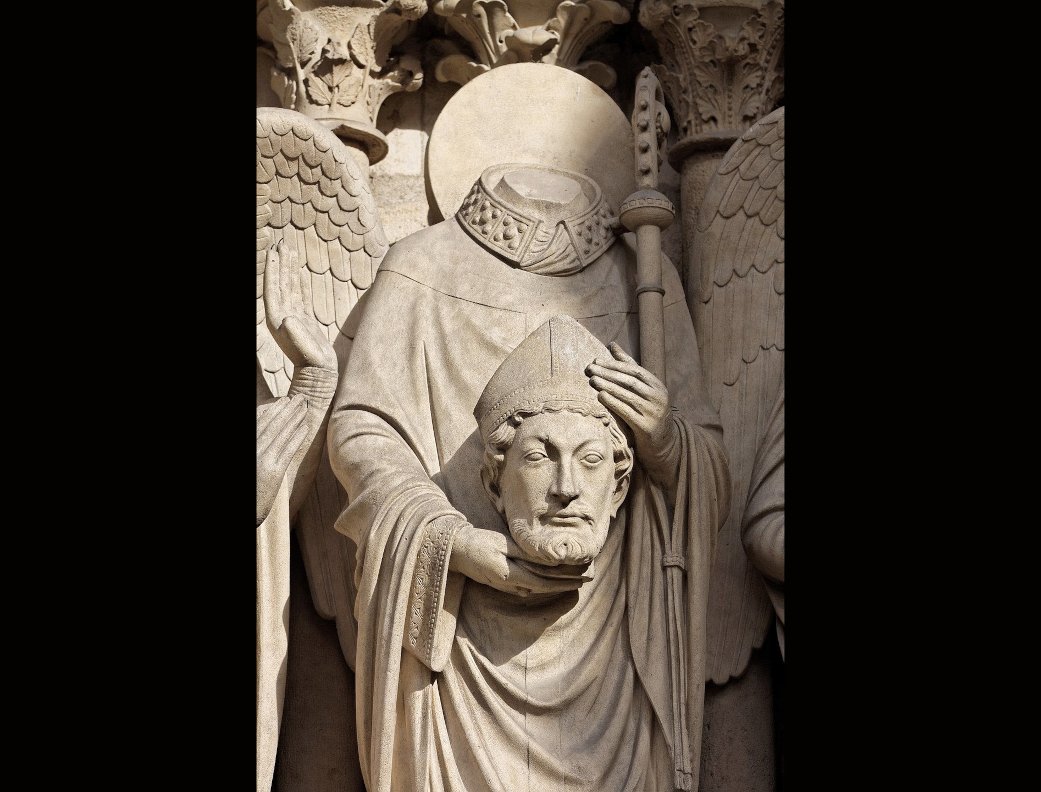
Saint Denis holding his head in his hands.
Statue at the left portal of Notre Dame de Paris.
Thesupermat, CC BY-SA 3.0
I think its notable that the Jesuits chose the site of the crucifixion, real or symbolic, as the most suitable place to consecrate their new order. It certainly makes you wonder.
Later, at the end of the 19th century, another Jesuit, Cardinal Heber, was responsible for the building of the Sacre-Coeur upon Montmartre. According to a documented speech he gave, "This is it, this is the place of martyrdom!" he cried out, "This is the place where the holy heart must rule, where it can cry out incessantly at the foot of the hill where Christianity was born, born among us in the blood of our first apostles, a monument to our religious awakening must be erected." This speech can be found in a number of brochures describing the construction of the Sacré Coeur – which was very closely controlled by the Jesuits.
You will notice the speech doesn’t actually name ‘Jesus’ or ‘Christ’. So, they were creating a monument to the birth of the Christian religion, born from the blood of the apostles, and erected at the place where the martyr was crucified and from where the 'holy heart must rule’ and cry out incessantly'. That should be made a special note of and kept in a safe place for later.
Of course, the Cathedral of Notre Dame, or Our Lady – i.e. The Virgin Mary – is also an important part of Paris. It’s home to the Crown of Thorns, and the cathedral itself was once decorated with statues, 28 of them and all kings of ancient Judea(!?*) They were removed in the 18th century and what remains of them can be found in the museum of Cluny, in the centre of Paris. I wonder if anyone ever had a hunch to put them back?
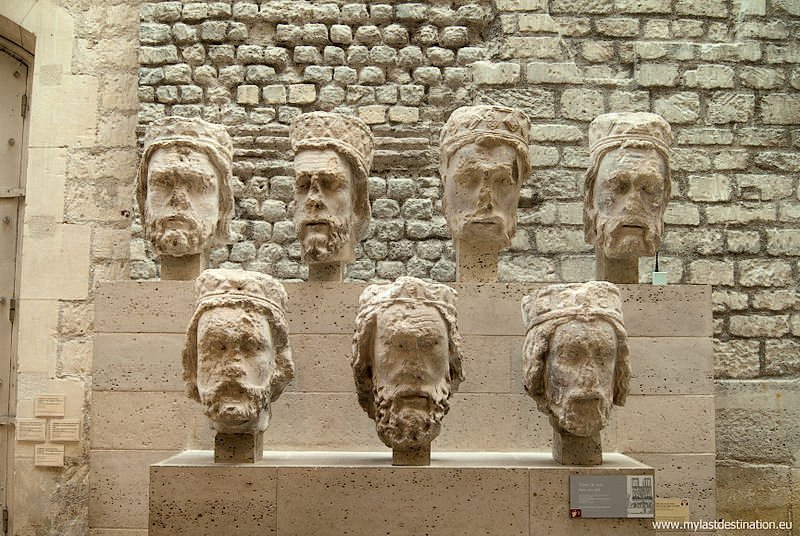
The remaining heads of the Judean Kings, looking very un-Jewish
Compare with Ignatius Loyola above. Source
Another peculiarity In Paris dating from the 12th century, was a cemetery called ‘The Cemetery of the innocent infants murdered by King Herod’. Originally, only infants were buried, but later they began to bury everyone in it. Once again in the 18th century, it was closed – there seems to have been a clean up going on at that time. By then it’s name had been changed to "Cemetery of the Innocents" due to a shortage of paint for the new sign. There are no such cemeteries in the Middle East and no record of there ever having been any.
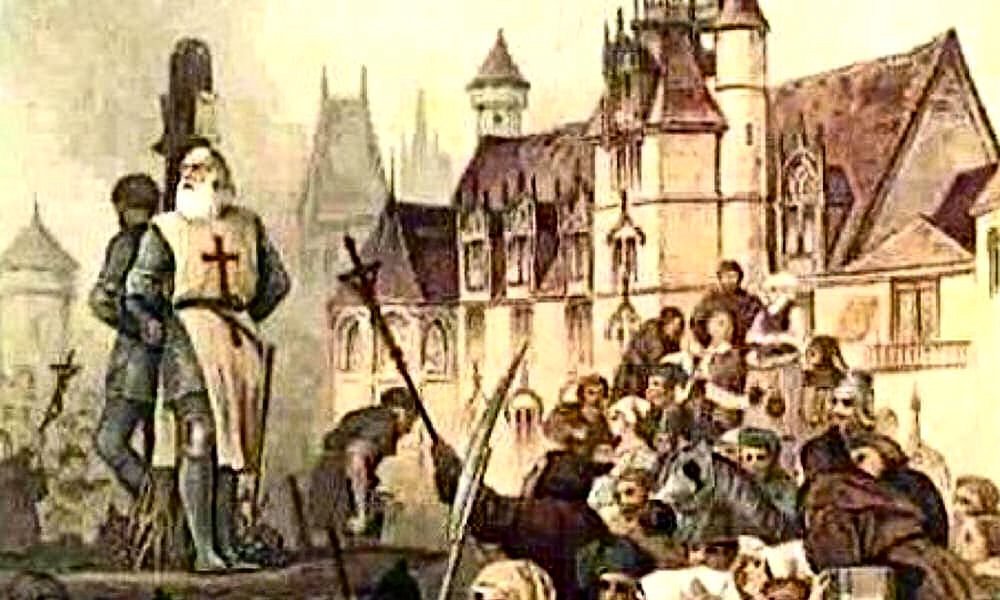
The Burning of Jacques de Molay
Source
A Temple Street still exists in Paris, where there was once a Temple, or at least the tower or Tour du Temple. The Knights of the Temple were, of course, the Knights Templar (Knights of the Temple of Solomon) and their headquarters were, where else, but in Paris. Which is the same place where their order was dissolved with the execution of Jacques de Molay on the Isle de la Cité – the very heart of Paris – which has always been known as the ‘City of the Jews’ or ‘Island of the Jews’ by the Parisians themselves.

Isle de la Cité. Paris
Source
The relics of Saint Helena, the supposed mother of the Emperor Constantine, The Great, are today claimed to be in the Église Saint-Leu-Saint-Gilles, in Paris. They were transferred from the Abbaye Saint-Pierre d'Hautvillers, north-eastern France, in 1819. Actually, her relics are claimed to be all over Europe, so she probably travelled more when she was dead than she did when she was alive. The claim that at the age of 80, she went Jerusalem, excavated relics of the True Cross, and returned with them to Gaul are far-fetched, not just because there was no Roman Empire in the 4th century AD, but also because of the logistics: the distances and the physical demands of the trip make it highly unlikely that it ever happened. The circumstances surrounding her burial and the sarcophagus she was buried in, are also quite bizarre. The author of the post believes that Helena lived in Trier, in the Rhineland of Germany, and suggests that her destination was not the Jerusalem of the Middle East, but to Paris, which is a much more manageable journey for someone of her age, at that time. It’s even officially claimed that she returned to Trier rather than Constantinople or Rome, which is a bit of a give-away. She was assisted on her journey by Judas Cyriacus. Such a place name doesn’t exist in the Middle East, however, there was a Saint Cyriacus who was born in Gaul and preached in Trier. Of course, there’s a whole other legend about Helena, that she was the daughter of King Cole of Colchester in England. In another she was Saint Elen, a Welsh princess. Of course, these other stories are all dismissed as being simply mythology, legends, bullshit, whilst the Helena one is “the gospel truth,”·a term which is beginning to look more and more like a misnomer.
Just about all of the major ‘stars’ of the gospel stories ended up in Gaul, either dead or alive. Pontius Pilate; his wife, Claudia Procula, was from Narbonne; Herod Antipas and Archelaus (another son of Herod the Great) were also exiled by Caligula to Gaul and died there. Mary Magdalene sailed to Gaul and according to the stories, continued to live in southern France. Her remains are still located in Provage in the cathedral of Saint-Maximen. The city of Magdala, from which the name Magdalene may be derived, is not located in Palestine, but in what is now Germany, although not very far from what was Gaul. It’s quite possible that the woman from whom Christ supposedly cast out the seven demons is the same Mary of Magdala, from the German Magdala.
Joseph of Arimathea’s alleged remains are in Gaul at the Benedictine Abbey of Marienne Moutier. He is supposed to have arrived in Gaul with Saint Lazarus (who is buried in the cathedral of Autun, central-eastern France… well bits of him,) and his sisters Martha and Mary, and also the Apostle Philip. We’re further told that he preached for some time in Gaul, although what language did they do their preaching in... Aramaic? However, if instead of being cast off from the Holy Land in a boat with no sails or rudder, they were actually locals, then everything makes sense. Lazarus, who died and was raised from the dead in Bethany, or rather Bethune, northern France, became the first bishop of Marseilles. Mind you, there’s another legend about Joseph of Arimathea preserved in the ‘Sone de Nansai’, where he is the patron Saint of Norway who guards ‘the Grail’ and ‘the Lance’ in a monastery on an island in the interior of Norway. There’s weird genealogy that relates Joseph to other members of Arthur’s Round Table. He has became infatuated with the daughter of the Pagan King of Norway, whose father he killed. In spite of being baptised, she is still a Pagan at heart, but he marries her anyway. This angers God who punishes him for his sins. God turns the island into a Wasteland and curses Joseph’s lineage.
As to the apocryphal account of Joseph of Arimathea taking the young Jesus on a business trip to the Britain, which gave rise to all the William Blake “And did those feet, in ancient times…” stuff, unfortunately that also only makes sense if the trip was from France to Cornwall and back again, not from the Middle East..
Writings of the supposed ‘church fathers’ of the first centuries claim that, Joachim and Anna were the grandparents of Jesus. The remains of St. Anne are now located in the town of Apt in south-eastern France. However, in Brittany there’s a cult of St. Anne, which is only traceable to the 13th to 14th centuries, as per the official data. According to legend, she was a Breton woman and Joachim lived in Jerusalem, they met and married. So, how could Anna get to the Middle East in order to meet Joachim? Or, how could Joachim get from the Middle East in order to meet Anna in Brittany? How could they have communicated… in Aramaic or French? First, the question is, in what Jerusalem could Joachim meet Anna or where could they meet at all? This was the subject of much debate in the 19th and early 20th century, but it was gradually abandoned entirely. Brittany is very close to to the city of Kebren (Hebron) and to the city of Saint-Nazaire (Nazareth.) So Kebren (Hebron) was the location of John the Baptist’s family, who were close relatives of Joachim and Anna’s family, who lived in nearby Brittany. Joachim and Anna’s daughter, Mary, married and ended up in nearby Saint-Nazaire (Nazareth,) with the baby Jesus. By the way, the head of John the Baptist is currently in the city of Amiens, north-eastern France, which was formerly Samara-Brega, or Samara-Breva, and not a million miles away from Kebren (Hebron).
Most of the apostles are buried somewhere within, or near to, Gaul. Most of the medieval pilgrimage routes go through the territory of modern-day France, with routes into what is now Italy and northern Spain. The latter being the route to Santiago de Compostela, with its tomb of Saint James. Most of the routes within France during the medieval period went through precisely the places that have been identified as the French ‘doubles’ of those in the gospels. One such famous place of pilgrimage was to Montmartre in Paris.
The Turin Shroud first appeared in the mid-14th century in France, and from a family directly related to the Templars. Radiocarbon dating gave AD 1260–1390, which is consistent with it’s first appearance. At this point I’m going to let the author give you his own conclusions...
“So if this is the 12th/13th century, then it fits in with Fomenko's concept that the Gospel events took place in the 12th century, and it fits in with what I am saying, that the Gospel events took place in what is now France, that is in Gaul, and it was probably somewhere in the late 11th or 12th century, probably early 13th century... In general, if we're talking about relics associated with the Passion, most of them surface in Europe in the 14th century, either late 13th or 14th century. There are, of course, some exceptions, but the vast majority of these relics are late thirteenth, fourteenth century.”
Personally, I’m going to keep an open mind on that point at the moment because it doesn’t quite fit with the notion that Christianity arrived in England with the Normans in 1066 as a fully featured religion. Nevertheless...
The author then goes on to talk about the supposed scarcity of wood in the Palestine / Israel region, and it’s unlikely use as a method of execution. This is a valid point today, however, as illustrated in the DECs Part 2, this area was within the Persian (Iranian) Empire and their national history shows that the climate was very different prior to the cataclysm. Therefore the issue regarding the scarcity of wood depends upon whether the crucifixion was before or after the 10th century cataclysm but, given that the author dates it to the late 13th or 14th century, it is a valid point.
Other relics include the iron crown of the Langobards, or Corona Ferrea. It’s claimed to have been made from one of the nails used to affix Jesus to the cross. This appeared in 1311 and it’s now in Italy, not far from the present-day France. Scientific analysis has shown that, “The ‘iron nail’ was found to be 99% silver, meaning the crown contains no iron.” (Wikipedia) Then there’s the blood of the Savior, which was allegedly collected by Joseph of Arimathea. This is now in Bruges and again, it first appeared in 1311.
One of the most famous relics is the Spear of Destiny, or the Spear of Longinus. This featured in The Elucidation as being the ‘seventh guardian’, but it was obviously a later Christian substitution. It has been the subject of many interesting stories, even Adolf Hitler supposedly tried to get his hands on it. The first reasonably reliable mention of it appeared in the 13th century. In 1354 Emperor Charles IV ordered an inscription to be engraved on the spear in order to identify it as being ‘the original’. The lance arrived at Paris in 1242 as part of a ‘job lot’ purchased from Baldwin II of Constantinople and they were kept in the Sainte Chapelle (Holy Chapel) on the Île de la Cité in Paris. However, the lance vanished after all of the relics were removed to the Bibliothèque Nationale during the French Revolution.
Valencia in Spain is home to the Holy Chalice, which is supposed to be the cup from which Christ drank at the Last Supper. This first popped up in the monastery of San Juan de la Peña during 1399. In the city of Aachen in Germany, there’s a museum displaying three flasks containing some of the ‘greatest relics of the Christian world’: the dress of the Holy Virgin Mary, the scrolls of Christ, his armband, his iPod and the shroud of John the Baptist. They were first shown in 1349. The remains of St. Mary Magdalene appeared in Provence, south-eastern France, at the end of the 13th century and pilgrimages began in the early 14th century.
There are even more, but I’m rapidly losing the will to live here, so please read the original post on stolenhistory.net if you need any more convincing.
This subject has been covered before in the DECs Part 2.5 and even then it was remarked that the Crusades origin and greatest participator, was France. In that article, a map appeared showing the origin of the first crusaders. I’m going to reproduce it here as it serves as an excellent indicator as to where The Rich Company settled after their capitulation to Arthur.
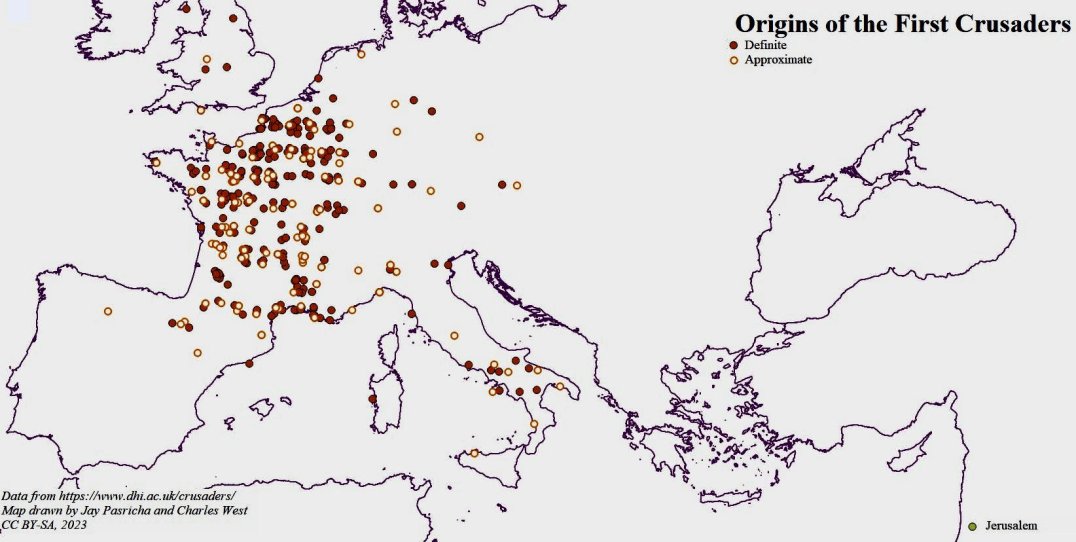
Charleslincolnshire, CC BY-SA 4.0
Alexey Khrustalyov, the author of the France – Biblical Israel material, also noted that the first crusade was initiated by and consisted of, ‘The Franks’ almost exclusively. He then states…
“My guess is that the crusades are (were) just a special operation to relocate the scene, if they were crusades at all… if we accept that there were crusades, we must clarify when they were. Because the Arabs, the Arab sources say that they fought the Franks…. And if we understand that the crusade was a crusade of knights and quite specific knights, then it is likely that it was a very real special operation… to create a kind of mirage on the territory of ...present-day Palestine. That is, so that you could always say where it happened, where Christ was crucified, there - in Jerusalem, he was crucified far away, and then again, everything becomes clear, everything becomes in line, why they were there so briefly… The myth was created that all this was happening in that Galilee, in that Judea, there in those lands, not in the territory of Gaul, but in the territory of some distant land, so that there was someone to point the finger at. Well, who would want to be responsible for the crucifixion?”
Once again, I’m going to keep an open mind on that idea. Somehow I don’t find it to be a particularly valid argument…
And, even if it did, was it during the 13th to 14th century? Whilst the evidence for the placement of the Holy Land in France is compelling, it doesn’t necessarily follow that the events described in the NT gospels actually took place there. It’s a kind of ‘double bluff’ really, in that a lot of effort has been put into relocating the events in question to the Middle East and, more importantly, the vast majority of the world believes they did happen there and has done so for centuries. However, if you scratch a little deeper and manage to discover that those events couldn’t have, and didn’t happen there, but in France, then you will still believe those events actually happened – just in another place. But what if they didn’t happen in either place?
It’s easy to forget that the entire Jesus saga is not original, it had all happened, or rather had been written about before. For example, the following are all attributes of the Persian god Mithra:

Mithra
Source
Furthermore...
“The cross of Christ, as experts seem to agree, was actually a bar placed across the top of an upright, so it was not a cross at all. It was a “Tee” (T), called “Taw” in Hebrew and “Tau” in Greek. So the cross that the victim was suspended from was actually a crossbar, and perhaps in those days this was called the cross. The “Taw” sign was the symbol of the dying and rising god, Tammuz, and “Taw” was the sign that was made on the heads of those marked for salvation by the god.” (Lloyd Graham, 'Deceptions and Myths of the Bible'.)
There were many other similar ‘religions’, or cults, that compare to Christianity such as the Horus story, the Stoics, etc. Try searching for “forerunners” or “precursors” of Christianity on the internet and you’ll find that both of those words have been totally hijacked and redefined as Christian terms for prophets and/or the earliest supporters of Jesus.
There is one huge difference between Christianity and its ‘ancestors’ though. The crucifix doesn’t represent the Sun God (or Goddess) being reborn, bringing fertility, light and abundance to the world, but rather the Son of God suffering because of your sins. The Sun God on the Cross became the surrogate, or a ‘Strawman’, representing all of mankind and Jesus took that role on the cross. This was a massive and significant corruption and deception. Christians are indoctrinated into believing that Christ suffered and died on the cross for mankind because of its sins against God, that the death of Jesus was mankind’s responsibility. The crucifixion was mankind’s punishment for having been born, or even created in the first instance, with a sinful nature.
And yet, the supposed crucifixion of the Strawman wasn’t enough to wipe the slate clean because, according to Christian doctrine, we are all tainted by ‘original sin’ simply through the act of being conceived. To stand any chance of redemption, everyone must be exorcised, or rather baptised, and marked with a symbol of God’s chosen instrument of suffering and death – the crucifix – a sign of our contract with God to seek salvation. This salvation can only be achieved by our identification with the crucified Strawman, whereby we suffer and die, just as he did, only then can we ‘rise’ again and find redemption in heaven… or even more suffering in hell.
This is the original Sun God motif, totally twisted and redefined. Any relation to the fertility of the land and the prosperity of the people has been completely obscured and replaced with fear, guilt and subservience. The feminine has been totally subdued by the masculine, the Ying by the Yang – no harmony, no balance.
In Felix’s ‘Nature of the Beast’ series, he included an entire article to Miracles and Apparitions. The redefinition and inversion was still very apparent in the communications received, and registered as genuine miracles by the church. In Fatima, Portugal, 1917…
“Make of everything you can a sacrifice, and offer it to God as an act of reparation for the sins by which He is so offended, and in supplication for the conversion of sinners. You will thus draw down peace upon your country. I am its Angel Guardian, the Angel of Portugal. Above all, accept and bear with submission the suffering which the Lord will send you.”
“Most Holy Trinity, Father, Son and Holy Spirit, I offer Thee the most precious Body, Blood, Soul and Divinity of Jesus Christ, present in all the tabernacles of the world, in reparation for the sacrileges, outrages and indifferences by which He Himself is offended. And through the infinite merits of His Most Sacred Heart, and the Immaculate Heart of Mary, I beg of Thee the conversion of poor sinners.”
“Take and drink the Body and Blood of Jesus Christ, horribly outraged by ungrateful men! Make reparation for their crimes and console your God.”
This was all happening to 3 children…
They were told that they were required to be there and meet with it [the entity] at the same day, time and place for the next 6 months. The children asked if they would be going to heaven and were told that they would, although poor little Francisco needed to say 'many rosaries first'. They asked about friends who had passed away and discovered that one 'will be in purgatory until the end of the world.' Then the entity said,
“Are you willing to offer yourselves to God and bear all the sufferings He wills to send you, as an act of reparation for the sins by which He is offended, and of supplication for the conversion of sinners?”
“Yes, we are willing.” was the reply.
“Then you are going to have much to suffer, but the grace of God will be your comfort.” Finally the entity told them to, “Pray the Rosary every day, in order to obtain peace for the world, and the end of the war.”
There’s much more in the exact same vein, but I won’t repeat it here as it makes my blood boil. Of course, there’s always the Christian manipulation factor to bear in mind regarding the messages above, however, the experiences were real enough. I recommend the original article ...if you can bear it.
Anyway, the point is that the Jesus story is not original (only its redefined presentation) and all of the other antecedents, obviously, came before. Now we discover that all of the locations given in the gospels as being in the middle-eastern Holy Land, never existed at all. Also, we know that the Roman occupation of it during the time claimed – 1 AD – never happened. So, both the time and the place are fictitious, the storyline is not original – why should it all become ‘the truth’ just because the locations were actually in France and the time it allegedly happened was during the 13th – 14th century? So, the first crusade supposedly took place in the 11th century – 200 years before Jesus was supposed to have been born?
Let’s recap. The NT gospel stories were set in France – in other words, the backdrop for the stories was France, therefore the author, or authors, lived in France and was, or were, familiar with the topology / geography. The capital of France, Paris, was chosen for the starring role of Jerusalem. The stories included supporting roles featuring Jews and Romans, neither of whom were present in Gaul / France prior to the Middle Ages.
The dramatic finalé took place in a specific spot within Paris, a generally secret place that was later known to be a meeting point for all the crowned heads of Europe… a kind of early Bilderberg group. Let’s not forget the Jesuit involvement with that place either. Conveniently, the stories also tell us that all of its major characters somehow or other, ended up in Gaul, or France. Even more conveniently, their remains and other relics, or the props used in the play, are now preserved and scattered all over France. Then comes the bombshell – all of the locations in the stories were subsequently exported to the Middle East. Obviously, the hidden agenda of the mainly French (Frankish) Crusaders, was to facilitate this relocation as much as was physically possible.
OK, we have stories that were written in France and that portrayed an event that didn’t happen where the story intended to make us believe it happened, or when it claimed it happened. It included factions that never existed, either in France at the time of writing, or in the intended location at the time we are led to believe it took place. The stories included their own ‘alibis’ by stating that all of the remains and relics ended up in Gaul / France. Of course, making them available in France was not difficult at all, not to mention highly profitable. However, the greatest clue of all is that the stories written in France were written about events that were meant to have happened in the Middle East about 1000 years previously – they needed no modification in order to be relocated to the Middle East because they were always intended to be relocated from the very beginning. What I’m trying to say, in a very clumsy way, is… imagine that a French theatre company, based in Paris, was intending to go on tour with a play concerning a story that happened 1000 years before in the Middle East. They wrote the play in France, using French geography for the different locations. They used Paris as the centrepiece, or reference point. When they actually went ‘on tour’ to present the play, the reference point became Jerusalem. That the peripheral locations didn’t match up in the Middle East didn’t matter, because of the 1000 year gap built into the story – time enough for places to come and go. The main actors and props used in the story were all left behind at various locations throughout France, because the story itself states that they ended up there.

There is far more going on here than simply transferring the guilt of the crucifixion away from France, or the French. Which doesn’t actually make sense anyway, because the stories make it quite clear who the perpetrators were – he was arrested, tried, found guilty of blasphemy and sentenced to death by the Jewish leaders. The occupying Romans carried out the sentence. The stories don’t mention France or the French as being involved in any way.
Looking at it all from that point of view, it’s clear that the stories were conceived to be a deception from the very beginning. The question of “Why?” then takes on a new dimension.
Alexey Khrustalyov also covered the Old Testament in his France – Biblical Israel post. Actually, to be perfectly honest, I found those sections of the post very difficult. I had trouble following the etymological leaps and bounds regarding the names. Basically, once again, the place names of the OT don’t exist in the Middle East. Once again they can be identified in Spain, the Pyrenees and France ...apparently. It’s also stressed that there never was any gold in Israel, but in and around the Pyrenees it was abundant. Rather than spend any more time on this, from what I can understand it seems that the OT is the record of a tribe, led by Moses, being guided by a supernatural figure out of Spain to the ‘promised land’ of Judea in France. This involved many battles and stuff.
All of this led Alexey Khrustalyov to ask the following question:
“Whose religion was Judaism before the adoption of Christianity in Europe? Jews or Europeans? If only Jews, why are there so many Jewish names in the ruling dynasties? If Europeans, why is the history of Judaism actually privatized by Jews? Who was interested in squeezing Judaism out of Europe and for what purpose?”
The trouble is, he doesn’t answer it.
The subject of the Old Testament is one that’s been discussed before on this website with regard to its reliability and validity. During the same post-cataclysm time period we are discussing here, the OT was being created by the Masorites. I won’t regurgitate all of that again, but if anyone is interested it’s here.
There’s an intrinsic problem with all of this. There’s a distinction between Judea and Judaism. Judea is a place, but Judaism is a religion and one that’s not based upon the Hebrew Bible, but on Talmudic law. In the gospel stories, the teachings of Jesus and his disciples were based upon the written Torah of Moses, not the Babylonian Talmud. Many people call Christianity a Jewish cult, but that just isn’t the case. In the stories, Jesus made it clear that the corrupt Jewish leadership—and, by extension, Judaism itself—was fully disqualified from having any meaningful role in the establishment of the Kingdom of God. The roots of Christianity are Abrahamic, but they are not Judaic.
“The so-called ‘Judeo-Christian tradition’ is in reality a myth created purely for political and social reasons. In fact, the concept has more to do with post-1945 ‘anti-Semitic public relations’ than it does with historical or religious reality. Apparently, the catch-phrase began to be used in the 1920s by the National Conference of Christians and Jews in an effort to combat anti-Semitism and to balance the then-dominant rhetoric that America was a ‘Christian-Protestant’ nation. Essentially, the term ‘Judeo-Christian’ was coined in an attempt to create a cross-denominational religious consensus that, by including Judaism, avoided the appearance of anti-Semitism. The Internet site Wikipedia notes: ‘Promoting the concept of America as a Judeo -Christian nation became a political program in the 1920s in response to the growth of anti-Semitism in America.... [Ultimately, the] phrase 'Judeo-Christian' entered the contemporary lexicon as the standard liberal term for the idea that Western values rest on a religious consensus that included Jews’ (wikipedia.org/wiki/Judeo-Christian).” (Source)
All of this obviously links with the 28 heads of the Judean Kings that once adorned Notre-Dame cathedral – the surviving ones all being decidedly un-Jewish looking. I assume the implication of it all is that France was the Judean ‘Promised Land’ and not Israel. I suppose, in a way, it’s a kind of logical progression, or regression, from the NT being located in France theory, but for me it doesn’t really work and isn’t as convincing.

“OK, we’ve come for Judea! Vamonos!”
Once again ,during this same post-cataclysm period, history was frantically being created or rewritten in order to comply with the new biblical narratives of both the Old and New Testaments. One such example of this, the 12th century "Leabhar Gabhála" manuscript, known as the 'The Book of the Taking of Ireland' , is worth mentioning again (it was featured in earlier articles.)
“The writers sought to create an epic written history comparable to that of the Israelites in the Old Testament of the Bible. This history was also intended to fit the Irish into Christian world-chronology and connect them to Adam. In doing so, it links them to events from the Old Testament and likens them to the Israelites. Ancestors of the Irish were described as enslaved in a foreign land, fleeing into exile, and wandering in the wilderness, or sighting the ‘Promised Land’ from afar. The account also drew from the pagan myths of Gaelic Ireland but reinterpreted them in the light of Christian theology and historiography.” (Source)

“Wood dat be de promised land over dare now Shamus?”
This book was an instant hit, even acquiring canonical status. Older texts were altered to bring their narratives into closer accord with its version of history. Numerous new poems were written and inserted into it. Within a century of its compilation there existed a multitude of copies and revisions, with as many as 136 poems between them. Five editions of the LGE have survived in more than a dozen medieval manuscripts and this is just one example!
THE OT WAS A TEMPLATE / BLUEPRINT and part of the overall ‘New Religion’ package. With its profusion of contradicting ‘wisdom’ and confusing versions of identical events, the OT provides ‘divine’ justification for just about any agenda, or outrage. It contains the recipes for all of the future religious wars, ‘revolutions’, genocide, and hatred that we have come to know as our shameful history. So, what was the real reason for the NT stories being devised in one place and then shifted to another?
In 2019, Felix wrote an article about Dr John Dee and his relationship to The Hellfire Club. In that article he speculated that the enormous quantity of obelisks and towers throughout the UK were actually a communication network that used Ley Lines. Back in 2021 I wrote an article called ‘The Great Storm, The Black Alchemist & Toxic Ley Lines’. It was all based upon Felix’s and my experiences during and after, the ‘Great Storm’ of 1987 in the UK. I remember commenting that the subject of Ley Lines and Earth Energies had obviously become ‘technicalogicalised’ since 1987. Later, as the final part of ‘The Quest for the the Lost Realm of Faërie’, we discussed ‘The Earth Energy Grid & The Way of Wyrd’. Neither of us have done any significant research on Ley Lines since then, just bits and pieces here and there. Well, what a shock I had when I took a look at the subject recently. It seems it’s taken off in a big way, although whether that’s a good thing or not, is something I’m still questioning. These days it encompasses such things as the ‘yoga of harmonic resonance’ and uses terms like “cosmo-telluric energy.” It’s a constant source of amazement to me, how we humans always need to complicate everything that should be simple and then make a huge song and dance out of the invented gobbledegook... each to his own I suppose.
At the beginning of this article I discussed the Ley Lines of London, which was based upon information that I’ve had for quite a long time. Here’s a brief update showing an energy network within London that links to longer distance Leys and therefore, into the worldwide ‘grid’…
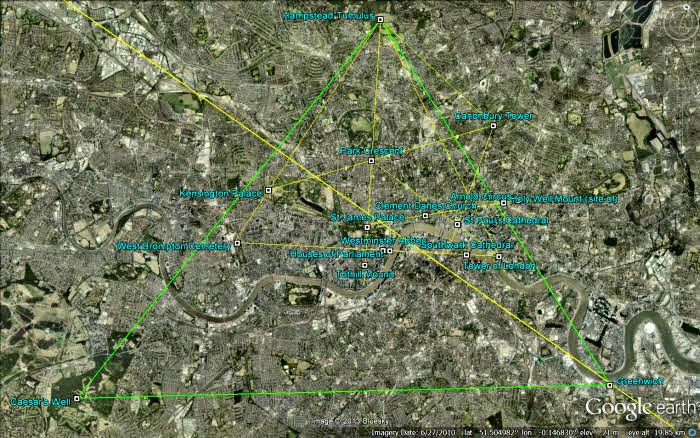
The London Ley Network
Source
Hopefully you will notice that it encompasses the Ley Lines that were mentioned at the beginning of the article, showing how they integrate into a pattern of related alignments, although I know the image isn't the easiest to read. I was very keen to see if such a network exists in Paris, given all of the foregoing material. I tried the Google Earth, Ley Lines overlay, but it’s rubbish, so finding a similar map for Paris was not easy at all. Luckily I found a boOOok; ‘The Sacred Network’, by Chris H. Hardy – a French lady.
I’m going to paraphrase, as some of the ‘gobbledegook’ is quite distracting…
«Ms Hardy believes that a sacred network of Ley Lines and their corresponding alignments, influences populated areas and directly affects the lives of the inhabitants. These energy lines are imprinted and strengthened by the beliefs and thought-forms that were consciously and deliberately generated by the intentions of those who conceived and constructed the structures that form the alignments. This imprinting also occurs through the local inhabitants, who either attend the rituals performed within them, or undergo intense emotionally charged experiences therein. These energy lines and their intersections, accumulate and transmit all of this energy.»
«These enormous, world-wide interconnected networks of standing stones, temples, obelisks, monuments and even sculptures etc., have been maintained and even enhanced, right up to the present day. This reveals that the knowledge and use of these networks goes back centuries and, if it’s not always directed from the highest levels of government, it's at least endorsed by them. Given the expanse and interconnection of these networks across different countries and cultures, the co-ordination, administration and maintenance required implies the existence of an intrinsic stable means of communication which allows contact between high initiates of various faiths and secret societies all over the world. The question then becomes: Is the overall web of sacred networks operated by a single organization of interrelated initiates? Or, is there a shadow network that quietly monitors all the activities of the various secret societies?»

Very interesting stuff. Let’s shelve those questions for the time being. We will come back to them later. Ms Hardy’s research concerning the Paris network is quite mind-blowing and quite difficult to visualise… The heart, or centre of the network, is the Paris Obelisk, which was originally one of a pair, and came from the Temple of Luxor in the Middle Eastern Egypt, but it only came to Paris in 1833. Obviously there must have been something there before, and indeed there was – the main location of the bloody guillotine during the French Revolution! So, even more severed heads. The pedestal they erected it upon was originally home to a statue of Louis XV on his horse, but that was destroyed in the 1792 Revolution. The obelisk came to France along with a portion of its original plinth depicting male baboons, in an obvious state of arousal, doing ‘the funky gibbon’ with their hands raised to the Sun. When it arrived it was deemed too much for public exhibition and they shoved it in the Louvre.
If we go back further to try and discover the original feature that the Paris sacred network was formed around, things don’t get much easier. It seems that the site was originally just an empty space on the outskirts of the city. It must have become the ‘centre’ of the city much more recently.
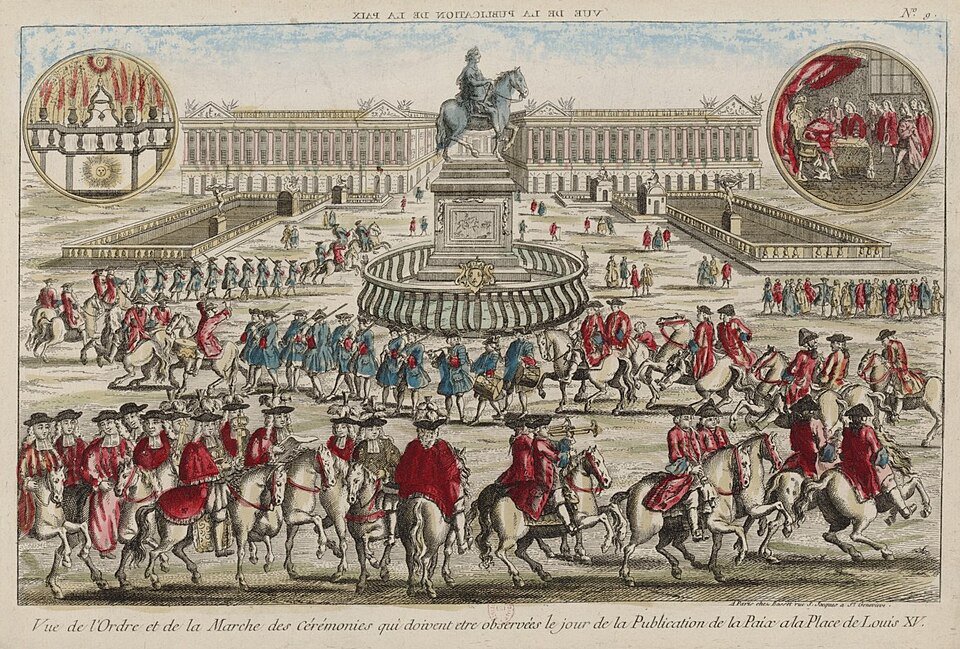
Ceremony on the 'Place de Louis XV' in 1763.
And now a word... sorry 17 words, from our sponsor: Bibliothèque nationale de France, Collection Michel Hennin.
Estampes relatives à l'Histoire de France. Tome 105, Pièces 9111-9208, période 1762-1764. CC BY-SA 4.0 FFS!
However, in 1748, the ‘merchants of Paris’ commissioned a statue of Louis XV to commemorate his recovery from an illness… arse-lickers then. The finished article was a paved octagonal area with a small moat, bridges and staircases for access. The statue depicted Louis as a Roman general on horseback. On the four corners of the plinth were depictions representing the ‘virtues of great monarchs’; Force, Justice, Prudence, and Peace – in statue form. Two palatial buildings were added later. It was originally called Place Louis XV, then later Place Louis XVI, then briefly Place de la Révolution and finally Place de la Concorde. Both Louis XVI (Bourbon dynasty – not one of Melusine’s,) and Marie Antoinette were executed on that same spot, followed by a further 1,117 ‘aristocrats’ as the Reign of Terror progressed.
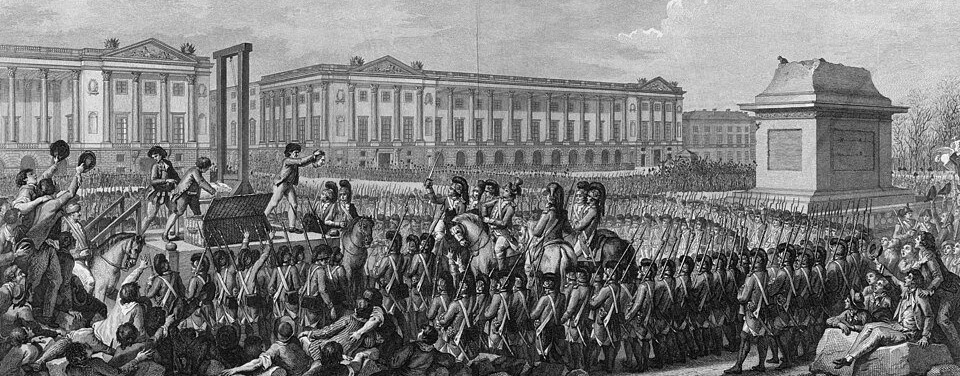
Execution of Louis XVI 1793
Isidore Stanislas Helman, Public domain
So, if we follow the principle that the intersections and ‘nodes’ of the sacred networks store and transmit energy, then it seems that the only significance of the central obelisk of Paris’ sacred network is a particularly nasty one. Interestingly, in view of the notion that these sacred networks are still being maintained and expanded today, the government of France added a gold-leafed pyramidal cap to the top of the obelisk in 1998, it replaced the original that went missing long before it arrived in France. I suppose by 1998, La Place de la Concorde was the centre of Paris. This coincided with the final phase of the controversial Grand Louvre project whereby pyramids were installed all over, and under, the Louvre in various orientations.
I managed to get the hang of using leylines.net and was able to produce this map…
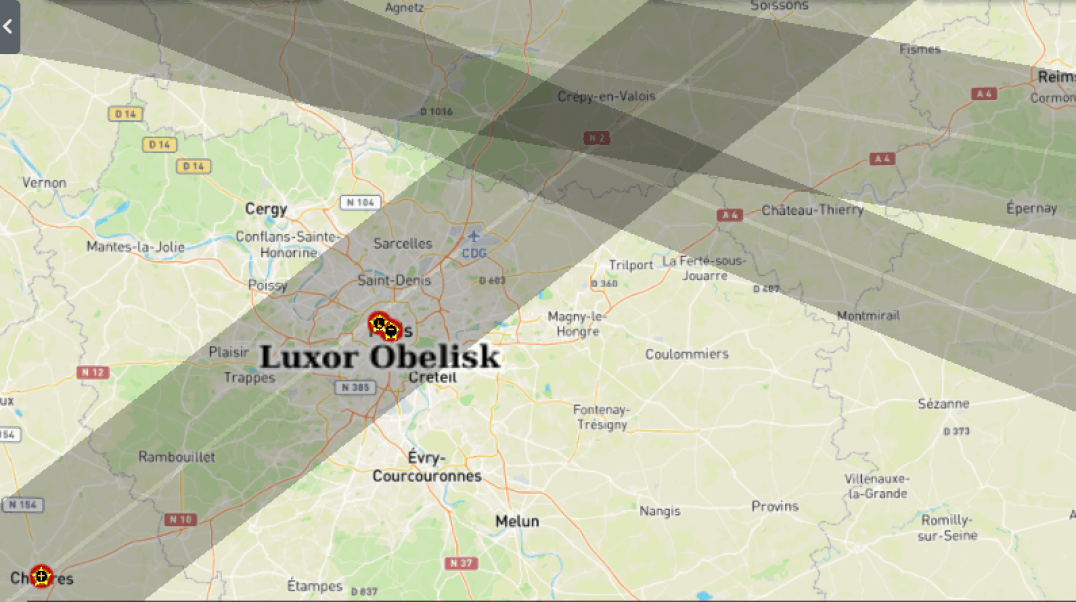
Paris is where the ‘Luxor Obelisk’ marker appears and right next to it is Notre Dame Cathedral. The line that passes directly through Paris is one side of the triangle that connects Externsteine (Aesch bei Forsch, Switzerland,) to the Giza Pyramids and the Azores. You can also see that it passes through Chartres Cathedral. The two lines that cross just above Paris and intersect the other line, comprise one from the Apollo – St Michael Axis, which begins in Skellig Michael (Co. Kerry, Ireland) and goes to the Stella Maris Monastery (Mount Carmel, Israel.) The other is an intermediate link of the Externsteine – Giza – Azores triangle… which I don’t understand at all to be honest. Sometimes I think that people just like doing those old ‘join-the-dots’ puzzles we used to have as kids. However, it is interesting to note that the Obelisk in the Place de la Concorde, has two fountains beside it which are aligned north-east and south-west, in accordance with the Externsteine – Giza – Azores line that passes through Paris.
With regard to the local network of Ley Lines in Paris, well, it all gets very complicated and actually quite astonishing. I highly recommend Ms Hardy’s book ‘The Sacred Network: Megaliths, Cathedrals, Ley Lines, and the Power of Shared Consciousness’ to anyone with a specific interest in such matters.

Paris ley Network
Source
For our purposes, the most important feature is the circle linked to the Obelisk hexagon: the one encircling it and shown in black, touching the points of the brown hexagram. It runs through several interesting churches and then gets to St-Pierre-de-Montmartre Church, otherwise known as the very Temple of Saint Denis where Ignatio Loyola inaugurated the Jesuits and where all the crowned heads of Europe went for secret meetings. More Leys converge on this small church than on the Sacré-Coeur Basilica next to it. (I think it’s just past the 12 o’clock position, where there’s a big building with a little one right next to it.)
The same circle, continues clockwise and runs through two churches strongly connected to the Knights Templar. Just after apex D we find Notre-Dame-des-Blancs-Manteaux (White Mantles), then the western apex H is marked by the flamboyant Gothic style St-Gervais-St-Protais Church, which marked the border of the Templars vast property in Paris. This was the headquarters of the entire worldwide order.
Ms Hardy notes other important alignments that run through Paris and beyond France. One from La Défense to the Obelisk runs through Mount Sinai (along a route that is 116 degrees south-southeast). I think that’s the Mount Sinai in the Middle East rather than the one in Europe. A second, known as the Royal Axis, runs through the Grande Arche and Palais du Luxembourg (120 degrees south-southeast), then goes through the Giza pyramids in Egypt and on to Mecca.
I’m afraid the map below is the best I could do, sorry it’s not very clear. I’m sure I had something better in my collection, but I can’t find it now. However, I remember it was a further development of the author’s original anthropomorphising of Israel as representing the human body, by the incorporation of chakras, so nothing whatsoever to do with the ancient tradition of Ley Lines. Anyway, the following image does a good job of demonstrating that Jerusalem is a kind of 'Clapham Junction' on the Ley Grid.
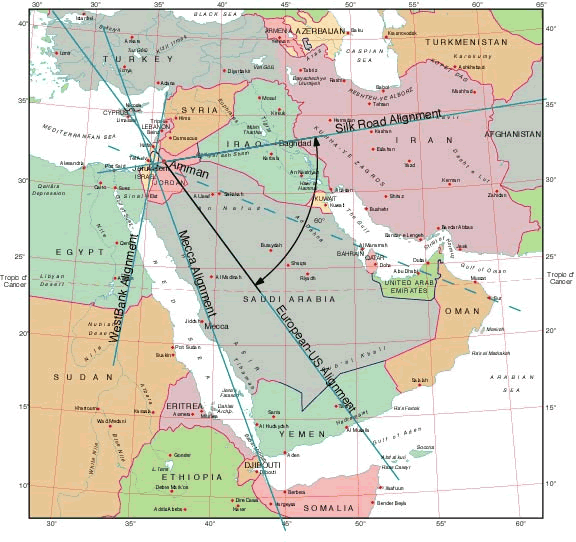
The Middle East Ley Network
Source
Since I last investigated the Apollo-Athena Lay Line, it now seems to terminate at Mount Carmel rather than Temple Mount in Jerusalem, although you still can find both options given on the web. Regardless, Mount Carmel is linked to Temple Mount by the West Bank Alignment shown in the above image. The precise location of the Mount Carmel site is the Stella Maris (Star of the Sea) Monastery and what a history that has. Today, it’s a is a Catholic Christian monastery for Discalced Carmelite friars… ‘discalced’ simply indicates that they only wear sandals on their feet, or nothing at all, as opposed to Calced friars who only wear stiletto heels and black seamed stockings. Anyway, the story goes that during the 12th century, when the Franks held their Kingdom of Jerusalem following the First Crusade, groups of religious hermits began to inhabit the caves of this area in imitation of Elijah the Prophet. Of course, this presupposes that they had read the Old Testament… which presupposes that they could read. Were they locals or French imports I wonder? Anyway, there are two caves, or grottoes, associated with Elijah on Mount Carmel. By the way, yes, there is an area called ‘Le Carmel’ in mid-western France, near Poitiers. Elijah is a very complicated character who was/is venerated by many different religions. In the Old Testiclement, he’s portrayed as fighting against Baal on behalf of Jaweh… well, he hid in one of the caves during the battle. In Islam and other non-Islamic beliefs, he is described as possessing great wisdom and mystic knowledge. He is regarded as an angel, a prophet, or even a god, who guards the sea, teaches secret knowledge and aids those in distress… very like Manannán mac Lir in the Celtic tradition. The main ‘Cave of Elijah’ is on a road that traverses Mount Carmel and it has been used as a shrine by Jewish, Christian, Muslim and Druze pilgrims for centuries. The other cave is beneath the altar of the main church of the Stella Maris Monastery. So, it must be an extremely powerful energetic point that was obviously very important even in pre-Abrahamic, Pagan times.
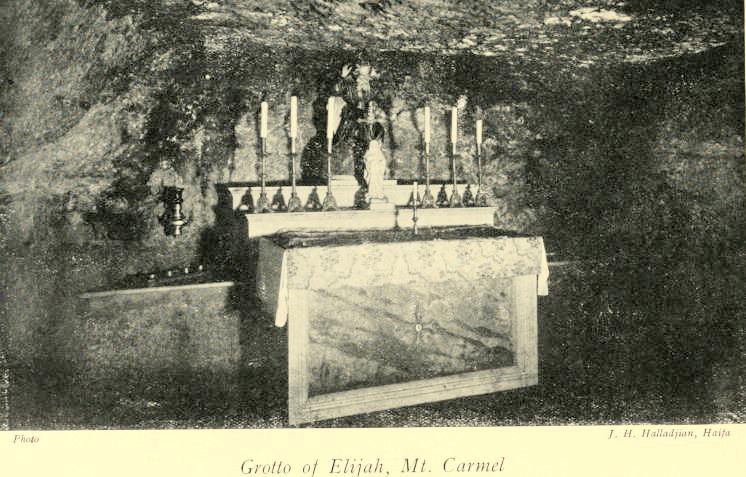
1913 postcard showing the altar inside the grotto of Elijah
Phillip Baldensperger, Public domain
So, these groups of cave dwelling religious hermits, turn up again in the 13th century with a ‘leader’ known as ‘Brother B.’ He asked the Patriarch of Jerusalem for a “a written rule of life,” with which he obliged them. They then became the 'Order of the Brothers of Our Lady of Mount Carmel' or Carmelites. A few decades later they were kicked out of the ‘Holy Land’ when Jerusalem fell to the Mamluks. They carried on spreading the word back in Europe until they were allowed into Palestine again in 1631. They built a small monastery on the promontory of Mount Carmel, but they were ordered to destroy the monastery and leave in 1761. Undaunted, they built a new monastery and a large church right on top of Elijah’s cave, after demolishing the ruins of a “medieval Greek church,” known as ‘the Abbey of St. Margaret’, or ‘Saint Marina the Great Martyr’, and a chapel – note the nautical association of the name ‘Marina’ which probably alludes to the original Goddess that the Christians replaced.
This site was then seriously damaged when Napoleon ran amok in the area during 1799. After he left, the Turks kicked the friars out. The site was completely cleared in 1821 because Abdullah Pasha of Acre didn’t want it to be used by his enemies while he attacked Jerusalem. The masonry was used to build Abdullah Pasha's summer palace and a lighthouse. These were then sold back to the Carmelite order in 1846 (it’s now home to the Israeli Navy.) However, by then, they had already built the current church and monastery, which was opened in 1836, despite frequent assaults by their neighbours. “Three years later Pope Gregory XVI bestowed the title of Minor Basilica on the sanctuary, and it is now known as 'Stella Maris', meaning Star of the Sea.” Wikipedia
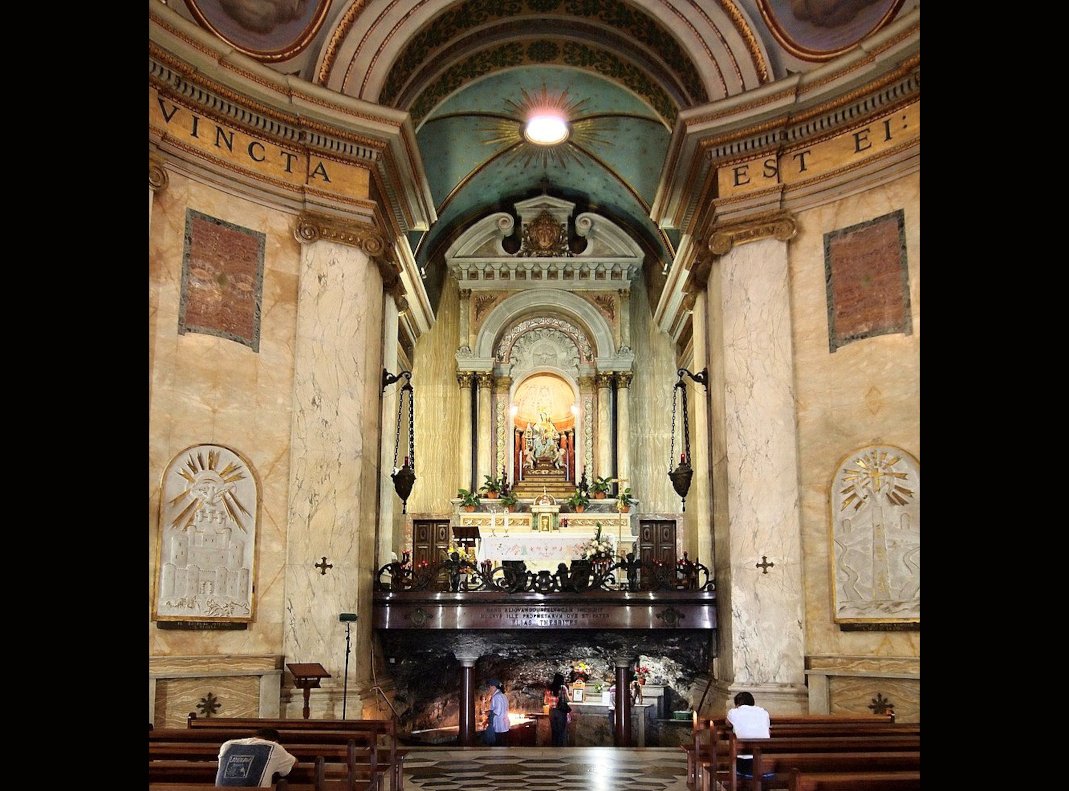
Stella Maris Church with Cave
Iliakriv, CC BY-SA 3.0
I wrote the following back in 2023 as part of a stolenhistory.net post regarding the possible presence of a demonic entity in the Middle East. As stated before, back then, all the information I found claimed that the Apollo-Athena Ley Line went to the Temple Mount in Jerusalem, not Mount Carmel. This will explain my conclusion at the end of this section, which is still valid nonetheless.
The information has never appeared on this website though, but now is its time. Jerusalem Syndrome is compared to the Paris Syndrome and the Florence Syndrome, although neither of these produce such severe 'symptoms'. (Given what we now know about Paris perhaps we shouldn’t be surprised at the connection.) Obviously modern psychiatry has to offer its own oh-so-clever explanation, but the standard cure is simply to get the afflicted person out of Israel. However, many never leave and are quietly dedicating their days to meditation in makeshift huts scattered across the mountains of the Judean Desert encircling the city. Many believe they are carrying and receiving messages directly from God. (Does this remind you of the original Carmelite friars who were also hermits dwelling in the mountains?)
The first recorded incident of the Jerusalem Syndrome comes from the First Crusade, so it has quite a pedigree. According to the biography of Margery Kempe, a fourteenth century Catholic Englishwoman...
“And so they went forth into the Holy Land till they might see Jerusalem, …She fell down that she might not stand nor kneel but wallowed and wrested with her body, spreading her arms abroad, and cried with a loud voice as though her heart should burst asunder. And this was the first cry that ever she cried in any contemplation. And this manner of crying endured many years after this time for aught that any man might do, and therefore suffered she much despite and much reproof."

It comes in various degrees of severity and can involve hallucinations or a loss of the individual's identity, whereby they believe they are a religious figure from scripture. There are over 100 cases per year of tourists being treated in a specially dedicated asylum in Jerusalem. The Kfar Shaul Mental Health Centre was established in 1951 "as Jerusalem's designated psychiatric hospital for tourists who display mental health disturbances, and is widely known for its research on Jerusalem Syndrome." Therefore, all statistical data is only relevant as from 1951 and any data from the fourteenth century until then is obviously missing from the statistics. Also there must be cases that never get as far as admission to the mental institution or manage to avoid it, so the often voiced idea that Muslims appear to be immune is most probably misleading.
J.E. Hanauer, a British traveller and Anglican vicar, wrote in around 1870: “It is an odd fact that many Americans who arrive at Jerusalem are either lunatics or lose their mind thereafter.” Visitors with no prior psychiatric conditions arrive in Jerusalem (or elsewhere in Israel) and have a psychotic episode, before recovering spontaneously and returning home to their usual lives. If they were travelling in a group or family, they usually attempt to slip away, develop an obsession with cleaning, and manufacture their own garments, usually from hotel bed-linen, of a long, ankle-length gown, which is always white. Shouting and singing religious texts is common, as well as visiting a holy site and delivering a sermon whilst there. Treatment is generally distancing the patient from Jerusalem, and returning them to their families. In its more extreme form it almost caused WWIII when an already mentally unstable Australian spent 3 months in Jerusalem carefully planning how to burn down the Dome of the Rock mosque and almost succeeding.

In the majority of the reports it's claimed that no cases of Jerusalem Syndrome have ever been recorded amongst the permanent populations of Jerusalem / Israel. However, there is an incredible amount of "cult" activity in Jerusalem involving all manner of abuse (sexual, psychological and physical), torture, murder, slavery, corruption etc. Some of these cults even have branches in the Americas, both north and south. Now the Chinese Falun Dafa cult (Falun Gong as it was when it was outlawed in China) are trying to get in on the act in Jerusalem. All the cult activity appears to be focused around the various flavours of ultra-Orthodox Judaism.
To my mind both the Jerusalem Syndrome and the concentration of Cult activity in the city are both symptoms of the same affliction, whatever that may be. Could this be connected to the Apollo-Athena Ley Line and also to the tradition of King Solomon and his alleged enslavement and imprisonment of demons in Jerusalem?
For some reason Solomon became an integral part of western occultism in the Middle Ages. In fact the most renowned of the ancient magical grimoires is attributed to him – the infamous Clavis Salomonis, the Key of Solomon. It's rather a dichotomy to realise that Solomon's 'occult wisdom' was supposedly given to him by God, presumably when he was allegedly building the first Temple in Jerusalem. Incidentally, his chief architect was Hiram Abiff, the alleged founder of Freemasonry.
The Apollo-Athena Ley Line runs from Jerusalem through Greece, Italy, France and connects to the Michael-Mary Ley Line, which runs right across southern England. (Some descriptions of a Linea Sacra or Sacred Line, cite Mount Carmel as the beginning of the 'Sacred Line of St. Michael', but that doesn't appear to have any connection to Ley Lines.) These combined Ley Lines are most prominent, or cover the most ground, in France and England. As stated previously, France was the most heavily represented country in the First Crusade and then later went to war with England for control of Jerusalem. Coincidence you may say, but there can be no doubt that the influence Jerusalem has had and is still having, over events in this world - from those of individuals right up to entire nations - is bordering on the supernatural.
At the time, (2023,) I speculated that Jerusalem’s location at the beginning (or end) of Ley Lines that connect the burial site of the head of Adam in Jerusalem with the burial site of the head of Bran the Blessed in London, were significant. (The claim that Adam’s head is buried under Temple Mount is a feature of Judaism.)
Strangely, management of the Temple Mount has been under the control of one form of Islamic administration or another, since the 14th century. Non-Muslim entry to the site has been forbidden during most of that period. That changed in 1839, but required a special permission. These days the Israeli government control access, while the Islamic administration controls the Al-Aqsa Mosque compound. Jews and Christians are generally prohibited from entering Temple Mount, and if they are allowed it’s strictly on the basis of tourism, as only Muslim prayer is permitted. Judaic law prohibits entry to the site for prayer or worship and the government also prevents access to Muslim males under the age of 55 whenever it fancies.
The Western Wall of Temple Mount, also known as the Wailing Wall, is the closest that Jews are allowed to get to the ‘Holy of Holies’ – which is the ‘Shekhinah’, or presence / dwelling of God. Nobody really knows where this was in relation to the Temple Mount, but then there’s no archaeological evidence to support any of it anyway. Curiously, The Crusaders, or The Franks, associated the Holy of Holies with the Well of Souls, a small cave that lies underneath the Foundation Stone in the Dome of the Rock.
Isn't it strange that, as we have seen, Wells were a highly important and significant feature of the 'Celtic' / Pagan belief system and seen as portals to The Otherworld. So, Christianity, and even Islam, has a Sacred Well right at the heart of its most important religious site, and to the Muslims it was a portal used by Mohammed to take a trip to heaven, as allegedly witnessed by his 'footprint' on the Foundation Stone.

The Well of Souls
Carl Haag, Public domain
It’s claimed that the spirits of the dead can be heard awaiting Judgement Day at this place. The Jewish Talmud and Islam, both claim that the stone represents the centre of the world and covers The Abyss beneath. The Muslim tradition states that the waters of Paradise flow beneath the Abyss, or Bottomless Pit, whilst the Jews believe the waters of The Flood are stored there… so it’s hardly bottomless then. There are various legends that have grown up around the Well of Souls and the Foundation Stone, many of which claim that the Stone actually talks. Of course, all of the chronology related to these sites is a nonsense due it all having been manipulated in order to push the dates further back in history to accommodate both the biblical time line and to give a much earlier date for the introduction of Islam.
Well, now in 2025, having assimilated all of the Biblical France material, the religious beliefs of the Australian Aboriginals, The Elucidation and all the other information given above, it’s time to reassess what I said in 2023.
We’ve seen that the Australian Aboriginals kept their Songlines alive through their continual use and by the songs they sang as they used them. They imprinted the Songlines with energy, in the form of information, that would then be disseminated throughout the Songline network. Each point along the way would not only indicate the route to the next one, but also contain information about the local area in terms of its inhabitants, landmarks, what food to eat, etc. After colonisation, these Songlines were used by the settlers who destroyed them to the point where they are now just dead tarmac highways. The Songlines still exist, but they are now singing a different song entirely.
For me this is the answer to the question of why the gospel stories were created in France and then exported to Palestine. This created the Christian Songline that then spread throughout the Ley Line networks of the world. In Paris, rituals were enacted at various key points and charged with the ‘Christian’ thought-forms. These travelled across the Ley Line networks and especially to Palestine. "This is the place of martyrdom. This is the place where the holy heart must rule, where it can cry out incessantly at the foot of the hill where Christianity was born, born among us in the blood of our first apostles.”
I know that the Flat Earth isn’t the usual Conjuring the Past fodder, but this time I’m going to make an exception. It’s been many years since Felix and I were involved in the FE movement and, since then, it’s been a subject we prefer to avoid. However, it’s highly relevant to this article...

Flat Earth Leyline Grid by Ashlee Webster
Source
You will notice from the above that the centre of the energy grid is the North Pole. Back in the DECs Part One, we focused on the Hyperborea region a great deal. For us, this was a highly important place that was associated with the Otherworld. Many many legends from many cultures identify this region as being a point of origin for humanity. It’s also a kind of ‘twilight zone’ between the physical and spiritual realms. This concept can be seen from the following depiction of Vedic Cosmology, where the central ‘pole’ is a conduit connecting all the realms of existence...
If we compare these images to the one above of Ley Lines projected onto a Flat Earth map, not only do we see the same ‘flower’ pattern, but also it becomes clear that energy flows to and from the central point. In other words, the central point is both the source and destination, of all our Ley Lines.

Now it becomes clear exactly why the Hyperborea region was the worst affected area of the 10th century cataclysm.
Coincidentally, just as the FE movement began with the controversy over the United Nations representation of a flat earth in their logo, so now we have exactly the same ‘in plain sight’ situation with Nasa’s International Earth Flag…
Before I start bringing all of this to a close, I’d like to backtrack a bit to the Elucidation and its description of the pre-Wasteland Logres…
“Afterwards no one could locate the court of the Rich Fisher, which had made the land resplendent with gold and silver, splendid furs, precious brocaded silks, fine foodstuffs and cloth, gerfalcons and merlins, goshawks, sparrowhawks, and falcons. In earlier days, when the court could be found, there was throughout the land such an abundance of riches, of all those I've named here, that everyone, rich or poor, was awestruck at the wealth. But now it has lost everything. In the kingdom of Logres were all the riches of the world.”
Earlier I understood this as being an allusion to the abundance of nature, with the Court of the Rich Fisher being the source of the power of nature. The thing is, it’s been playing on my mind ever since then. Gold and silver… OK they’re natural products, but can they be placed in, or removed from the land from one minute to the next – even by the power of nature? Precious brocaded silks… again they’re natural, but they have to be elaborated and brocaded by people don’t they? Fine foodstuffs and cloth would come under that same heading as well. Also, “all the riches of the world” sounds like overkill, or is it just me?
If we consider the above in conjunction with the business about Melusine building castles and cities overnight, and the super-fast constructions of the Rich Company, does it suggest that there’s some kind of conjuration going on, whereby these edifices, the gold and silver deposits, brocaded silks etc., can be materialised? I realise it sounds even more far-fetched than everything else I’ve said so far, however, what was it that Sherlock Holmes used to say? “When you have eliminated all which is impossible, then whatever remains, however improbable, must be the truth.”
Let’s reconsider the questions that were raised earlier...
Who was so highly organised as to have been able to build all these baptisteries on such a widespread scale and to have amassed a sufficiently large army to facilitate these mass enforced conversions? Were some more prepared to survive the cataclysm than others?
Now, let’s also consider some questions that Ms Hardy raises in her book, which are very closely related…
“Which secret group had both the knowledge and the immense means necessary to build at the same time (in the novel Gothic style) so many cathedrals during the twelfth and thirteenth centuries?”
These questions are remarkably similar. Ms Hardy qualifies hers by pointing out that, whilst the Templars had their own style when building churches and commanderies for their own use (see here,) how do we explain “the emergence of a totally novel architectural style, the Gothic, the exact same year as the creation of the order, that is, 1118?”
Chris L. Hardy identifies the “secret group” as The Knights Templar. She cites their introduction of “banking” as providing the financial means for their massive building programs and then, somewhat disappointingly, she talks about their involvement with the Temple of Solomon in Jerusalem and the discovery there of books by Hermes Trismegistus or Thoth. This brings up all manner of ‘ancient’ Greek philosophers and ‘Egyptians’, who simply weren’t ancient or Gypsies.
I myself (…I myself? Who else would I be? I someone else?) used to be quite fascinated by all of that Templar hype. Back in the 1980s, I read ‘The Holy Blood and The Holy Grail’ by Michael Baigent, Richard Leigh, and Henry Lincoln and I was hooked. Later, it lead me to ‘Foucalt’s Pendulum’ by Umberto Eco, which was a brilliantly researched mixture of history and fiction. This served to demonstrate just how easy it is to manipulate people’s beliefs and, along with revelations regarding the veracity of certain aspects within the ‘The Holy Blood and The Holy Grail’, I began to question the whole Templar hype. It's even included in that awful documentary series, 'Watching Paint Dry ', or 'The Secret of Oak Island '.
The books, films, papers and so on, that have been investigating, or revealing, or unmasking the Knights Templar over the centuries, must by now have reached an astronomical number and I certainly don’t want to get involved with any of that here. I agree that they were an intrinsic part of the “secret group” involved in the spread of the new ‘Christian Song’ across the earth grid and in particular, the export of the gospel stories from France to Palestine. I also believe they were not just the Knights Templar, but its founder members at least, were also Knights of The Rich Company.
Take the story of the First Temple’s construction in Jerusalem. Judea ...Israel, whatever it was supposed to have been called then. The Christian, or rather Jewish God at the time, provided Solomon with the knowledge he needed in order to enslave demons and use them to build his Temple. Whilst this is not a historical fact, it demonstrates that such a concept was once common.

The Kakanmath Temple
Source
The Kakanmath Temple in Madhya Pradesh, India, is an 11th-century shrine to Shiva. In this instance, another king decided he wanted to build a whopping great Temple. Lord Shiva appeared to the king in a dream and assured him that the temple would be completed in a single night. There was a taboo, or geas, involved though – no one must witness the construction. Wouldn’t you just know it, someone couldn’t resist sneaking a peek, whereupon the supernatural workers all vanished, leaving the Temple incomplete. These suddenly abandoned areas of the Temple’s decoration are still visible today.
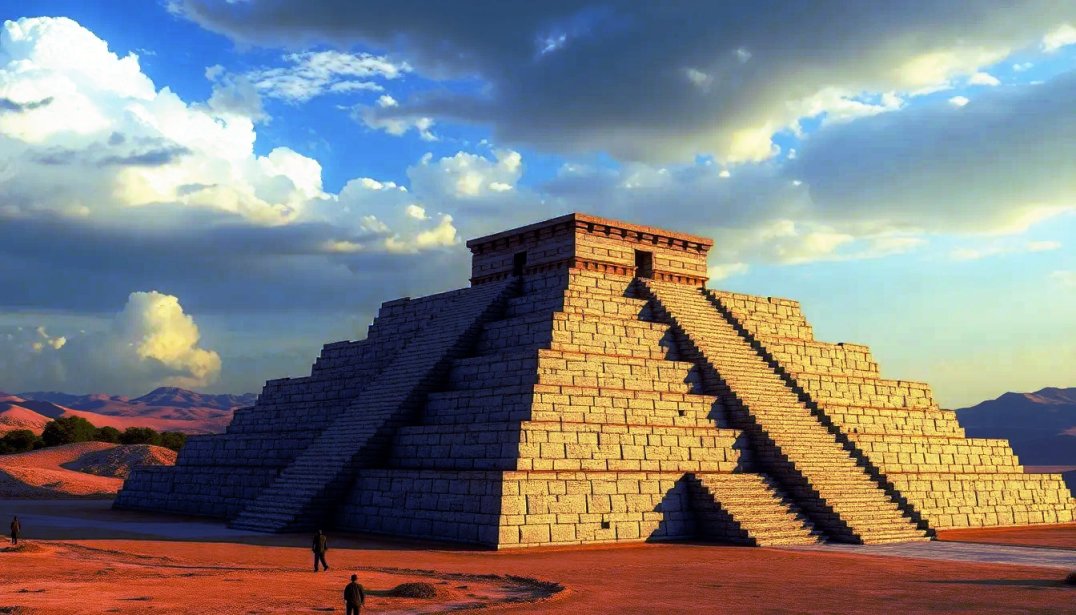
The Great Ziggurat of Ur
Source
The layout and structure of the Great Ziggurat of Ur, in Iraq… supposedly Mesopotamia at the time, was once again revealed to a king, King Ur-Nammu, by the God Nanna. He was the Moon God, who was believed to oversee fertility, vegetation and the rhythms of nature, which are all governed by the lunar cycle (it's unusual to find a male god in that role.) The Goddess Inanna played a crucial role in the construction, ensuring that the Ziggurat was built according to divine specifications and once again, by supernatural workers. By the way, Ur is claimed to be the birth place of Abraham and, urrr... doesn’t that Ziggurat look exactly like the step pyramids in South America?
I’m sure there are many more examples of supernatural constructions throughout the world. It seems to me that today mankind’s carefully cultivated arrogance much prefers to define these incidents as pure myth, although if it involves The Templars then all manner of off-the-wall speculation is perfectly fine and excellent for concealing the truth, of course.
One thing that has become crystal clear to me over the years, is that the truth concerning our real history is never going to be found through research, even if I had multiple lifetimes to dedicate to the project. I have come to accept that there are many things we are never going to ‘know’ because they have been lost. Not only lost, but totally destroyed through redefinition, relativism, demonisation and deliberate obliteration. The most anyone can hope to achieve is their ‘best guess’. Well, what follows will be my ‘best guess’ based upon everything that has appeared on this website and my own interpretation of how it all comes together. If nothing else, it might make the basis for a kind of fantasy world such as those created by Terry Pratchett, C. S. Lewis, or even dare I say it, J.J.R. Tolkien. In fact, I may do exactly that in the future – it’s something I enjoy much more than eternal bloody research.
Establishing exactly what life was like before the 10th century cataclysm is, as I have said before, is never going to be something we can ‘know’. It’s much easier to take the official narrative’s ...narrative, and simply accept it. It’s not as if they ‘know’ any more than anyone else, it’s just that your life will be so much easier and you will never be branded a ‘fool’ or a ‘retard’. Ignorance is bliss, or so they say, but then if you’re like me, ignorance is not an option.
Wading around in mythology, legends and folklore conjures up an idea, or an inkling of the reality. Isn’t it interesting that the society formed by the authors J.R.R. Tolkien, C.S. Lewis and Charles Williams in the early 1930s, was called The Inklings – now I realise why. The danger though, is that one loses the awareness that everything has been through the filters of Christianity, [insert any other religion here,] and, in the case of Arthurian literature, the Norman/Angevin/Plantagenet dynasty, not to mention a myriad of writers since then.
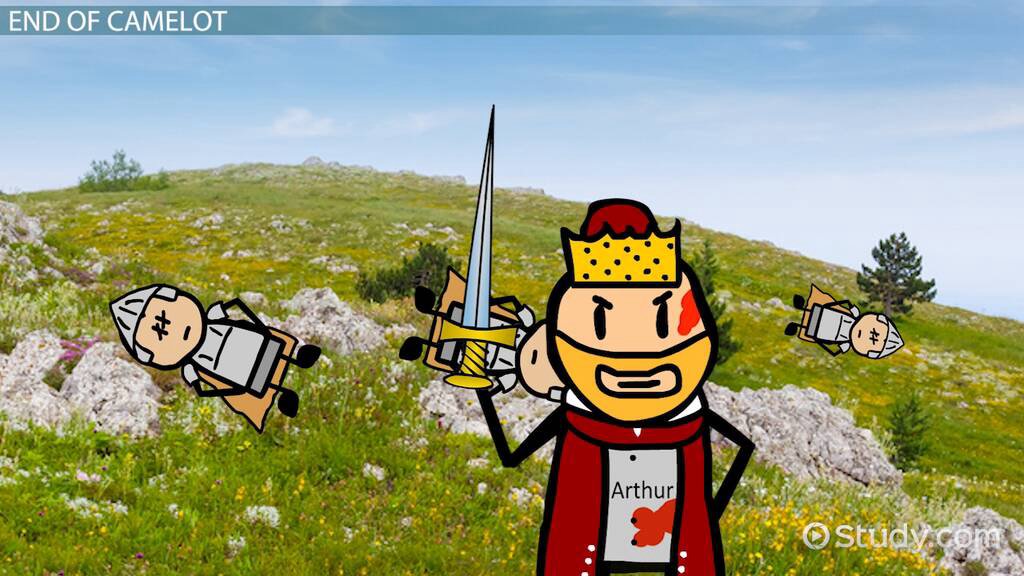
The Arthurian Legend for Kids
Source
Both Felix and I have been big fans of King Arthur ever since childhood. However, all of my research has completely destroyed that particular Ivory Tower. Whether ‘Arthur’ was a title or not, is not possible to say. I’m inclined to believe it was, but I don’t have very much to base that belief upon. Regardless, it seems that the only, (or the last) Arthur was around just prior to the cataclysm and that he was the Emperor of a vast kingdom that stretched far beyond Britain. Whether he was semi-mortal or not we cannot know for sure. However, his wife and his original 6 knights were all part Faë. His father, Uther, was a King of the Otherworld, although this doesn’t necessarily make him Faë, as this honour could also be given to mortals. Guinevere was an Ælfgifu who represented the Goddess, whom Arthur was sworn to respect and protect, just as he was sworn to respect and protect the land and its occupants.

We learn from The Elucidation that, since approximately 1000 years before the cataclysm and Arthur’s rule, there was an identifiable ‘fly-in-the-ointment’ around, named Amangons – a Faë sorcerer and general ‘bad egg’. The same figure appears throughout Celtic mythology under similar, but different names. I have also identified Taliesin as another fly in that same ointment, who was definitely the servant of an entirely different master, one much more akin to Amangons than the Christian God he was constantly praising in his poems. It’s also obvious that he was inimical to Paganism. Furthermore, after the cataclysm, Arthur was, and still is, hailed as the champion of Christianity. Was this a redefinition or was there more too it? What greater betrayal of the land and The Goddess could there be than Arthur’s conversion to Christianity, and did Taliesin, or Merlin, or even The Rich Company play any part in this?
Merlin is a difficult character to separate from all of the fiction, however, his birth was equally as perverse as Taliesin’s. Nimue, The Lady of the Lake, or rather the Goddess herself, had to intervene long after Merlin had become advisor to Arthur, and banish him to a place where he could do no more harm.
The Elucidation again demonstrates the link between the monarch, his land and the Goddess – with her dominion over the benevolent forces of nature. Following a breach of this accord through Amangons’ abuse of the Maidens of the Wells, his kingdom of Logres was turned into a Wasteland. I have identified this with the region of Lognes, located just outside of Paris, in France. This act created a hybrid race of Faë and semi-Faë beings who were a cross between the beneficent Maidens of the Wells and King Amangons’ “men,” who had followed his example in abusing the Maidens.
We are told that a group of these hybrids wandered the land searching for the means to end their isolation. In the meantime, there was an even larger group of them who were outside of the physical realm. It’s my contention that Logres, or Lognes, continued to exist just outside of our physical reality, along with all of its inhabitants, buildings, infrastructure and, of course, Amangons and the new hybrid race. Mind you, as I have said before, perhaps there is nothing unusual about being a Faë in a human body as that's what we all are anyway.

By the time we get to Arthur’s reign and his discovery of the situation in Lognes, he had already become lazy, egotistical and lost much of his honour, along with the respect of his people. Who knows how much of this was due to the influence of Taliesin/Merlin. When Arthur and his knights became aware of the situation in Lognes, they wanted to take action. Arthur stayed at home, but his knights made the journey and sent him many captured knights from the wandering 'hybrid' group. I suspect that this wandering group were not all they seemed, but were specifically and recently sent to persuade Arthur and his Knights to achieve what they could not – namely the lifting of the curse on Lognes and its restoration to the physical realm.
Thanks to one of their ilk, Master Blihis (Cadivor at that time,) who enchanted the entirety of Arthur’s court with his storytelling, this is exactly what happened. Blihis inspired the Knights of the Round Table to undertake the Quests necessary to repair the rift between Lognes and the Goddess. At the same moment the curse was lifted and Lognes was once more verdant, tangible and visible, a mighty army – The Rich Company – appeared. Buildings, castles, bridges, forts, and towns also appeared and The Rich Company, along with Amangons and his minions, set themselves up in opposition to Arthur and his Knights. There then followed four years of war, whereby Arthur was opposed not only by The Rich Company in Lognes, but also his own people back in Britain. During those four years, many nobles went over to join the Rich Company.
Eventually, Arthur and his knights beat the people of Britain into submission, albeit in an almost tyrannical way. The Rich Company were also ‘defeated’, although all it involved was an agreement not to be naughty boys any more and to support Arthur. Apart from that they carried on as normal.
The Rich Company then spread across France and particularly into Normandy. There were even some in Dyfed, Wales, such as Blihis (Cadivor) in particular and others, who had been captured and sent to Arthur in Britain. Meanwhile, Amangons, his minions and The Rich Company had been far from idle during the isolation of Lognes in The Otherworld. Like most gods, Amangons thought that everything was his to do with as he pleased, just as he had done with the Maidens of the Wells. Now that he was back, he could set his plan in motion.
He had devised the perfect plan that would separate humanity from nature and the benevolent forces that guided it. This would enslave mankind to him forever. During those 1000 years he had concocted the perfect ideology, based upon his own ‘original sin’ with the Maidens, which he transferred to the whole of mankind. He invented, or copied, the figure of a saviour who would redeem mankind – just as Arthur had redeemed Lognes from its isolation, both being 'cons' of course. Amangons intended it all to coincide with the time of his “original sin” and be set 1000 years ago in a far off land, amongst fictitious people who were already persecuted by a fictitious corrupt system. It also had to be in a place connected to France across the Earth’s Ley network so that it could be constantly reinforced and transmitted across the world. He even had it all written out by his minions in four different versions, and in different languages. They used Lognes and other places in France, as its backdrop with Paris as the focal point. They had no idea about the geography of the Middle East, but that didn’t matter.

Amangons had another collection of stories prepared that were loosely based upon accounts of his own history from when he and his minions battled for recognition and power in The Otherworld. He modified them to support his new ideology, with various prophecies and a creation story that clearly marked humanity as the perpetrators of original sin. This in turn caused them to be banished from an earthly paradise – in fact all very similar to the fate of Lognes after Amangons’ original sin, so this was clearly his revenge. Of course, all of humanity then had to be descended from the original sinners, so a lineage was put in place and a chronology to go with it. Priests and clergy were also all in place and well rehearsed in the dogma.
Taliesin, and/or Merlin, had a vital task to perform in order that Amangons’ plan could work. Everything hinged upon it. By massaging Arthur’s pride, Taliesin convinced him that the Head of Bran the Blessed, buried on Tower Hill in London, was badly affecting his own reputation as defender of the kingdom. People would give credit to Bran rather than to Arthur. This resulted in the removal of Bran’s Head by Arthur, who made it known that the Empire needed no other power than that of himself and his knights for its defence. The removal of Bran’s Head from the Earth’s Sacred network also removed Bran’s ‘Song’, which would prove to be devastating.

The next step was to convert Arthur to the new religion. Amangons’ priests began by concentrating on the nobles who had supported The Rich Company. Gradually Arthur saw more and more of his own allies taking up the new faith. Many sacred Pagan sites, those within the regions of the converted nobles, were also desecrated and redefined as Christian churches, and so the ‘New Song’ began to spread like a poison across the Earth’s Sacred network.
We will never know how long it took before Arthur was turned. The 10th century cataclysm occurred on the day that Arthur was baptised, betraying the Goddess, her pantheon of nature devas, his wife, his knights and his entire empire… the whole world in fact.
Arthur was lured back to Lognes for his conversion, on the basis that it was the only sufficiently sacred place for such an important and mighty emperor. He was escorted to a crypt beneath the Temple of Saint Denis, (now Saint Pierre de Montmartre.) Amangons and his minions presided over the ceremony, under the guise of priests. There, upon the hill of the martyr, Arthur was baptised and marked with the sign of the crucifix.
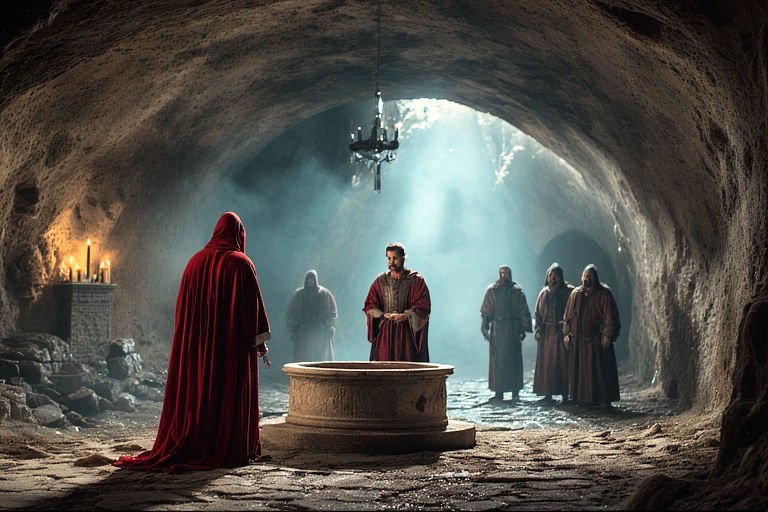
Of course, Arthur had to be sacrificed so that the new religion could flourish. He managed to react sufficiently to have drawn his sword, Excaliber, as the mnions came forward to kill him. In the short scuffle that followed, Arthur swung Excaliber with all his might and severed the head of Amangons, just before he was struck down himself forever. There were no queens waiting in a boat to take him to Avalon from where he would one day return in Britain's hour of greatest need. However, as with other 'Wounded Kings', Arthur's spirit will never heal from the wound that killed him until his death is avenged. So, in a sense he is in Avalon even now, having his wounds tended and those wounds include his shattered pride and immense guilt.

And that episode is why, to this day the legend of the severed head of Saint Denis is still connected with that very place and states that he picked up his head and walked several miles while preaching a sermon, because, just like Bran, Amangons’ head continued talking. It’s also why the same place was declared as being the “the place of martyrdom... where the holy heart must rule, where it can cry out incessantly at the foot of the hill where Christianity was born, born among us in the blood of our first apostles.” Arthur was that martyr who had not only redeemed Amangons and The Rich Company from their 1000 year isolation, but had now also provided the sacrifice that would allow Amangons to rule the world and everything in it.
This time not only were vast areas turned to Wasteland, but the region of Hyperborea was completely shut down in order to protect The Otherworld from the poison that was the ‘New Song’ on the Earth’s grid. The elite of The Rich Company knew that the cataclysm would be the inevitable result of Arthur’s baptism and murder, so they were prepared to sit it out until it was possible to move around again, but they were not idle during that period, and they used the time to adjust their plans following the unexpected loss of Amangons’ head, which continued to guide them. An alternative history and a new chronology were prepared in order to support the export of the new religion’s dramatic conception to the Middle East. It was during this period that the bare bones of what we now know as first millennium history were established and then later ‘fleshed out’ by mirroring current events and sending them back in time. Amangons’ minions – his ‘Chosen People’ – were a separate Faë race who had accompanied him from The Otherworld Lognes into the ‘real’ world and who now began to interbreed with humans.
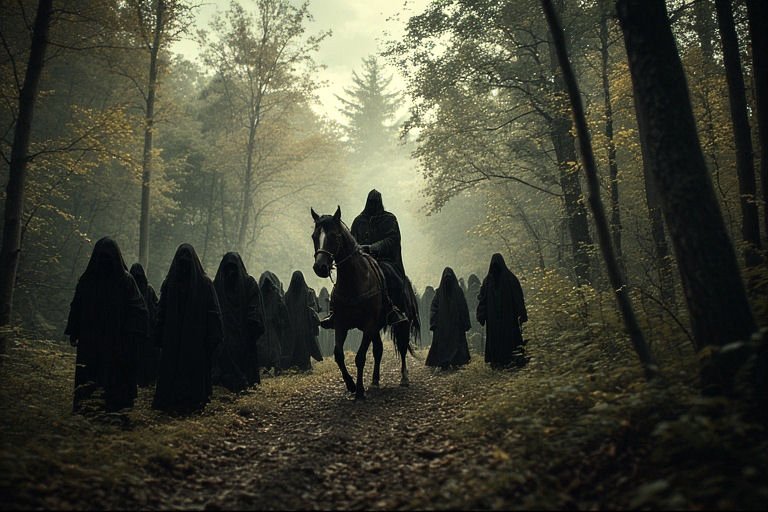
Amongst their other notable characteristics, they were highly acquisitive and skilful merchants, although they lacked the power of materialisation.
The Rich Company didn’t have to face the same hardships as everyone else. In Amangons’ time as ruler, “In the kingdom of Logres were all the riches of the world.” This power of materialisation was inherited by the offspring from Amangons’ rape of The Maiden of the Wellls – The Rich Company. Furthermore, baptisteries, churches and even cathedrals, could be constructed ‘overnight’. Once it became possible to travel around again, the priests of the new religion wasted no time in converting the long-suffering populations in their freshly conjured baptisteries and churches. They were very easy to convince following the trauma of the cataclysm, which was presented by the priests as a punishment from God for their sins, blah-blah-blah etc. etc.
The Norse leaders also wasted no time in trying to fill the vacuum created by Arthur’s demise in the now shattered Empire and they set their sights on Britain ...or what remained of it. It’s interesting to note that there were never any Crusaders from Scandinavia. Probably it was too cold there for The Rich Company who also, in the form of The Normans, had their own designs on Britain.
Even before they got around to England, the Normans had already conquered southern Italy (‘even unto Rome’,) including Sicily, and had a presence in Barcelona, in northern Spain. This allowed them to reinforce the ‘New Song’ on the Earth’s Grid through desecrating more ancient sacred sites and redefining them as Christian, and also through more baptisms. This gave them as much time as they needed to put all the props of the gospel stories in place, such as the relics and remains.

Martianman64, CC BY-SA 4.0
These conquests were assisted by any ‘family’ members who were already installed in these places, whom they used to the maximum advantage. Therefore, in 1066, William the Bastard walked into England and took control, although later, history would record this as a lavish and masterful invasion involving a cast of thousands with soldiers, ships, horses, Uncle Tom Cobley and all ...or maybe that should be Oncle Tomás Coblé et tout. England then fell victim to the poison of not only the new religion, but also the Feudal System, whereby everything and everyone belonged to the king and his nobles – The Rich Company.
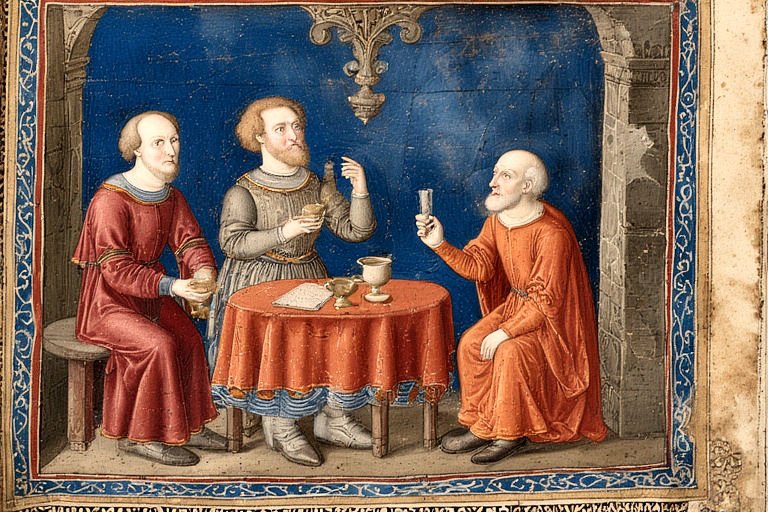
In 1080, William the Bastard paid a visit to Dyfed in Wales where he met with Cadivor – the ancestor of all the local Rich Company. He was actually the very Master Blihis who conned Arthur and his knights into removing the curse over Lognes and setting Amangons, his minions and The Rich Company loose in the world. His son, Bledri ap Cadivor, was already a renowned storyteller who related all of his father’s exploits and more. Not only did William the Bastard make plans with Cadivor and Bledri to invade Wales with their assistance, but he also introduced Bledri to those who would eventually turn his tales into legends.
In the meantime, Amangons’ head had been directing affairs back on the continent. Popes appeared along with a history stretching back decades. More churches were ‘built’ along with Abbeys, Monasteries and all manner of religious constructions. These popes made various decrees and commands as required by Amangons’ head, in order to keep the Rich Company in line, as they were becoming more and more competitive which led to in-fighting. Another such decree in 1095, called for an ‘armed pilgrimage’ to Palestine. This is what we now know as the First Crusade, although it had nothing to do with liberating the Holy Land from Islamic rule, (Islam didn’t exist then,) but everything to do with assessing the situation there and establish a foothold from which to create the Christian Holy Land.

By around 1115, all was set for the next phase of Amangons’ plan. His head was to be taken to Palestine and buried at a very specific place – beneath what is now commonly known as Temple Mount in Jerusalem, beneath the Foundation Stone, in the Well of Souls.
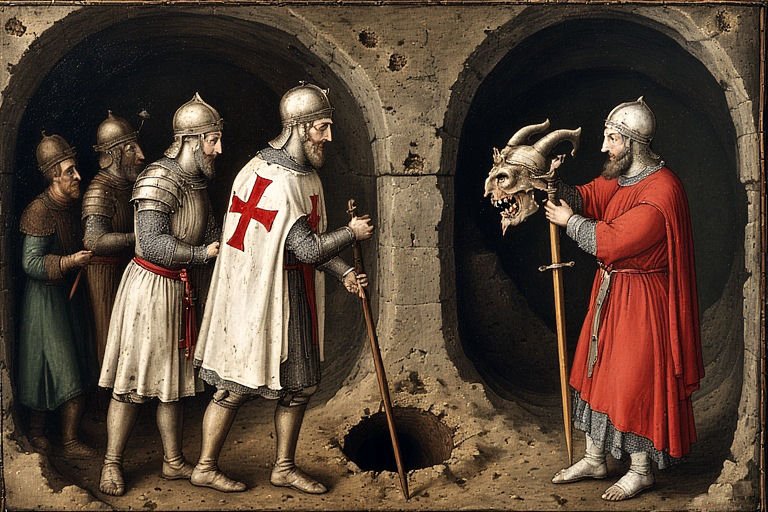
This was to be achieved by a select group of knights from within The Rich Company who became known as The Knights Templar. Originally there were 9 of them, all sorcerers capable of materialisation. They were accompanied by a group of Amangons’ minions who were to settle there and assist in the creation of the Holy Land and later, Islam. Also, it was from this point onward that hermits began to gather in the caves around the site of the future Stella Maris (Star of the Sea) Monastery, on Mount Carmel.
It should be noted that not all of The Rich Company were master sorcerers. Obviously, within The Rich Company as a whole, there were varying degrees of megalomania, psychopathy and all the other negative aspects that characterised Amangons, plus of course, his supernatural abilities. The same was also true of the positive characteristics intrinsic to The Maidens of the Wells. Those who had received an overwhelming infusion of Amangons’ character and abilities, became his most trusted servants. At the other extreme, those who favoured The Maidens of the Wells in character were at least marginalised, or at worst outcast ...some were ‘disappeared’. ‘Throwbacks’ of both persuasion continue to appear right up to today... I think we are quite familiar with many of them.
Despite the cataclysm and the breaking of the Fairy Accord, there were places where the elemental guardians had such a strong connection to a sacred site that they were still present. Often, a petty lord of The Rich Company would come across such a site within his new feudally acquired lands, particularly those associated with water. If he encountered its guardian, in the form of a beautiful Faë woman, he couldn’t resist taking possession of her in just the same way as his primary progenitor had done all those centuries previously. This gave rise to the phenomena of ‘The Melusines’ that began being reported all over Europe. Possession of such a prize allowed those of The Rich Company who had not inherited the power of materialisation, to make use of it through coercion of ‘The Melusine’.
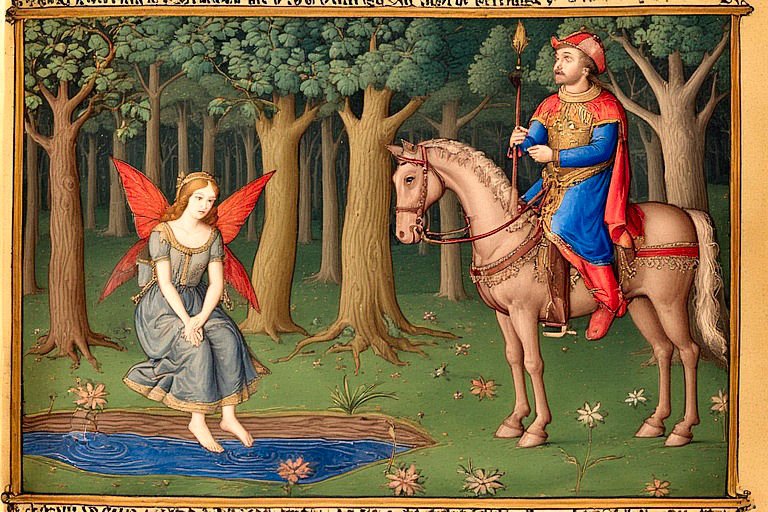
In Europe, The Rich Company, or Normans, continued their expansion of Feudalism and the new religion, outwards from Normandy and England until it eventually bore a remarkable similarity to the fictitious Roman Empire. Thus all of their campaigns were literally, or rather literature-ally, duplicated and then sent back in time to flesh-out the bare bones ‘history’ created by Amangons & Co. for the purpose of supporting the gospel stories.
I don’t intend to continue this tale right up until today, because the rest, as they say, is ‘history’, however, it’s not the history we have been force-fed, rather it’s the history of The Rich Company, Amangons (or rather his head) and his minions. It’s no surprise to see that much of what has occurred since all of the above, has been the result of infighting, jealousies, rivalries, revenge, alliances/betrayals, and just pure greed amongst the individuals and various groups within The Rich Company and its allies.
If we revisit the questions that were raised earlier regarding:
It’s clear that The Rich Company, in all its guises, fits the bill as much as it did back then and still does today. One notable, and highly significant example of this, is the demise of the Knights Templar. If we accept that they were originally comprised of the elite from The Rich Company and possessed exactly the kind of “secret knowledge” that they have always been credited with, then it’s not difficult to realise the kind of wealth and power they accumulated… or simply manifested.
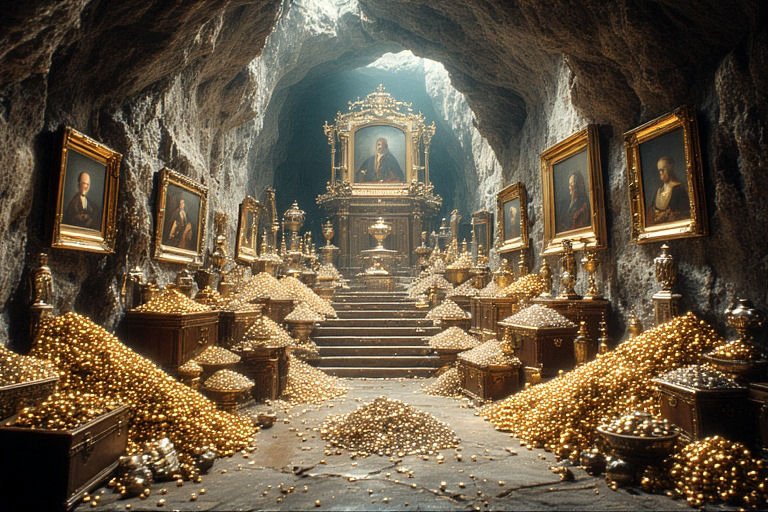
It seems to be a fact of life that any kind of organisation will eventually tend towards ripping itself apart, or being ripped apart by another one. In this instance the Church grew increasingly powerful, increasingly ‘top-heavy’ and, more importantly, convinced of its own dogma as being ‘The Truth’. Obviously, the same process took place within the Templars and in both instances the ‘real’ truth had to remain hidden and could only be passed on through circumstances of absolute trust – no doubt through the same kind of ritual involved in modern Freemasonry. Outside of these two powerful organisations, there was a third – the Monarchy.
By the 14th century Philip the Fair was the ruling monarch of France. He was of the Capetian, dynasty, which by then seemed to be a curious combination of values inherited from The Maidens of the Wells with Amangons’ megalomania, all mixed with ultra pious Christianity. Their ability to heal scrofula was, of course, attributed to their faith in the Christian God, rather than an inheritance from the Maidens of the Wells. To complicate matters, Philip the Fair‘s closest advisers were either Rich Company or Amangons’ minions (or both,) who took advantage of his extreme piety and steered him in directions that were to their own advantage rather than his. This, in combination with massive inherited debts, led Philip into all sorts of disputes and difficulties that only served to make matters worse. The Templars, at this time, were in the vulnerable position of having no Crusade to occupy them and no Temple to be a knight of, which provoked questions regarding the justification of their existence.
Philip’s advisers took the opportunity to steer Philip towards an alliance with the Church against the Templars, thereby solving his financial problems through the confiscation of all their extensive lands and property, both in France and abroad. There was obviously more to this than meets the eye. The advisers must have had their own reasons for wishing the destruction of the Knights Templar. Perhaps it was because, as they grew, they were a highly potential risk in terms of the truth being revealed. As we know, whatever those reasons were, the destruction and dispersal of the order was a success, although it took a very long time and kept the Inquisition busy for years.
One of the charges made against the Templars was,
“...that the Templars adored idols, specific mention being made of a cat and a head, the latter sometimes having three faces. This head was worshipped as a saviour and venerated as a giver of plenty which could make the trees flower and the land germinate. They touched or encircled it with small cords which they wore around their waists…” (Source: 'The Trial of the Templars’, by Malcolm Barber, 2006)
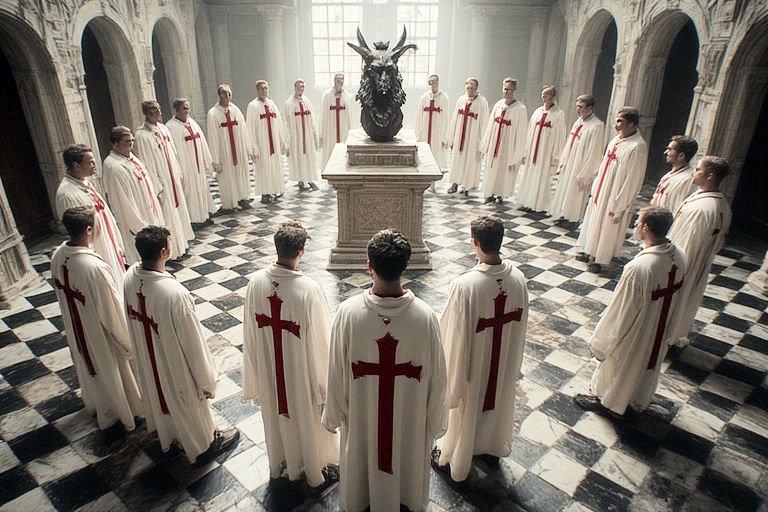
“Other Templars questioned after John of la Cassagne had seen, variously, an idol like a bearded head which was the figure of Baphomet, a figure called Yalla (a Saracen word), a black and white idol, and a wooden idol.” (ibid.)
Furthermore…
“...when a new Templar was received, he denied Christ and sometimes the Holy Virgin and the saints, an act instigated by those receiving him. He was told that Christ was not the true God, that he was a false prophet who had not been crucified for the redemption of the human race, but on account of his sins.”
Well… for centuries opinions over all of that have been divided between them being innocent of those charges, but coerced into confessing through torture and threats, or that they were guilty and therefore ‘Satanists’. The thing is though, within my ‘Inkling’ scenario, the charges are basically absolutely true. They did worship the head of Amangons. They also knew the truth about the gospel stories and the crucifixion.
Even before their complete demise, they took action to ensure the knowledge they possessed regarding sacred geometry, the use and manipulation of telluric energy and Ley Lines, materialisation, Amangons, etc. etc., would live on after them. Generally the persecutions were not all as severe as those in France and in some areas the Templars were simply absorbed into other orders. I know there’s a large consensus of opinion which claims that Freemasonry took over from the Templars, but personally I’m not convinced they were actually the same organisation – slightly similar maybe. In the UK, Modern Freemasonry, took over in 1717 and pretty much obliterated the ‘Antient’ Freemasonry that came before. On the continent Freemasonry didn’t officially emerge until 1725, leading to the establishment of the Grand Orient de France. From the very beginning, it was clearly far more interested in liberal revolutionary ‘enlightenment’ than sacred geometry and played a crucial role in provoking the French Revolution.
One would imagine that the “secret knowledge” was no longer a feature in initiation rituals within the subsequent orders, lodges and secret societies, in view of the Templar experience. This probably accounts for all the different levels of initiation – such as the 33 within Freemasonry. However, it was inevitable that the original “secret knowledge” would become diluted, manipulated, twisted and fragmented. In the 19th century, the pentacle, which was one of the Templar’s most frequently used symbols, began to attract negative associations and by the following century even the self-confessed Satanists were using it in conjunction with representations of Baphomet.
For a few centuries, the three powerful organisations of The Knights Templar, The Church and The Monarchy, reigned supreme. However, as we have seen, this whole structure harboured its own demise within itself, which eventually shifted the balance of power. Avarice, greed and self-interest – qualities inherited from Amangons – sabotaged the status quo he had achieved by that time. From then on, new organisations arose and began competing for power, influence and wealth. Amangon’s minions, or Chosen Ones, were transformed into an ethnic group with a history that was adopted straight from the Old Testament and a religion to match. Islam manifested in Mecca, which is connected through the Earth’s Sacred network directly to Amangons' head. The new religion of Christianity was deliberately divided against itself, feeding the Earth’s Sacred network with more hatred, death and fear for centuries to come. The Rich Company ‘multiplied’ and their particular cocktail of inherited traits spread throughout the general populace. This led to the rise of Politics and Governments, two more institutions harbouring destruction within themselves, but in this case, not their own – ours. Amangons’ plan is still ‘on track’.
And, is it still being used against us today? As I sit here writing this during a heatwave that’s being promoted with the familiar ‘Climate Change’ facade as being the longest in “the history of the world” ...well, “this century” ...”this decade” ...OK then, “this summer,” much of Spain is burning around me. I can’t help but wonder if I’m living in a Wasteland. I’m sure all of those who have lost their homes and their livelihoods in the ongoing purge of the land by fire and who have been left to cope on their own, with no help from anywhere (just like the victims of the Dana in Valencia,) are already convinced that Spain is a Wasteland.
Pretty soon, in the name of ‘Climate Change’, 90% of Spain will be a Solar Farm. There will be no agriculture or farming left, save maybe insect cultivation. The “campo,” or countryside, will be inaccessible to normal human beings, wildlife and especially trees. We are living under a new more intense version of the Feudal System that before long will own everything and everyone.

The Wasteland
Source
Just prior to the incinerations, a ‘pre-emergency’ declaration was made whereby all responsibility for the provision of emergency aid would be placed on the the local authorities – NOT the government. Furthermore, everyone in the affected areas were ordered to stay in their homes under another illegal ‘Lockdown’. As it turned out, all those who were promised evacuation never got it. Those who were forced to abandon their villages had nothing left to go back to. Those who decided to stay and fight the fires got no help whatsoever. There were / are even road blocks set up to prevent anyone trying to move their animals and livestock to safety. So far 4,070 square kilometres have been lost to the arsonists, which is the equivalent of the entire county of Suffolk in the UK and many more will follow in areas that are still burning. Yes, arsonists, these fires were all set deliberately and had nothing whatsoever to do with Climate Change. Many of the affected areas had already been officially ear-marked for solar farms even before the fires were out. This is more mass destruction and murder.
Just as the health and well-being of the land and its people, is linked to the health and well-being of its ruler, then, if the ruler destroys the land and turns it to waste, so will the ruler suffer the same fate. And this is happening before our very eyes. Never has Spain had a ruler, or a government, that’s been as murderously destructive, and as hated, as the current regime.
“For it is the prince's falsehood that brings contrary weather upon wicked peoples and dries up the fruits of the earth.” Spaan, ‘The Otherworld in Early Irish Literature’.
So, it’s not all just silver iodide generators seeding the clouds and HAARP frying the land. Speaking of which, check out this website, which shows all the different methods currently being used for weather modification – it really isn’t just silver iodide.
In the Arthurian legends, it’s always a wound or disablement of the chosen King that has caused the Wasteland. In a way that’s still true, except the obviously mental malady of Spain’s current unchosen ruler has clearly been a contributing factor combined with whatever hidden power has ordered him to turn the country into a Wasteland and now the balance must be restored. No amount of doctors and make-up artists can disguise that process. This is one of the results of spending the last 7 years turning your country into a Wasteland...

2018-2025
This is happening in many places. Knowledge of ‘The Grail’ as a weapon has brought us to this situation, it has not happened by accident or chance. We should also note that the coronation of monarchs, who swear oaths upon sacred Pagan objects at sacred Pagan sites, still happens today. In England, Westminster Abbey was once an important Pagan site known as Thorney Island, located in the Thames beside the River Tyburn tributary. We can see how, over time, the monarchs lost their direct power and became mere ‘figureheads’, much like the cosseted kings of Shilluk, Elele and the Khazars as depicted in the ‘The Grail, The Cataclysm,The Wasteland & Our Lost Ancient Sovereignty’ article. This was obviously a way of attempting to divert the retribution that would be triggered by The Grail process when harm or damage was inflicted upon the land, or its people, by whoever wielded the real power over the kingdom. These days the ‘Wounded Kings’ could just as easily be a Trump or a Sanchez as a King Charles. Who knows if this ruse was effective or not, but the fact that it’s still in place today must be indicative of its usefulness – let’s just hope it’s not 100% effective and those pulling the strings of the ‘Wounded Kings’ behind the scenes are also suffering the consequences, like Sanchez.
In the meantime, the individual sovereignty of our countries is being eroded through the manipulated avalanche of foreign immigrants, or so-called ‘asylum seekers’, who arrive with nothing, but are given everything that your tax money can buy. Of course, they never find themselves in an asylum, usually a nice rent-free house. This doesn’t just affect sovereignty, but also national identity – to the point where it will be completely lost in yet another disconnection from your true nature. The chaos and violent confrontations that are inevitable in such situations, will lead to further isolation.
Everything I have been talking about has been in relation to what I have called ‘Arthur’s Lost Kingdom’, namely The British Isles, Scandinavia, mainland Europe (as far east as Lapland), Iceland, Greenland and ‘many other islands under the North pole.’ In other areas, clearly something must have happened, as many other civilisations of the wider world vanished after the 10th century cataclysm. However, I can’t say what that was because I just don’t know. What I have said is speculation based upon research, investigation, reason and more than a little intuition. In other words, I don’t ‘know’, but then neither does anyone else. This is all my version of not 'knowing', but having a well informed 'inkling'.
So, are we all descendants of Amangons? Do we all comprise elements from him and from the Maidens of the Wells by now? Is this why for centuries, we have been told that we all possess ‘animal instincts’ that we must overcome with our ‘higher selves’? There’s been more than a thousand years during which time it would have taken just one of your relatives to have been from The Rich Company. However, I’m sure there’s no identifiable genetic trait, as it’s more of an etheric inheritance than a physical one, a bit like ‘Racial Memory’ and the modern concept of ‘Constellations’. During those 1000 years since the arrival of The Rich Company, many of the heretical Christian sects gained an inkling of what was really going on. The Cathars, the Gnostics and whoever it was that warned us via the Nag Hammadi library about the Archons. They all saw through the facade and sadly, they were all wiped out because of it. Then there was Abbot Bérenger Saunière and the famous Rennes-le-Château affair, made famous, or infamous, by Dan Brown. Once again, there was clearly something going on there, but it was hijacked by the Merovingian bloodline intervention of later authors, then by the time Dan Brown got hold of it all, well… say no more. However, that the basic theme was so popular is an indication that it appeals to us on a deeper level, like an ancient itch we had forgotten how to scratch.

Asmodeus (Amangons?) in the
Rennes-le-Château Church Source
It’s my honest and considered opinion that we are still firmly under the influence of Amangons, his minions and the heritage of The Rich Company. The plan, or the Revenge, has always been about causing as much suffering as possible, both physical and mental. I don’t need to give any examples of how effective that has been over the decades. Now, it’s doing its best to reach a crescendo before the tide turns once again upon its slow, but deliberate journey into the next cycle.
I truly believe that the further one is removed from nature, physically and emotionally, the greater is the loss of contact with the finer, spiritual side of human nature – which is in fact your non-human nature from The Maidens of the Wells and beyond. The more one is absorbed by the modern virtual reality – the social media networks that define the life you’re living inside a mobile phone – the greater your isolation from true reality and the more you will manifest the dark, inhuman nature of Amangons.
"The terror of history lies in the great destruction it has wrought on our planet and our people and in the perversion of our natural religious sensitivities to place and the source of Life. We are left with the dull mentality of the competitive, acquisitive , contractual being whose essence is determined by the outcome of situations. Thought is consumed in the fearful expectancies of coming events, daily tedium, and sentimental recall of the past. As historical beings, we stand condemned by our history and are helpless in the face of it... History cannot teach us how to be human, but it conditions us to accept and enact inhumanity." (Source: John Lamb Lash, 'Not in His Image'.)
Our most powerful organisations have been totally infected by Amangons’ inhumanity and that perverse quality that comes from being isolated from the natural world for so long. The modern ‘virtual reality’ can never satisfy our heart’s natural desire for fulfilment, instead we keep searching for the next experience, the next thrill, the next ‘buzz’ - which is always ultimately a disappointment – and then the next, and so on. It’s during that journey we loose all of our natural morality, compassion, our sense of right and wrong – in short, our humanity. This is why institutions like the UN, the EU, the WEF and the WHO, are busy promoting perverse WTF agendas rather than doing anything useful, because they know that there are now enough corrupted souls around who will jump at the next new experience, rather than jumping and shaking these institutions, and those who fund them, firmly by their throats.
This is exactly why we must all be herded into and caged up in ‘15 minute cities’ by 2030. Why we are being denied contact with animals, either as pets or for farming, because they reconnect us with our true nature. It’s why, in Spain at least, vets are no longer permitted to euthanase sick animals and so their owners are forced to watch them suffer until they die. It’s also why the countryside is being turned into a Wasteland of solar panels and insect farms, as it will once and for all annihilate any remaining sacred sites along with any surviving associated guardians. The countryside will become a ‘no-man’s-land’ with no trees and thus no rain. The flora and fauna will die. Unlike the Logres of The Elucidation, our cities won’t be isolated but untouched, behind a veil of illusion, they will be diminished to places of minimalist efficient convenience, where everything and everyone is controlled by inhuman devices. The cities will be strategically positioned upon the Earth’s Sacred network in places where they are most vulnerable to receive the appropriate ‘Song’ to keep you docile and manageable while your mind is manipulated by the social media networks and what is still laughingly called 'The Internet', but is already 'The Online Police'.
I’ve been at this since I was 14, when I convinced my Mum to subscribe me to the ‘Man Myth and Magic’ magazine. Thanks to what I learned from it, I was well enough informed to decline the offer of becoming a ‘Lewis’ Freemason at the age of 16. Speaking of which, I remember helping my father, who was a fairly high ranking Freemason, to learn all of the piffle he had to repeat by rote during initiation rituals to the various levels. It usually happened when he was driving somewhere and either Felix or I would sit beside him with ‘the book’, checking as he spouted it off. It occurred to me back then that it was all biblical, but not from the bible. Any questions I had about it were never answered, because it was all “a secret.” Looking back from the position of present knowledge, I now see a kind of broadcasting channel that behaves like the current AI, whereby it has access to every single word and phrase ever written in biblical style which it can reassemble to suit any purpose. Should you happen to tune in to that channel, either by chance or deliberately, it will provide you with whatever biblical style rhetoric you require… or, even if you don’t require, it will start spouting off and preaching either at, or through you, just as has happened with so many ‘miracles’ in the past, such as Lourdes or Fatima. No doubt the close proximity to the source of that ‘channel’ is what accounts for the Jerusalem Syndrome.

Later, following a strange experience with a Ouija Board, I joined a Spiritualist Church and began training as a Spiritual Healer, but life intervened and put paid to that. All the while I was still investigating and learning. It soon became clear to me that so much of our reality has been, and is still being deliberately hidden from us. The weapons of choice for this are religion, science and reason combined with the fear of God, Satan, ridicule and ostricisation. Once you’ve been sufficiently injured by one or all of those, you then police yourself and all the others around you. Even if the scientific or religious explanations are much more ludicrous than believing in a supernatural possibility, we are still immune.
There are so many things that, by now, we should be taking for granted and integrating into our daily lives and society, but they still remain just out of reach, as they have done for the past 1000 years. But we can’t rely on the imperceptible movements of the celestial machinery towards the next cycle to save us from the looming fate worse than death. Even if you think that everything I have said is simply nonsense, the time has come to do something about conjuring the future for ourselves.
Apart from the postscript below...
The Dark Earth Chronicles Part One
The Dark Earth Chronicles Part TwoThe Western European Network
The Dark Earth Chronicles Part 2.5
Editorial Update March 2024
The ‘History Revolution’ of the early 20th century
The Grail, The Cataclysm, The Wasteland and Our Lost Ancient Sovereignty
Updates and Re-Evaluation
Taliesin, The Divine Poisoner
The Dark Earth Chronicles III - Conjuring the Past
Will Scarlet
POSTSCRIPT
Regular readers will be aware of my views regarding Ai. Well, all of the images in this article that don’t have a ‘Source’ attribution have been produced by Ai Image Generators. For once, I thought this application of ‘Ai’ was actually a really useful tool, given that the internet is now such a hostile place when searching for anything, never mind images. I’d like to thank my wife for her patience and perseverance in attempting to produce an animated illustration for the title of this article – I know it has been a nightmare. In general, these Ai image and video generators are absolutely stupid, to the point where one starts to wonder if it’s done deliberately in order to make you spend more money trying to get the result you want, which never happens. In fact, Youtube and social media are now flooded with ‘AI style’ ‘memes’ and videos, which all look exactly the same – probably because people got fed up and so simply gave in and accepted whatever the Ai kept insisting upon. All of the images I managed to produce were from a completely free and open source generator, which at least allowed me to give expression to my weird sense of humour. (Be warned though, some of the generators there produce NSFW-type content, but they will give you a warning.)
Rollo and his Vikings
.
IF YOU ARE SEEING A LINK TO MOBIRISE, OR SOME NONSENSE ABOUT A FREE AI WEBSITE BUILDER, THEN IT IS A FRAUDULENT INSERTION BY THE PROVIDERS OF THE SUPPOSEDLY 'FREE' WEBSITE SOFTWARE USED TO CREATE THIS SITE. THEY ARE USING MY WEBHOSTING PLATFORM FOR THEIR OWN ADVERTISING PURPOSES WITHOUT MY CONSENT. TO REMOVE THESE LINKS I WOULD HAVE TO PAY A YEARLY FEE TO MOBIRISE ON TOP OF MY NORMAL WEBHOSTING EXPENSES - WHICH IS TANTAMOUNT TO EXTORTION. I CALCULATE THAT THEY CURRENTLY OWE ME THREE MILLION DOLLARS IN ADVERTISING REVENUE AND WEBSITE RENTAL.